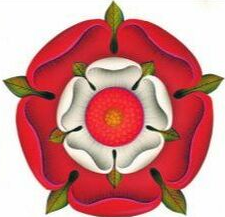 |
Anne Boleyn

Queen and Marchioness of Pembroke |
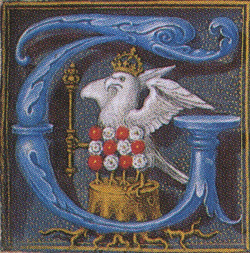 |
Anne's family
Anne Boleyn's family came to Norfolk probably at the time of the Norman Conquest. Their name has been spelled Buleyn, Bolen, Bulleyne, Bullein, Boleyne, Bolleyne, Boyleyn, Bowleyne, Boullan, Boulin, Bolina and Bulloigne (plus a rather odd Bulleux) but by far the commonest spelling is Boleyn - also, in Tudor times, Boulogne, in Normandy, was spelled Boleyn so Anne's ancestors may have come from there.Anne called herself Anne Bullen before she went to France but changed her name to Boleyn when she returned. Also, she was called 'Nan' by many people, especially those who disliked her (Nan was short for Anne in Tudor times) but she also called and signed herself using the Latin version of her name, 'Anna'. This was the name written on some of her portraits.
It's hard to know where to begin Anne's story so it's probably appropriate to start, in the 14th Century, with the men who substantially increased the family's wealth and social standing.
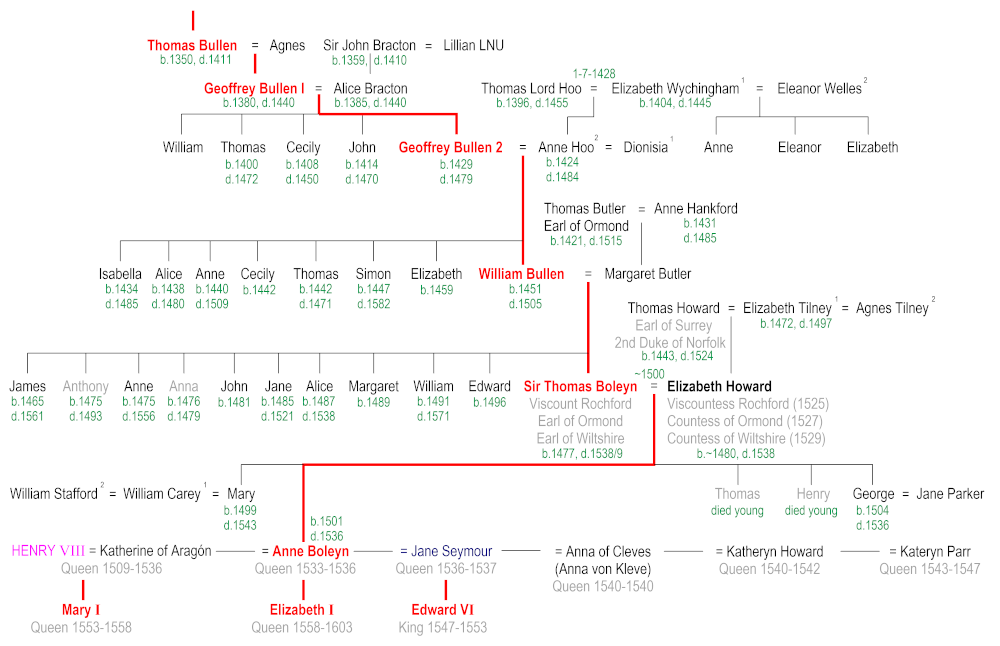
Thomas Bullen (b.1350, d.1411) was born in Norwich, married Agnes and was the father of Geoffrey Bullen 1.
Sir Geoffrey Bullen 1 (b.1380, d.1440) was born in Norwich, married Alice Bracton (b.1385, d.1440) and was the father of Geoffrey Bullen 2 (along with four other children).
Sir Geoffrey Bullen 2 (b.1429, d.1479) was a Norfolk gentleman who had a phenomenal career in the City of London. He was a hatter and then a mercer. He went on to be:
- Sheriff in 1446-7
- MP for London in 1449
- London elector in 1450
- Alderman in 1452
- Master Mercer in 1454
- Lord Mayor of London in 1457
Sir Geoffrey Bullen married Elizabeth Wychingham's Anne (b.~1424, d.1497) in 1445.
He was wealthy enough to lend the king £1,246 (today, about 1,000 times that) at a time when it was almost certain that he would never get it back. Even so, he bought two estates, both with moated castles, one in Norfolk and one in Kent.
In Norfolk, he bought Sir John Fastolf's manor at Blickling, in 1452.
(14 miles N. of Norwich and 127 miles N. of London).
In 1616, Sir Henry Hobart (pronounced Hubbard) bought the estate and completely rebuilt the house so there is no evidence of Anne being there now.
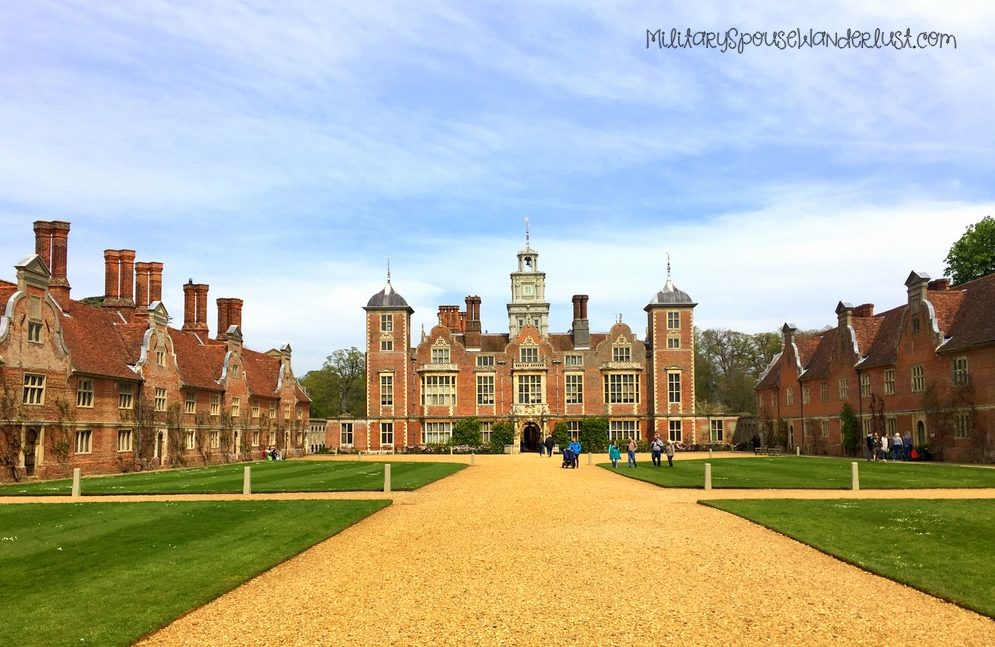
And in 1461 in Kent, Boleyn bought Hever Castle from William Fiennes Lord Saye and Sele.
(3 miles E. of Edenbridge and 39 miles SE. of London).
Hever had been built in about 1270 and John de Cobham crenellated it in 1383 and, over time, was altered in 1462 by Sir Geoffrey Boleyn, in 1501 by Elizabeth Boleyn (just a spiral staircase to Anne's bedroom), in 1540 by Anna of Cleves, in 1736 by Jane Waldo, in 1895 by Guy Sebright and in 1903 by William Astor.
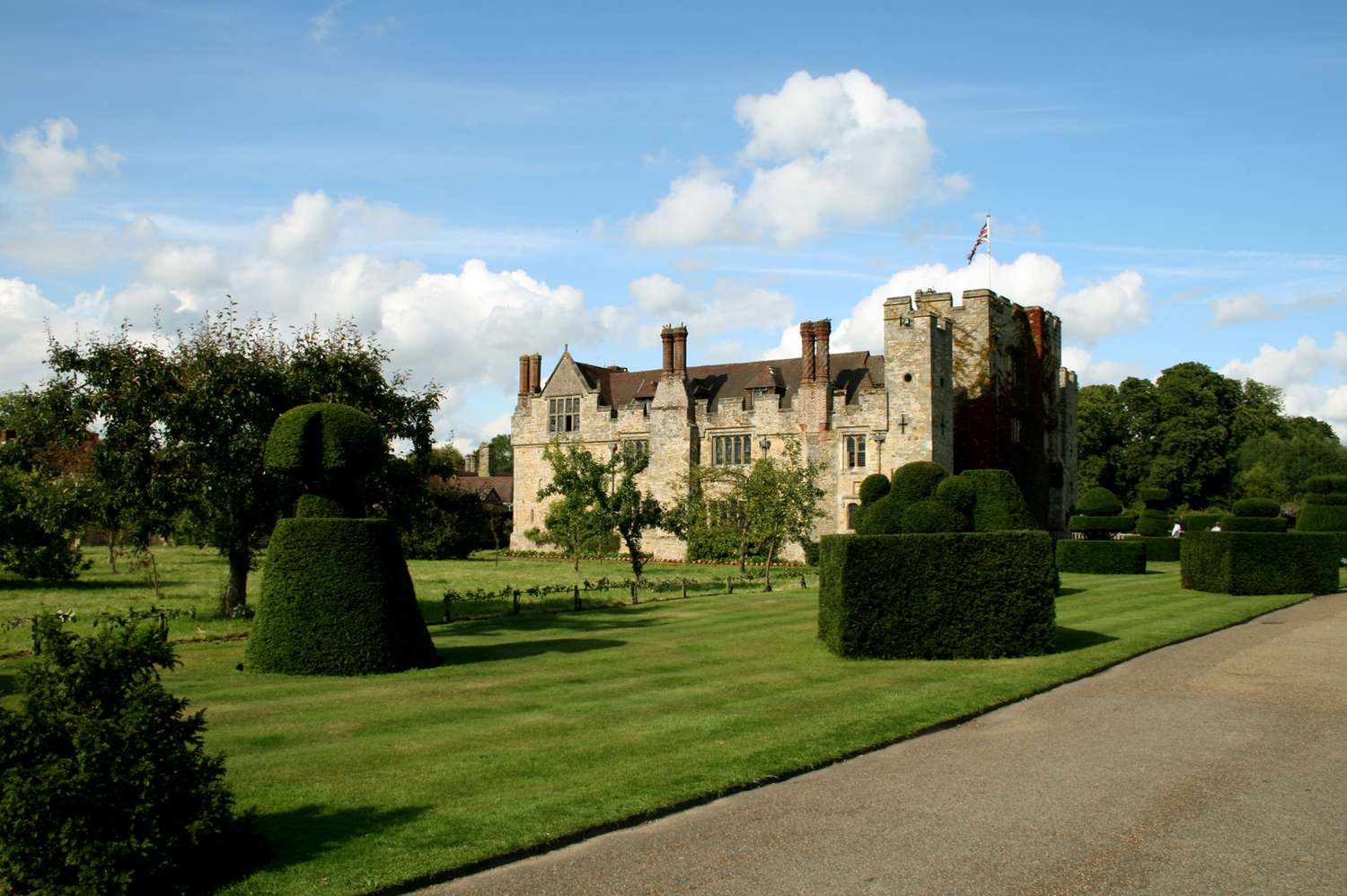
Hever was and still is a small, neatly planned, fortified house with three bedrooms - the residence of a wealthy landowner not a great magnate. It was surrounded by excellent hunting grounds and was much closer to London than Blickling which is in the middle of nowhere.
So a hugely wealthy city merchant married an aristocratic heiress. Their first son named Thomas died in 1471 and their second son, William, became the heir.
Sir William Bullen was a wealthy landowner in Norfolk. He made a spectacular marriage to Margaret, the daughter of Thomas Butler the earl of Ormond. Butler, like Hoo had not succeeded in producing a son and so, like Sir William's mother, Margaret was the co-heir to great estates.
So two generations of Boleyns had married aristocratic heiresses vastly increasing their wealth and their status.
Sir William and Margaret's son and heir Thomas Boleyn was born in 1477.
Elizabeth Howard was the eldest daughter of Thomas Howard, earl of Surrey, heir to the Dukedom of Norfolk. Thomas married her in ~1497. So Thomas now had a father-in-law who was a Duke.
Sir Thomas Boleyn and Elizabeth (née Howard) had three living children Mary (b.1500), Anne (b.1501) and George (b.1504) - two other boys, Thomas and Henry, died before they were ten. Anne was therefore descended from a former Lord Mayor of London and from dukes, earls and barons. This was a classy ancestry and an extremely wealthy one with huge estates and a number of impressive houses.
Thomas Boleyn and his family moved from Blickling Hall in Norfolk to Hever Castle in Kent in 1505 when Thomas's father William died.
| ≡ | ⇧ |
Anne's background
Anne was born in 1501 (or 1507 - click here for the arguments) to Sir Thomas Boleyn, 1st Earl of Wiltshire, and Lady Elizabeth (née Howard) at Blickling Hall in Norfolk but she spent much of her childhood at Hever Castle in Kent - from 1505 until she went to France in 1513.In 1513, Anne was sent to the court of Archduchess Margaret of Austria (which is now Belgium) basically for grooming and learning the skills, manners and niceties of life at court. Anne stayed at the Court of Savoy in Mechelen from spring 1513 until her father arranged for her to attend Henry VIII's sister Mary, who was about to marry Louis XII of France in October 1514. In France, Anne was a maid of honour to Queen Mary, and then to Mary's 15-year-old stepdaughter Queen Claude, with whom she stayed for nearly seven years.
In 1521, Anne came back to marry her Irish cousin James Butler but the 'deal' fell through and she came to England in early 1522. At some point, she joined Katherine of Aragón's court as a lady-in-waiting because she attended the Château Vert Pageant at Thomas Wolsey's residence on 4 Mar 1522.
Early in 1523, Anne was secretly betrothed to Lord Henry Percy, aide and secretary to Cardinal Thomas Wolsey and heir to the 5th Earl of Northumberland, but the betrothal was broken off when the 5th Earl refused to support their engagement (he didn't think Anne was well enough connected). Also, King Henry ordered Wolsey to refuse the match in January 1524 and Anne was sent home to Hever Castle. She hated Wolsey from then on and Percy went on to marry Mary Talbot, unhappily as it turned out.
In 1526, she had been at court for 4 years and was described as:
“the perfect woman courtier... her carriage was graceful and her French clothes were pleasing and stylish; she danced with ease, had a pleasant singing voice, played the lute and several other musical instruments well, and spoke French fluently... a remarkable, intelligent, quick-witted young noblewoman... that first drew people into conversation with her and then amused and entertained them.”
But she was also described as:
“pious and self-indulgent, in love with religion, the gospel and the church, and also with pomp, luxury and power; she was brittle, highly strung, neurotic, sarcastic and volatile.”
However, at the same time, she was”
“charming, gracious, vivacious, entertaining, clever, affectionate and dazzlingly charismatic.”
In short, her energy and vitality made her the center of attention in any social gathering.
And she certainly dazzled Henry ...
By 1527, Katherine was 42 and very unlikely to conceive again - Henry felt he should annul their marriage so that he could marry someone else but he had to tackle the Pope to achieve this.
Anne spent the first year of her involvement with Henry trying gently to dissuade him from pursuing her. She left court, refused to answer his letters, and told him flatly that she wanted to keep her virtue so she could make a good marriage. No one (including Anne) could ever have imagined Henry would try to set aside Katharine so he could marry a mere gentlewoman of his court. Such a thing just didn't happen, so it can't be attributed to some 'master plan' of Anne's to lure Henry away from his wife and make herself queen. During the first year, Anne was trying to get him to leave her alone because no other man would ask for her hand if the King was interested in her. His interest was actually harmful for her and within a decade, of course, it would be much more than merely harmful; it would be fatal!
In 1532, Henry made Anne the Marquess of Pembroke in her own right.
Anne refused to be Henry's mistress; she would only be with him as his wife so Henry fought 'the system' trying to break from Katherine until 1532 when he was secretly betrothed or married to Anne on 14 Nov. He married her formally, though bigamously, just before dawn on 25 Jan 1533. The new Archbishop of Canterbury, Thomas Cranmer, didn't formally pronounce Henry's marriage to Katherine null and void until 23 May 1533; five days later, he declared Henry and Anne's marriage valid.
As a result, Pope Clement VII excommunicated Thomas Cranmer and King Henry.
Anne was crowned on 1st June 1533 and was Queen (consort) of England until 19 May 1536. This was the route of her procession.
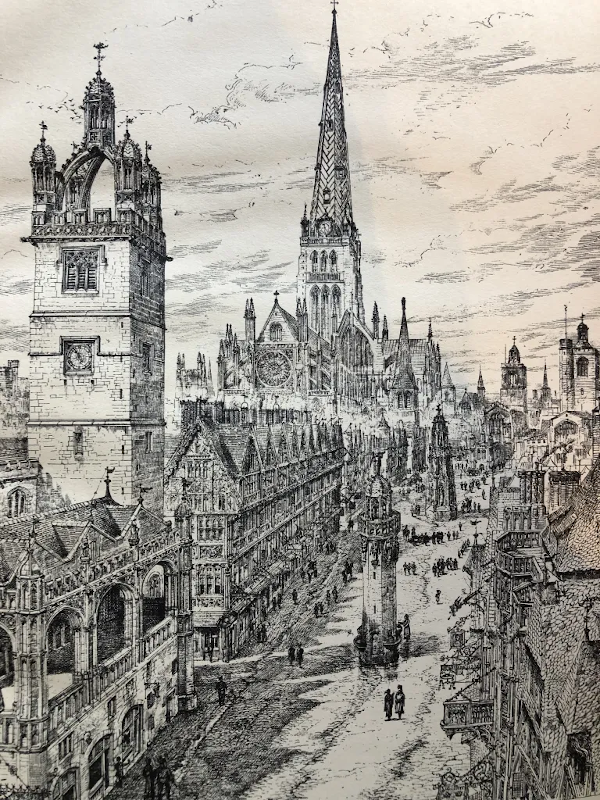
| ≡ | ⇧ |
Life Timeline
- In 1501
- Anne was born at Blickling Hall - her father said as much.
- In July 1536, Thomas Boleyn wrote to Thomas Cromwell stating "When I married I had only £50 a year to live on for me and my wife as long as my father lived, and yet she brought me every year a child". (That would be Mary 1500, Anne 1501, Henry 1502, Thomas 1503 and George 1504. Only Mary, Anne and George survived to adulthood.)
- In 1505
- Anne and her family moved to Hever Castle on the death of her grandfather, William.
- In 1513
- Anne went to Austria - now Belgium.
- In 1514
- Anne moved to France (Queen Claude).
- In 1520 (Jun 7)
- Henry visited Francis I and probably saw Anne but he didn't take much notice of her.
- In 1521
- Anne returned to marry James Butler in Ireland but Thomas Wolsey and her father didn't approve and, anyway, she was attracted to Henry Percy.
- The Boleyns thought the Butlers were beneath them.
- In 1522 (Mar 1)
- Henry noticed Anne at the Château Vert Pageant on Shrovetide.
- She played 'Perseverance'
- In 1523
- Anne became betrothed to Sir Henry Percy but this was stopped in 1524 and she was sent back to Hever for the best part of a year.
- The Percys thought the Boleyns were beneath them
- (People ask why no plans were made for Anne's marriage between 1522 and 1526 — that's why)
- In 1524
- Henry and Katherine ceased to have sexual relations.
- In 1525 (summer)
- Henry attempted to build up Richmond (Henry Fitzroy) as the alternative heir.
- In 1526 (Feb or Mar)
- Henry starts to woo Anne and he sends her a bracelet with a picture of him in it.
- In 1526 (mid)
- Anne left court and returned to Hever for about a year.
- In 1526 (mid)
- Henry's first letter to Anne.
- (In this first love letter, written after Anne left court, Henry sends Anne a hart he killed the previous evening).
- In 1527 (Easter)
- Henry presses Anne to become his “maîtresse en titre”.
- In 1527 (May)
- Preliminary annulment hearing in secret.
- In 1527 (summer)
- Henry proposed to Anne and she agreed by sending him a ship with a diamond in the bow.
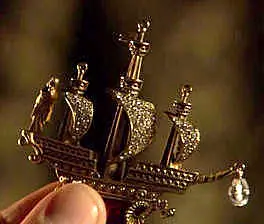
This is a depiction
- In 1527 (Jun)
- Decision to ask the Pope for a dispensation to free Henry to marry Anne.
- From Spring 1527 to Autumn 1528
- Henry wrote many love letters to Anne
- (amazingly, 17 of them survive in the Vatican Library).
- If Anne had already agreed to marry Henry why does he keep writing to her?
- In 1528 (Jun)
- Thomas and Anne fled to Hever with the 'Sweating Sickness'.
Mary's husband, William Carey, died of it.
- In 1532 (Nov 14)
- It's thought Anne slept with Henry for the first time after returning from Calais with the implicit approval of Francis I.
- In 1533 (Jan)
- Anne's formally, but still secretly, married to Henry.
- In 1533 (Jun)
- Anne's formally crowned Queen (consort) of England.
- In 1533 (Sep)
- Anne gave birth to Elizabeth.
- On 1536 (May 2)
- At Greenwich, Anne's was accused of adultery, incest and treason.
- On 1536 (May 15)
- Anne's was tried and unanimously found 'guilty' by a jury of 26. George was tried and found guilty on that day as well.
- (The jury included Henry Percy and her uncle, the Duke of Norfolk. Her father, Thomas, had been excused although he had had to serve on the commission of oyer and terminer).
- On 1536 (May 19)
- Anne was brutally executed on Tower Green (inside the tower enclosure).
She was unbelievably brave.
There can be no certainty about much of this as there is so little evidence on record of the timing or the detail. However, it does fit the context and it is psychologically credible. Also 'since 1 August in the year aforesaid' until the following May (and only one year is logical) there is a long list of items of rings, brooches, bracelets, diamonds and rubies which Henry bought for Anne.
A number of pieces like this have been found - such as a whistle in the form of a pistol given by Henry to Anne Boleyn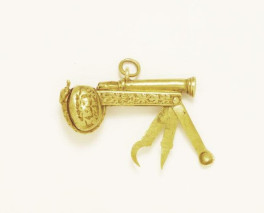
Now held in Rm 58e of the British Galleries in the V&A
and a pendant given by Henry to Katherine of Aragón
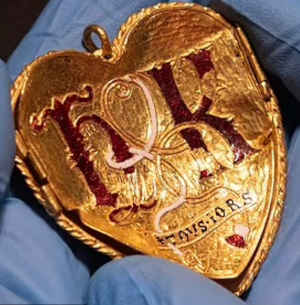
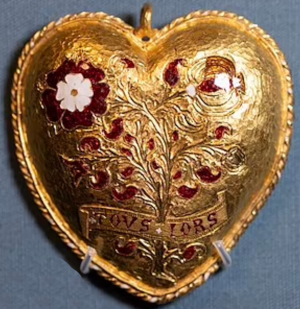
Now held in the British Museum
Ribbon motifs carry the legend TOVS and IORS, which have been called 'a beautiful early Franglais pun' on the French word “toujours” and the English word “yours”
| ≡ | ⇧ |
Anne's reputation
Complimentary descriptions:- Brilliant, charming, driven, elegant, forthright and graceful, with a keen wit and a lively, opinionated and passionate personality.
- "Sweet and cheerful" in her youth and enjoying cards and dice games, drinking wine, French cuisine, flirting, gambling, gossiping and good jokes.
- Fond of archery, falconry, hunting and the occasional game of bowls.
- Patron of the arts and loved illuminated books.
- But had a sharp tongue and quite a temper.
Before becoming Queen, Anne was
- admired for her style of fashion
- always different
- her designs were always spectacular
- clean and with a great taste
- centered in the glamour of the French Fashion.
- her favourite color was green
- and her favourite jewels, were pearls
- she made sure always to have those two favourites in her designs.
Thomas Cromwell described her as being “intelligent, spirited, courageous”.
Damning descriptions:Despite the compliments. Anne was unpopular with the people of England at large, especially the women, who resented this 'goggle-eyed whore' usurping the place of their much-loved Queen Katherine (c.v. Charles, Camilla and Diana in 2005) and she was perceived to be overbearing and abusive of her position as well as being responsible for:
- the harsh and rigorously enforced laws that had been passed in recent years
- promoting heresy and radical religious change
- the deterioration of England's relations with other European powers
- the slump in hitherto-lucrative trade with the Empire.
- When Elizabeth was assigned her own household in December 1533, Anne vindictively insisted that Mary be made to wait on her; a protesting Mary found herself treated little better than a servant. (When Katherine of Aragón died on 7 Jan 1536, Anne did make huge efforts to correct this, but Mary rejected them and never recognised Anne as Queen).
- In 1531, a mob of seven thousand had descended on the London house in which Anne was dining, and had she not made a rapid escape by barge, they would probably have lynched her.
- Anne had been hissed at in several villages whilst accompanying the King on a progress and had, at length, been obliged to turn back.
- By 1532, some MPs had taken to meeting at the Queen's Head tavern, just off Fleet Street, to plot ways of opposing the King's plans to marry her.
- When she first appeared as queen, going in state to chapel at Easter 1533, there was dismay and consternation at court and a torrent of public protests.
- One London congregation, when asked to pray for this woman who was 'the scandal of Christendom', walked out in disgust 'with great murmuring and ill looks', while a priest who preached in favour of the marriage in Salisbury 'suffered much at the hands of women' for doing so.
- A parson in Lancashire indignantly asked, "Who the devil made Anne Bullen, that whore, queen?"
- People in general were 'greatly agitated' at Anne's elevation to queenship, and a priest, Ralph Wendon, who had been hauled before the justices in 1533 for calling her 'a whore and a harlot' was only voicing the opinions of many.
- Some people were even calling for the 'common stewed whore' to be burned at Smithfield.
- At her coronation in June 1533, Anne passed in procession through largely silent, hostile crowds, while some sneered 'Ha! Ha!' when they saw the entwined initials of Henry and Anne on the decorations.
- In 1534, the Act of Succession made it treason to impugn the King's marriage to Anne and their issue.
- In October 1534, the French ambassador informed Francis I that "the lower people are so violent against the Queen that they say a thousand ill and improper things against her, and also against those who support her in her enterprises".
- Chapuys was more happy than most to be able to report evidence of Anne's unpopularity, but although he was biased, he was probably not exaggerating, for throughout the years 1533 to 1536, official records and other sources contain numerous instances of people being arrested for uttering opprobrious words about the Queen.
Responses:
- A 'fraudulant' Queen
- Not really her fault. Henry had been chasing her for 6 years and married her, bigamously, 4 months before his marriage to Katherine of Aragón was annulled.
In 1535, the unpopular Anne was perceived to be responsible for the executions of the much-respected Sir Thomas More, John Fisher, Bishop of Rochester and several Carthusian monks all of whom had refused to acknowledge the validity of her marriage; this was the final straw for many conservatives. - Unkind to Mary
- Unnecessary but understandable as Mary said she would only recognise her own mother as Queen - and always did. But the evidence also clearly demonstrates that the threats (against Mary) were borne out of sheer frustration and distress, rather than hatred. On three separate occasions, after Katherine of Aragón's death, Anne tried to take Mary back into the fold.
- Acted above her station.
- She was entitled, but a little tact and fewer remonstrations would have helped. She had been insolent towards the older nobility, who detested her; the Imperialists hated her because she was the staunch friend of the French, had supplanted Katherine of Aragón, deprived the Lady Mary of her rights, and entertained what they regarded as heretical views. She had become a target for political opposition, for she had also made enemies of those whose influence she had overridden, or who were opposed to the radical religious reforms she had enthusiastically promoted
- Pushed Protestantism
- She had no wish to abolish Catholicism, merely to reform it; she and many others wanted the ordinary people to be able to understand and follow their faith in English or French, not just Latin.
- Empire, not France
- This gave access to a much bigger market. Cromwell was a Francophile; Anne was more attuned to the larger markets of the Empire.
- An adulteress
- Anne had been more accused than convicted of adultery.
What none of them seemed to recognise was that the two lines of accusation against the Queen - the one to prove her marriage invalid and the other to prove her adultery - were incompatible.
The accusations against her had been fabricated; the trial had been rigged; the whole process of her condemnation and murder was utterly disgusting and even Henry showed some remorse about it all on his deathbed - and we're still talking about it nearly 500 years later. • The very day of Anne's beheading, Henry went to see Jane Seymour in Chelsea;• The next day he was betrothed to her;
• Only 10 days after that, he married her.
- Anne was fervently in love with Henry
- • She was actually just an object of his desire.
- • In Many ways, Anne hadn't wanted to marry the King but she was a strong promoter of the Protestant faith and needed the best vantage point from which to support them. And what better place than being Queen.
- • Also she didn't want to be just a King's mistress like her sister - they tended not to last very long and, anyway, she was Maid-of-Honour to Katherine, the Queen Consort at the time. This is why she held Henry off for seven years and even left him for a year (in 1527-28) before agreeing to be Queen.
- Anne was a bad mother who sent her daughter away:
- • It was Tudor practice to send children away but Anne fought to wet nurse Elizabeth and educate her. She even asked for her to be brought from Hatfield to Eltham, only 5 miles away, so she could see her more often.
- • The moment Elizabeth was born, it wasn't Anne's fault; it was God's fault. But Henry blamed Anne anyway - the 'devalue' phase of a sociopath's obsession started.
- When Mary (Katherine's daughter) married considerably beneath her, just for happiness and not duty, Anne threw her out of court.
- • Later, Anne realised she was wrong and invited Mary back and even helped her when in confinement for her pregnancy.
- • Mary blamed Anne for all the machinations.
- Anne is accused of celebrating Katherine's death dressed in yellow.
- • She did not, but Henry did. He'd finally got rid of the staunch Catholics who wouldn't relinquish the throne. Sociopath, therefore no conscience. As it happens, yellow is a colour of celebration and joy in Enland, but mourning in Spain.
- Anne is accused of poisoning Katherine.
- • Katherine's heart was black; she probably died of cancer.
- • While Anne was pregnant (again hoping for a boy) Henry was wooing Jane Seymour who was a strong Catholic.
- • Katherine's death made Anne's detractors more powerful and dangerous so why would Anne poison Katherine?
- Anne lost her second baby as comeuppance for celebrating Katherine's death:
- • Anne had a fire in her bedroom (reported by Lancelot de Charles in early/mid Jan)
- • Anne was slowly losing Henry to another mistress (Jane Seymour)
- • Anne had her husband badly hurt in a jousting accident (24 Jan)
- • She had a miscarriage (29 Jan).
- Anne accepted a 'dangerously radical' English translation of "Ferago Rerum Theologicarum" by Tristram Revel:
- • The book denied the sacrifice of Mass
- • Archbishop Cranmer, Edmund Archdeacon of Canterbury, Hugh Latymer and William Latimer had all refused to acknowledge this book but only Anne was scorned for so doing.
- Anne is not credited with creating the The Poor Law.
- • It was funded by the dissolution of the monastries and the Crown and backed by both Anne and Henry but was deemed too expensive.
- • Oddly, Cromwell had 'Poor Law Light' ready and waiting and it was adopted. It had no income tax in it and no council to run it. Cromwell saw 333 of his proposed laws passed yet this one, proposed by William Marshall and backed by Anne, failed. Cromwell failed to renew it in 1539. It was obvious that he didn't want it but it's still wrongly called Cromwell's Poor Law instead of Anne's much more dramatic Poor Law, much of which Elizabeth I did enact in 1601. Anne realised Cromwell had been against, not pro, her. He scuppered her attempt to get the small monasteries used for shelter and education.
- Anne asked all the clergy to preach use of the smaller monasteries for education.
- • And they came to her asking for protection.
- • They actually wanted to work WITH her.
- Anne had to embark on fight or flight.
- • She chose courageously to fight
- • Anne wanted merely to overpower Cromwell; Cromwell wanted to kill Anne.
- Henry was plotting Anne's death:
- • He was desperately trying to get Philip II (of Spain) and Charles V (Holy Roman Emperor) to agree with Britain.
- • Francis I (of France) had a papal decree denying Henry power over the church and Charles V might add to it. Henry was deep in council discussions on how to play the hand
- • Henry's marriage was about politics, not love.
- Henry didn't love Anne any more
- • Six days before her arrest, Henry sent a message to the ambassador of Rome, Richard Pate, affirming the "likelihood God will send us heirs male" with "our most dear and most beloved wife, the queen". Or was this just bluster for the public?
- Anne was accused of flirting with Henry Norris just before her arrest.
- • She wasn't flirting him at all; she was goading him into telling her the truth about him not wanting to marry Margaret Shelton (her cousin)
- It's said that Anne's father Thomas was part of the team that condemned her to death
- • He was on neither the Middlesex or Kent-based oyer and terminer†††.
He'd been taken off them for obvious reasons. - Anne had written a letter to Bridget Wingfield (lady-in-waiting to Anne) who had died 2 years before. It said "I pray you leave your indiscrete trouble both for displeasing of God but also for displeasing of me".
- • This was given in evidence that Anne had had an affair ('indiscrete trouble')! But it was written in 1532, a year before Anne married Henry, and she wouldn't have risked the Crown for an affair with anyone, never mind put details of it on paper.
Also, it's illogical because Anne was writing about Bridget's 'indiscrete trouble' - not her own.
(Bridget Wiltshire became Bridget Wingfield, then Bridget Hervey, then Bridget Tyrwhitt finally dying in 1534) - Anne's household were bribed to work against her whilst being assured that Henry hated her for not providing a male heir.
- • This was all to amass damning (false) evidence to present at her trial
- • How amazing that Anne managed to keep the timetable for all her supposed affairs secret until the one moment when evidence was required!
- • None of her ladies, who would have known about any affairs, was ever accused. In fact, they went on to serve Jane.
- • Katheryn Howard's lady had been executed in similar circumstances.
- • And if she'd had a child as a result of an affair, the baby wouldn't have been a redhead. Oops.
- Anne admitted her guilt on the scaffold
- She did say (pretty much the following):
"Good Christian people, I have not come here to preach a sermon; I have come here to die. For according to the law and by the law I am judged to die, and therefore will speak othing against it. I am come thither to accuse no man, nor to speak of that whereof I am accused and condemned to die, but I pray God save the king and send him long to reign ver you, for a gentler nor a more merciful prince was there never, and to me he was ever a good, a gentle and sovereign lord. And if any person will meddle of my cause, I require thee to judge the best. And thus I take my leave of the world and of you all, and I heartily desire you all to pray for me."
(This apparent kindness was probably to protect her daughter after he death) - She didn't say (as reported by a very unreliable Portugese man)
"Alas, poor head! In a very brief space thou wilt roll in the dust on this scaffold; and as in life thou didst not merit to wear the crown of a queen, so in death, thou deservest not a better doom than this.
And ye, my damsels, who whilst I lived, ever showed yourself so diligent in my service." - • Foreigners were not allowed to witness executions
- • The ladies who watched the execution were not the ladies who attended her
- Anne entered the Tower through Traitor's Gate (see Tower of London blurb)
- • She, as Queen, entered through the Court, sometimes called the Byward, Gate.
| ≡ | ⇧ |
Contemporary images
As far as anyone knows, there are no surviving contemporary portraits of Anne. Henry VIII endeavoured to have all representations of her destroyed after her execution and anyone who had a painting of her on their wall (to show loyalty to the monarch) soon got rid of it.
Any of the known portraits of her may be a reasonable 'likeness' but they were all painted after her death and, in some cases, quite a long time after her death.
There is a lead medal which was struck in 1534 in anticipation of Anne giving birth to a son. On it, the nose is damaged, probably deliberately and, as she miscarried, no copies of the medal were made.
It is enscribed “A.R. THE MOOST HAPPI ANNO 1534”
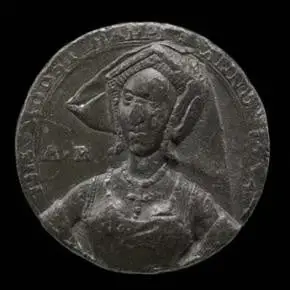
British Museum, Gt Russell St, London, WC1B 3DG
(020) 7323 8000
This is a detailed survey Lucy Churchill made of the medal to make ...
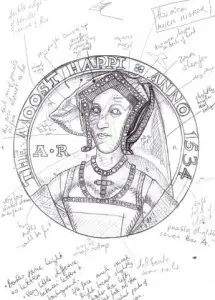
... a replica, duplicates of which may be purchased.
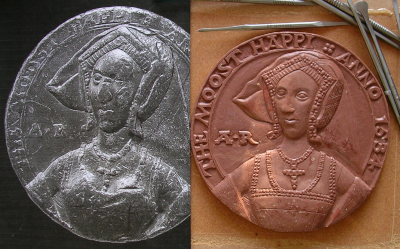
Lucy Churchill, 111 East Parade, York, YO31 7YD
| ≡ | ⇧ |
There is a ring, worn by Queen Elizabeth I, which has a miniature of her in it and this, although very small, may be assumed to be a reasonable likeness of Anne.
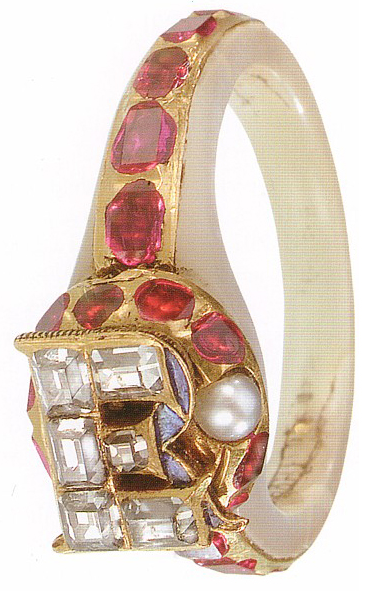
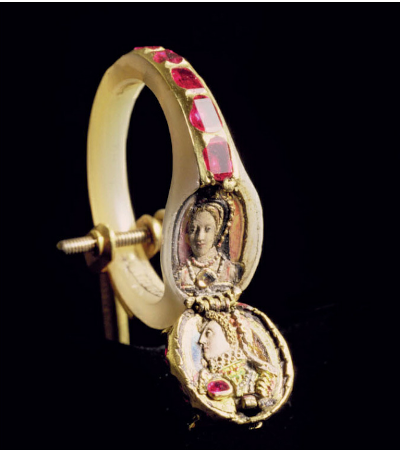
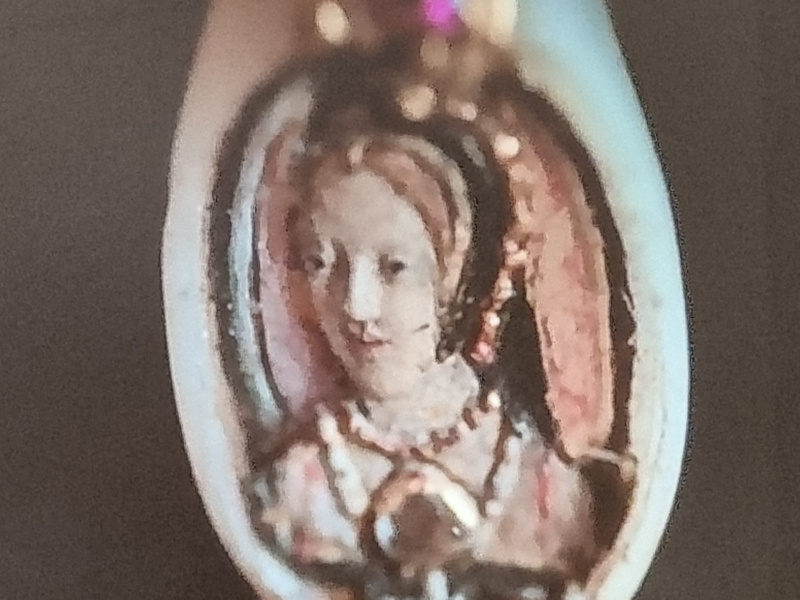
The ring is one of the few surviving pieces of jewelry worn by Queen Elizabeth I. It was given to Alexander Home, 1st Earl of Home (c. 1566-1619), possibly by King James I, and it descended through the Home family until it was acquired by Arthur Lee, 1st Viscount Lee of Fareham (1868-1947). Lee gave his house (Chequers), and its collection, to the nation. The ring is still at Chequers.
The Trustees of Chequers, Missenden Rd, Aylesbury, HP17, 0UZ
| ≡ | ⇧ |
There is also a contemporary picture of Anne on the seating plan for her coronation. But it is decidedly cartoonish!
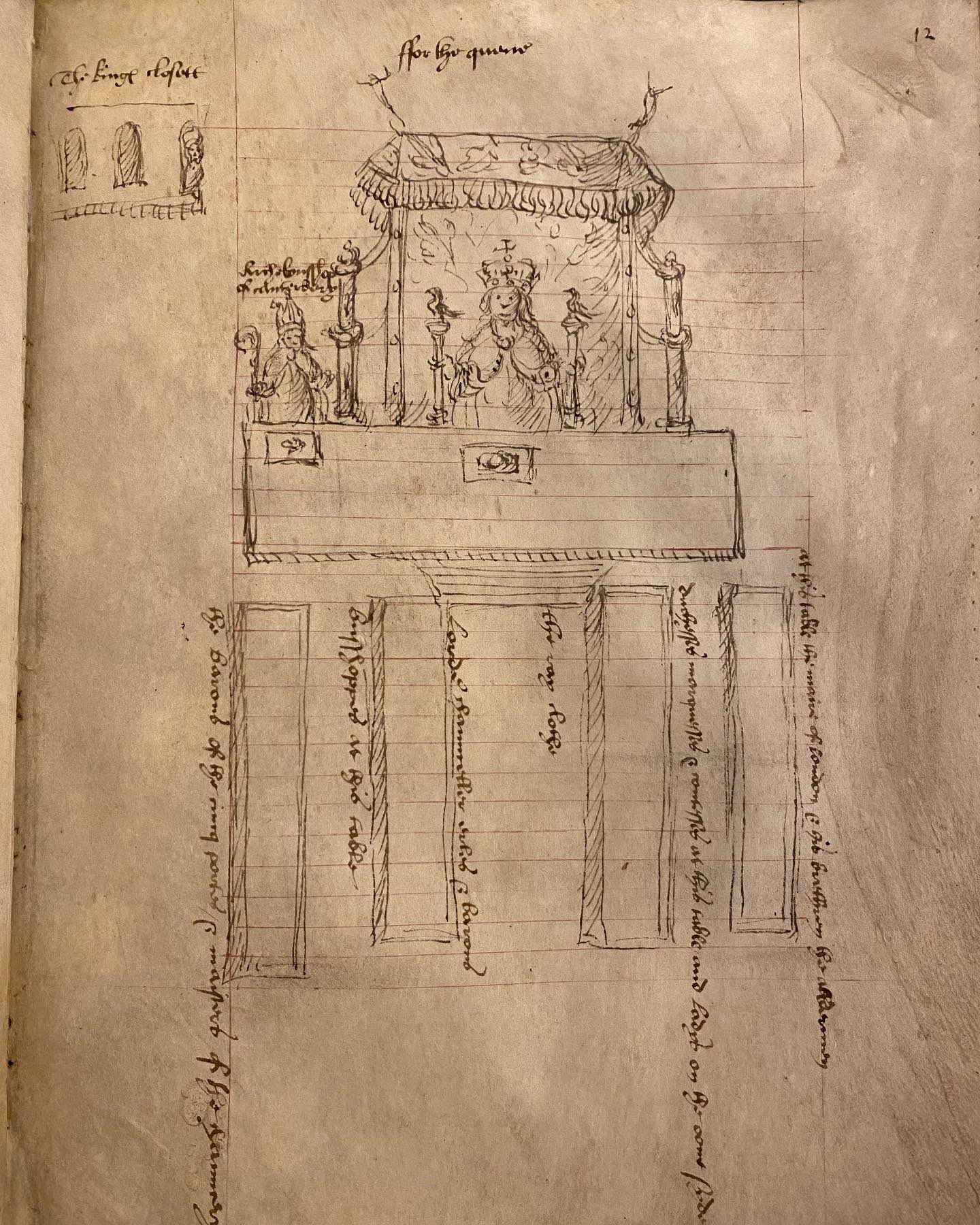
British Library, 96 Euston Rd, London, NW1 2DB
(0330) 333 1144
| ≡ | ⇧ |
NPG portraits
The most famous painting is in the National Portrait Gallery (No 668) - it was painted by an unknown English artist in the late 16th century - dendochronological analysis shows the tree used for the timber panel was felled later than 1584. No one knows what the source was but it was probably part of a set drawn from a pattern drawn from the living person.
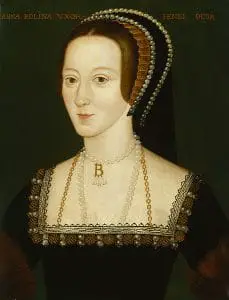
Another painting in the National Portrait Gallery (No 4980(15)) was almost certainly painted from the same pattern
.png)
Here are the two paintings viewed under Infrared Reflectography (IRR)
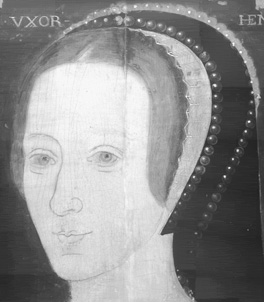 |
_irr.jpg) |
National Portrait Gallery, St Martin's Pl., London, WC2H 0HE
(020) 7306 0055
No D24936
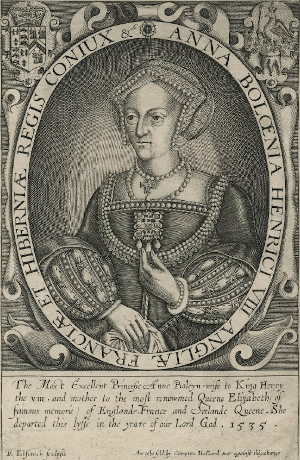
By Reynold Elsrack. Henry Holland, Bazilowlogia (1618). Given by the daughter of compiler William Fleming MD, Mary Elizabeth Stopford (née Fleming), 1931
No D33817
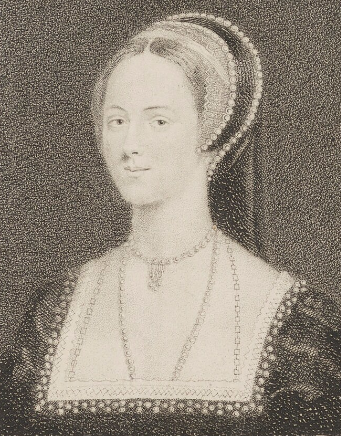
by William Nelson Gardiner, published by Edward Harding, after Silvester (Sylvester) Harding, after Unknown artist. Stipple engraving, published 1790
No D24175
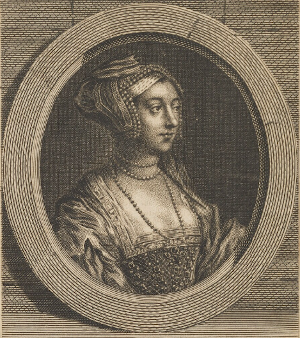
after Hans Holbein the Younger. Line engraving, probably 18th century. Given by the daughter of compiler William Fleming MD, Mary Elizabeth Stopford (née Fleming), 1931
No D48133
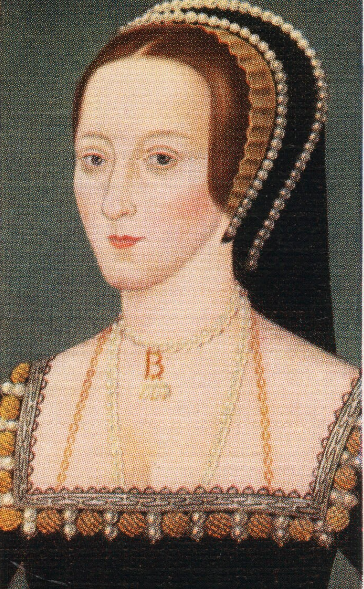
published by John Player & Sons, after Unknown artist. Colour relief halftone cigarette card, 1935
No D21020
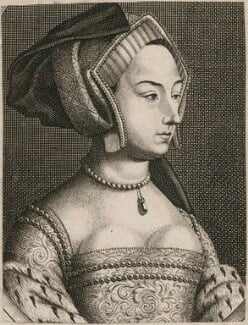
Unknown woman formerly known as Anne Boleyn probably by Robert White, after Hans Holbein the Younger line engraving, published 1681?
| ≡ | ⇧ |
Other portraits
Artists' impressions of how Anne may have looked (and copies of them) can be found in several places. These 'likenesses' were all made from memory, from previous paintings or from verbal descriptions which will have come from people who may have been very pro or very anti Anne so should not be trusted.
| ≡ | ⇧ |
This one is in Blickling Hall. It is said to be of Anne when she was about 14 years old. So it wasn't painted at Blickling Hall but it is now kept there.
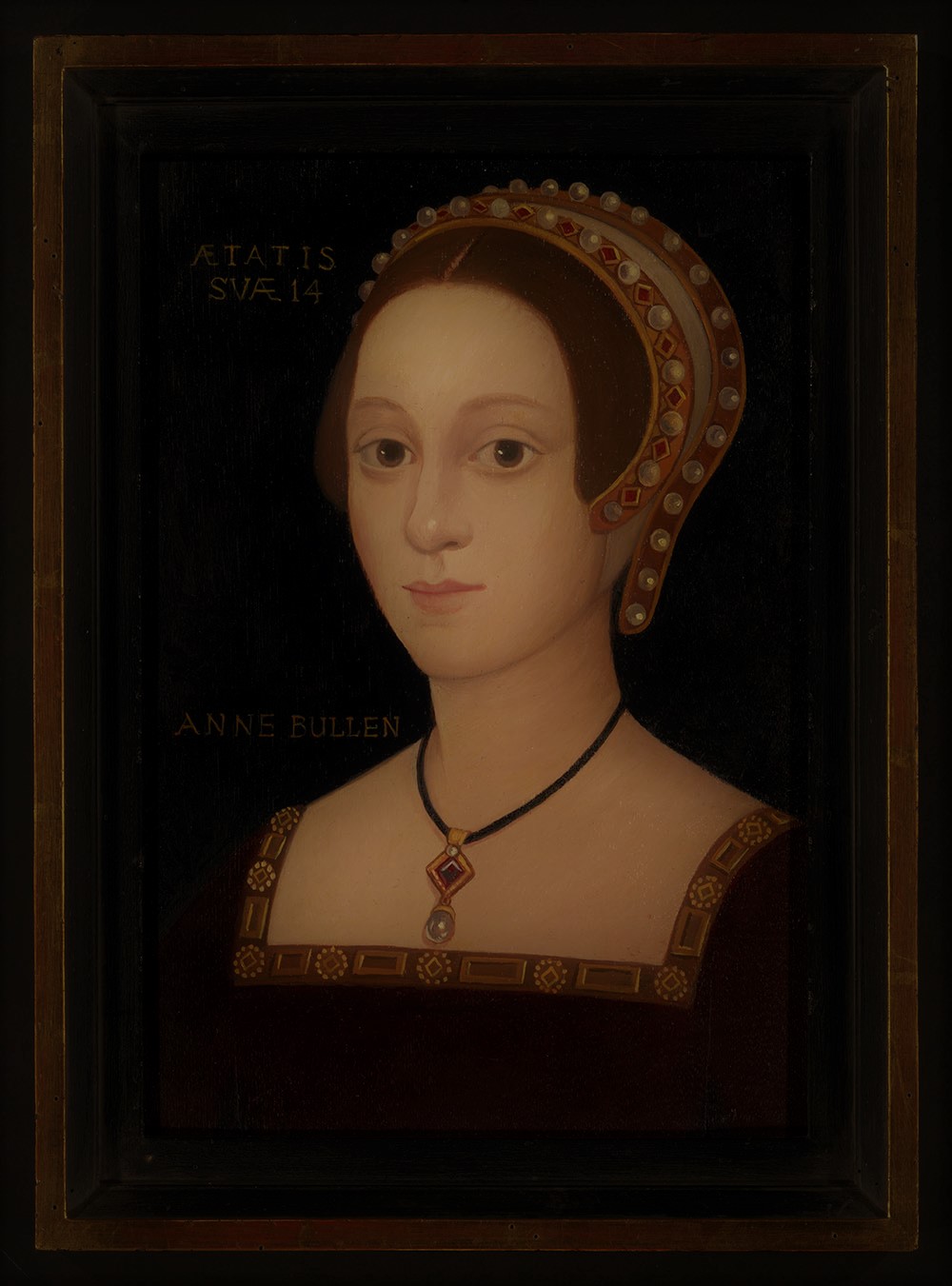
From Blickling Hall in Norfolk
| ≡ | ⇧ |
There is a fascinating one at Château de Beauregard in the Loire Valley from the French School (1650-1800)
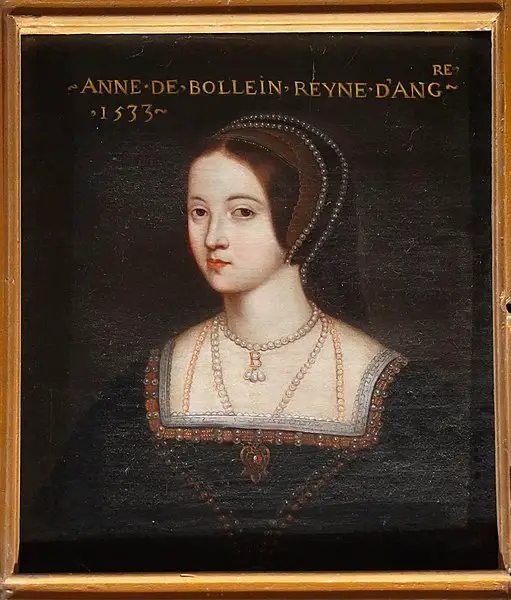
(At Beauregard, there are 327 copies of portraits from French and European galleries including ones for King Henry VIII, Queen Elizabeth I, Queen Mary I, Sir Thomas More, King Henry VII, Robert Dudley and Robert Cecil)
576-578, Beauregard, 28330 La Bazoche-Gouet, France
0033 2 54 70 41 65
| ≡ | ⇧ |
This is the Anne Boleyn 'Hever Rose' portrait painted by an unknown English artist in about 1550. Again, no one knows what the source was. The painting hangs at Hever Castle on the left of the fireplace in the Inner Hall.
This is it before any restoration was done and it has a considerable amount of over-painting on it.

This is it with all the over-painting removed and it shows the damage caused by the wooden backing panel splitting.
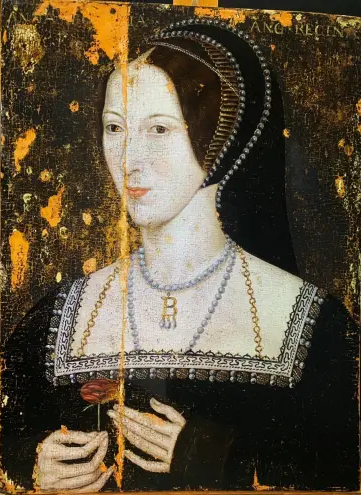
This is it fully restored.
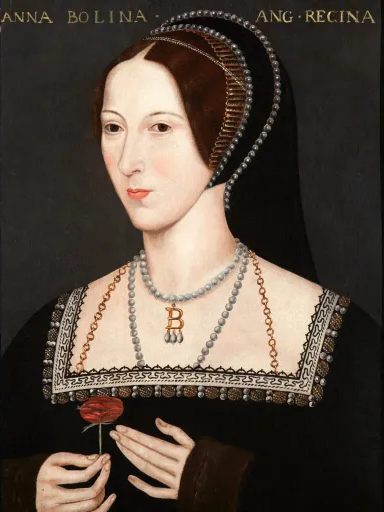
Hever Castle, Hever Rd, Edenbridge, TN8 7NG
(01732) 865 224
| ≡ | ⇧ |
On the right of the fireplace is a portrait of Mary Boleyn - Anne's elder sister.
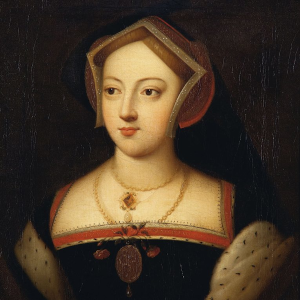
The original is in the Royal Collection and there are twelve known copies
NB: Neither Mary I (Bloody Mary), Elizabeth I nor Edward VI had any children so King Charles III line of succession comes down from William I, Henry I, Henry II, Henry III, Edward I, Henry VII, James IV (of Scotland), James VI (of Scotland), Mary Stewart (Queen of Scots), James I, George I, George II, George III, George IV, Victoria, Edward VII, George V, George VI, Elizabeth II.
But also:
• Charles descends from Mary Boleyn via the Careys, the Knollys, the Boyles, the Cavendishes, the Bentincks and the Bowes-Lyons to Elizabeth II.
• Camilla descends from Margaret Boleyn (Thomas's sister) through the Ashburnhams, the Derings, the Southwells, the Keppels and the Cubitts to the Parker-Bowles.
• Diana descende from Mary Boleyn, through the Careys, the Mordaunts, the Poynts and the Spencers.
• Katherine descends from Mary Boleyn, the Careys, Elizabeth Knollys ...
A sketch of Mary by Holbein.
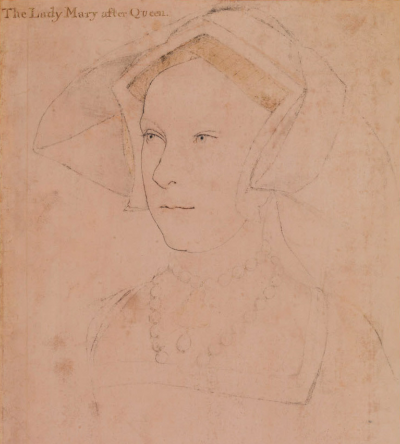
Hever Castle, Hever Rd, Edenbridge, TN8 7NG
(01732) 865 224
| ≡ | ⇧ |
This is a portrait of Anne at Petworth House (NT). The painting was produced in the 18th Century and is logged with National Trust ID 485054
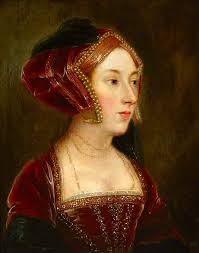
The painting is on loan from the Egremont private collection.
Petworth House, Petworth, W. Sussex, GU28 9LR
(01798) 342 207
| ≡ | ⇧ |
Holbein sketch.
Holbein did another sketch which it is thought was in preparation for doing a full portrait. It was a study of her face and may have been done about the time that she was going into confinement.
[Anne was meticulous about her appearance; it's hard to imagine her sitting for even the preparation of a portrait in a 'night' gown and simple cap. It also seems unlikely that Henry would woo Anne for 7 years if she looked like this. The picture is more likely of someone else - it is known that the 'Anna Bollein Queen' wording was added later by John Cheke, 1514-1547, (tutor to Edward VI and Princess Elizabeth). He is reputed to have known Anne quite well although it was, of course, several years earlier. RDP]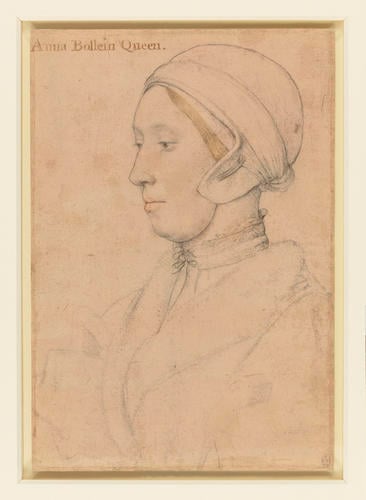 Recto |
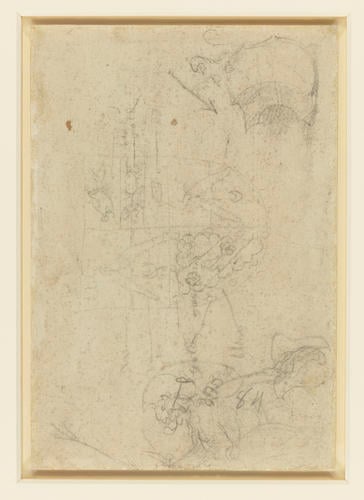 Verso |
Royal Library, Windsor Castle, SL4 1NJ [RCIN 912189]
| ≡ | ⇧ |
A miniature portrait by John Hoskins.
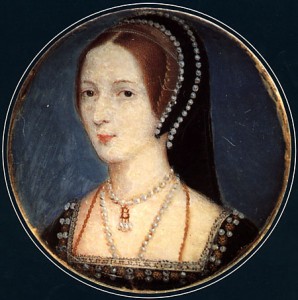
It dates to the 17th century, but historian Eric Ives believes that Hoskins based it on an earlier contemporary portrait. He believes that Hoskins had access to a now lost full-length portrait of Anne Boleyn, which is thought to have been painted by Hans Holbein the Younger. Holbein was known for painting in meticulous detail and this sketch is said to be of Anne as well.
Collection of the Duke of Buccleuch and Queensbury
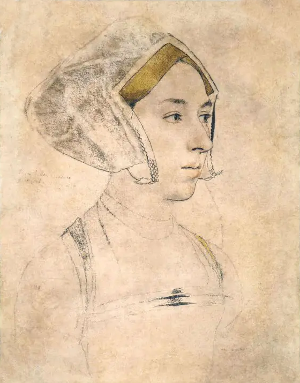
Ives describes the Hoskins painting as “the best depiction of Anne we are ever likely to have, failing the discovery of new material”. It's certainly like the one hanging in her childhood bedroom at Hever Castle.
It is known that the portrait was in the possession of John Lumley, 1st Baron Lumley, in 1590 and that it existed as late as April 1773 when it was sold. It has since disappeared. But see 'Best Portrait' below.
British Museum, Gt Russell St, London, WC1B 3DG
(020) 7323 8000
| ≡ | ⇧ |
One is in Nidd Hall. It is said to have been painted from the lead medal and therefore may be thought of as a reasonable likeness although, on the medal, her face is only 16mm high.
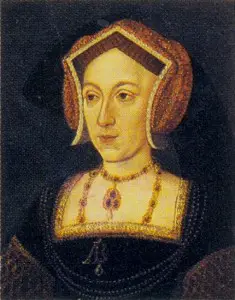
Private collection. Nidd Hall, Harrogate, N. Yorkshire, HG3 3BN. Courtesy Bradford Art Galleries and Museums
(0330) 135 9576
| ≡ | ⇧ |
An image, supposedly of Anne.
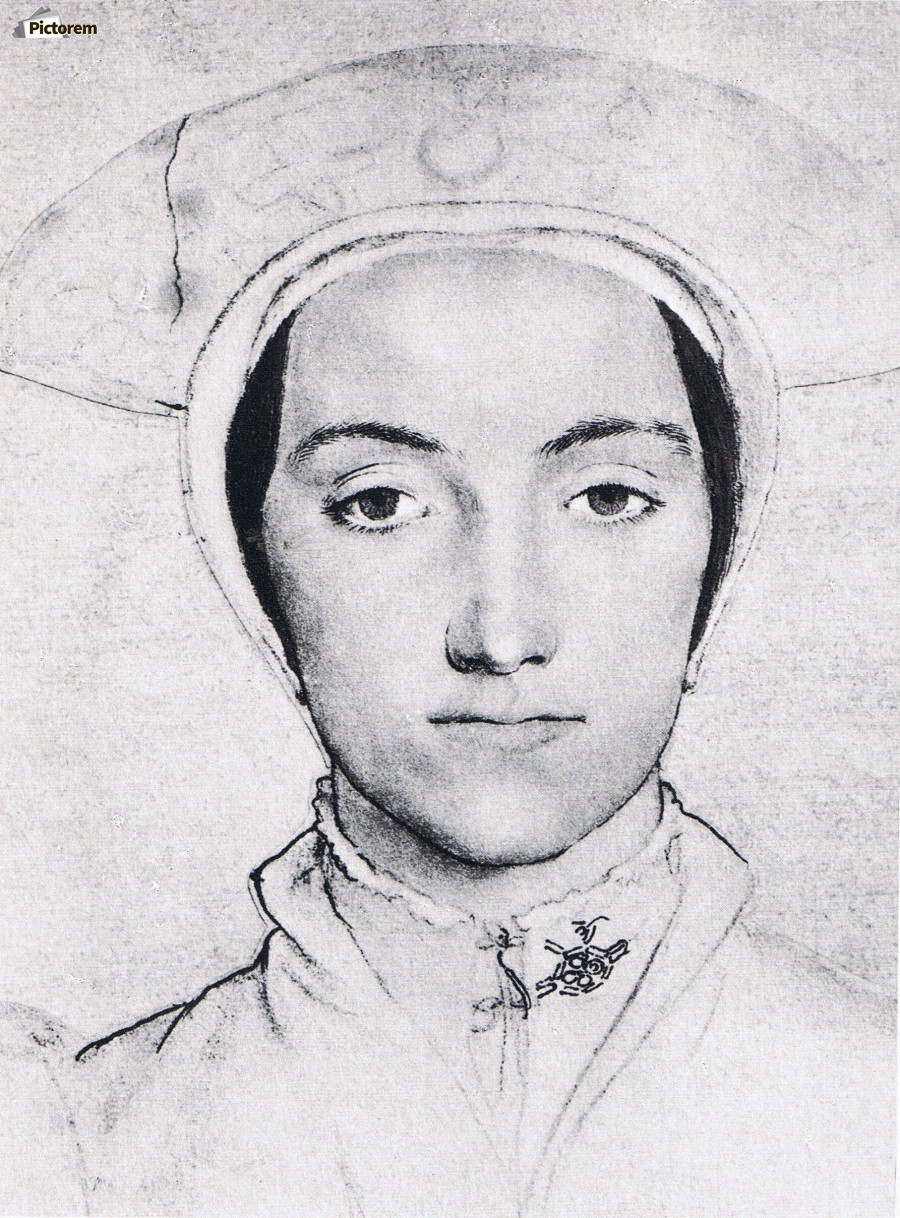
Painting by Hans Holbeing Jnr
| ≡ | ⇧ |
A portrait of Anne hanging in her childhood bedroom at Hever Castle
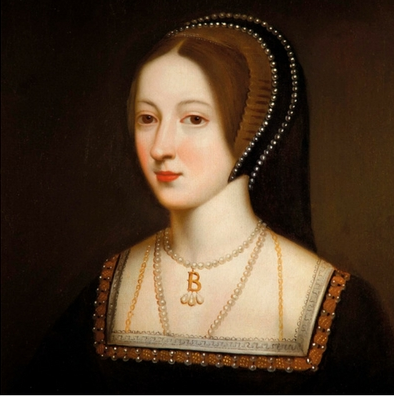
This portrait looks very like the Hoskins miniature portrait in the British Museum
(Although the bedhead in that room is engraved “BOLEYN'S BED”, it is certainly no earlier than 1600 and was probably made up in Victorian times).Hever Castle, Hever Rd, Edenbridge, TN8 7NG
(01732) 865 224
A portrait hanging in the National Portrait Gallery of Ireland
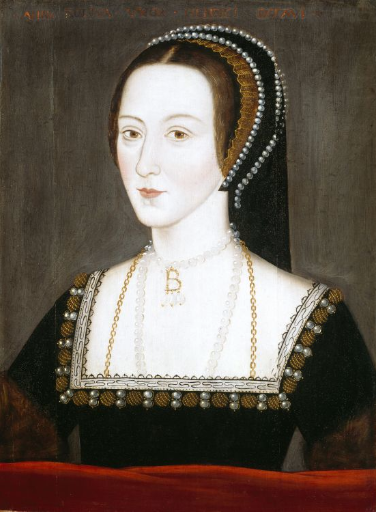
This oval portrait, from the English School (1750-1850), is at Loseley Park and a print may be purchased from Art-Prints-On-Demand
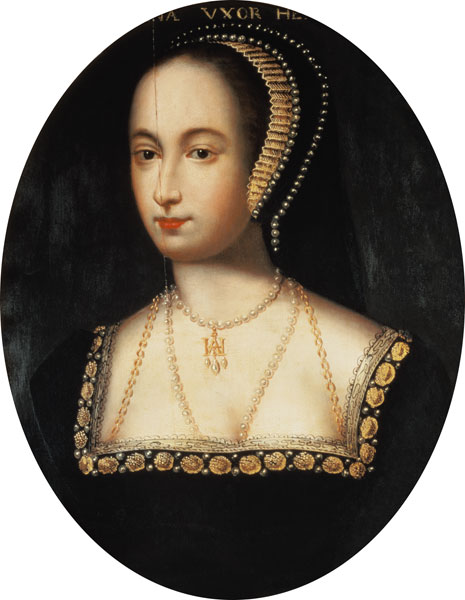
Loseley Park, Guildford, GU3 1HS
(01483) 304 440
The roundel portrait at Hever Castle

Picture of a woman by Lucas Hornebolte
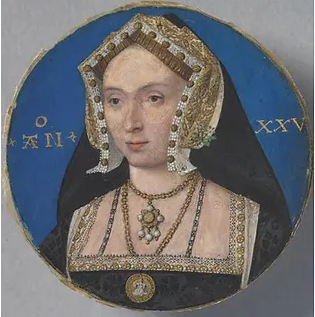
Picture of a woman by Lucas Hornebolte supposedly from around 1525
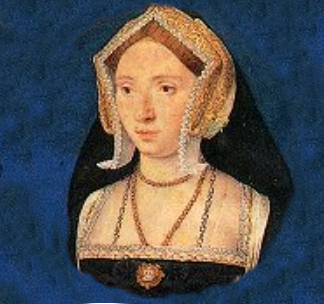
Some argue that this is Anne Boleyn but the face is not the same shape as that in the medal. It more likely to be a portrait of Mary Boleyn
Collection of the Duke of Buccleuch and Queensbury
Portrait at Knole, Nr Sevenoaks
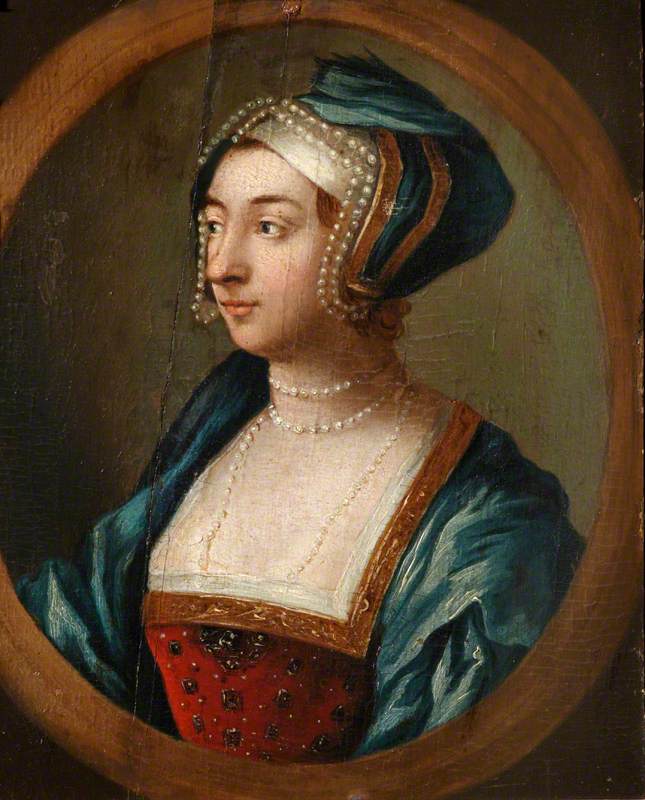
Knole House, Sevenoaks, Kent, TN15 0RP
(SatNav: TN13 1HX)
(01732) 462 100
Portrait at the Dulwich Picture Gallery
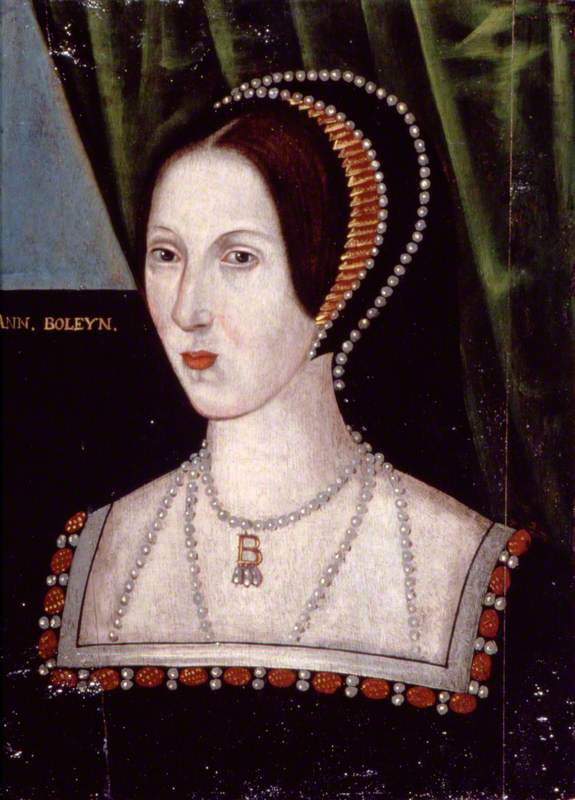
Dulwich Picture Gallery, 14 Gallery Rd, London, SE21 7AD
(020) 8299 8705
Modern picture at Thornbury Castle
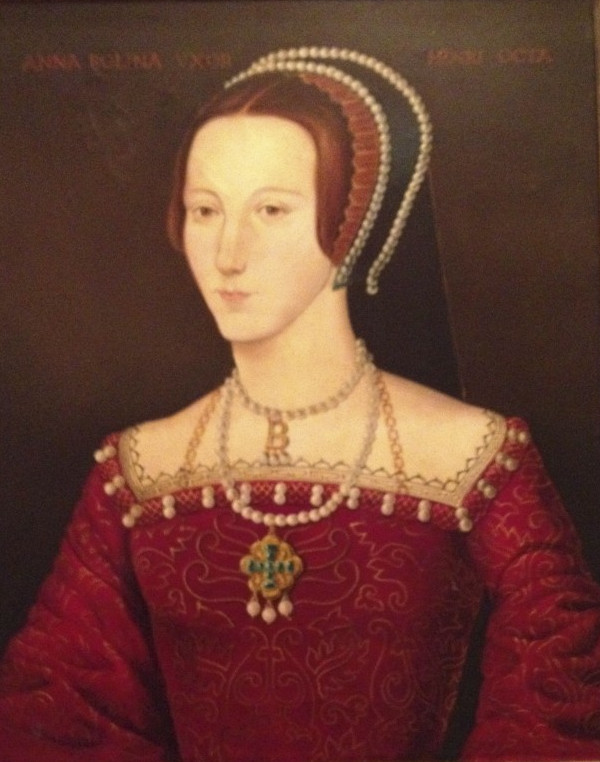
Thornbury Castle, Castle St, Thornbury, BS35 1HH
(01454) 281 182
A 'modern' painting by Unbekkant (1902)
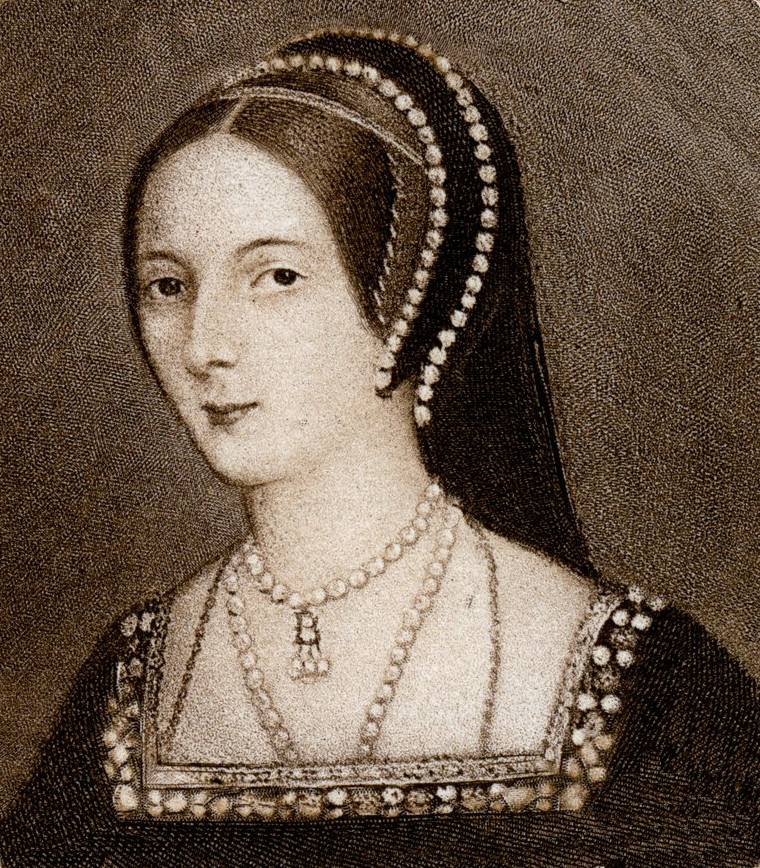
An image created using AI
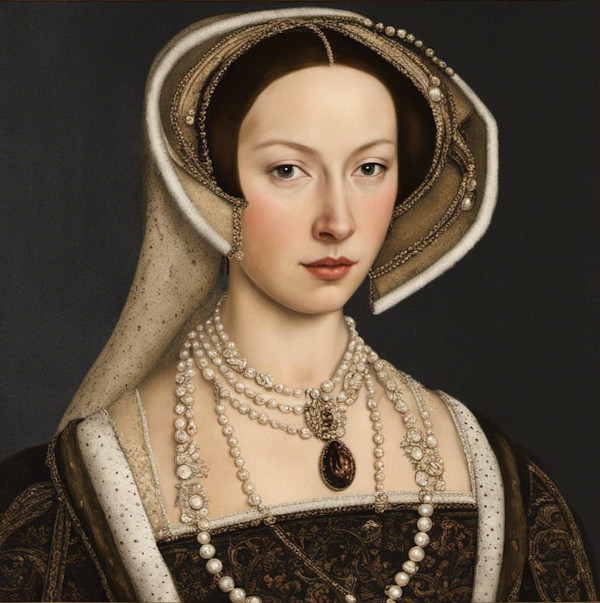
| ≡ | ⇧ |
X-Ray
Awell-known portrait of Elizabeth I has recently (2020) been subjected to Infrared Reflectography (IRR) and X-ray analysis. This has shown another face behind that of Elizabeth and many people believe this to be Anne Boleyn.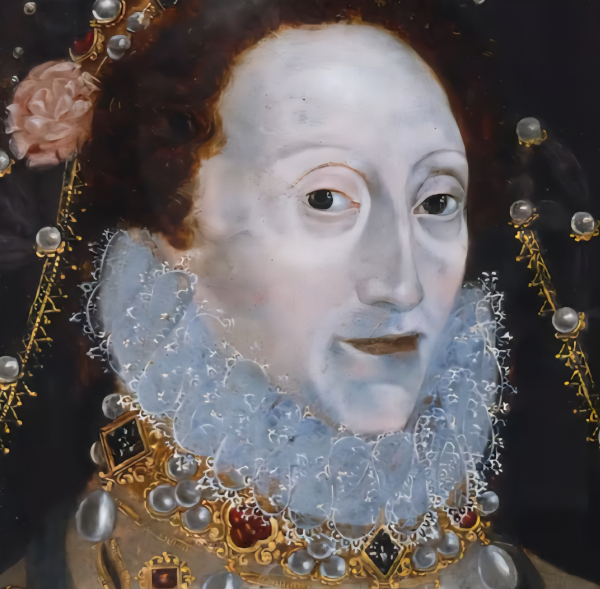 |
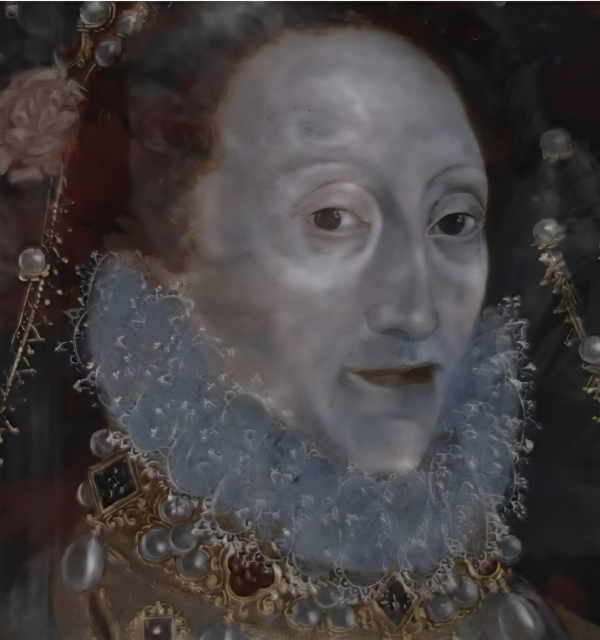 |
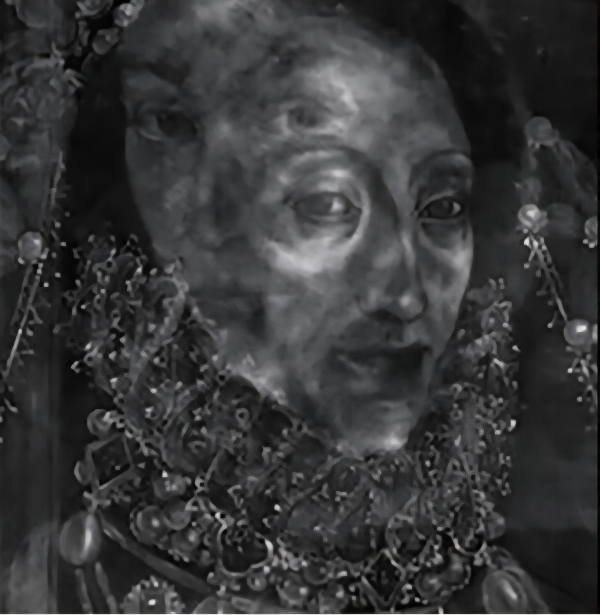 |
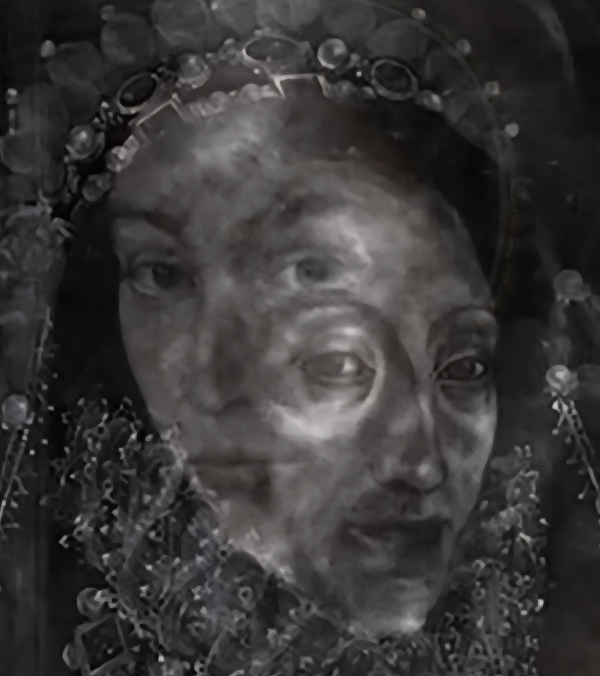 |
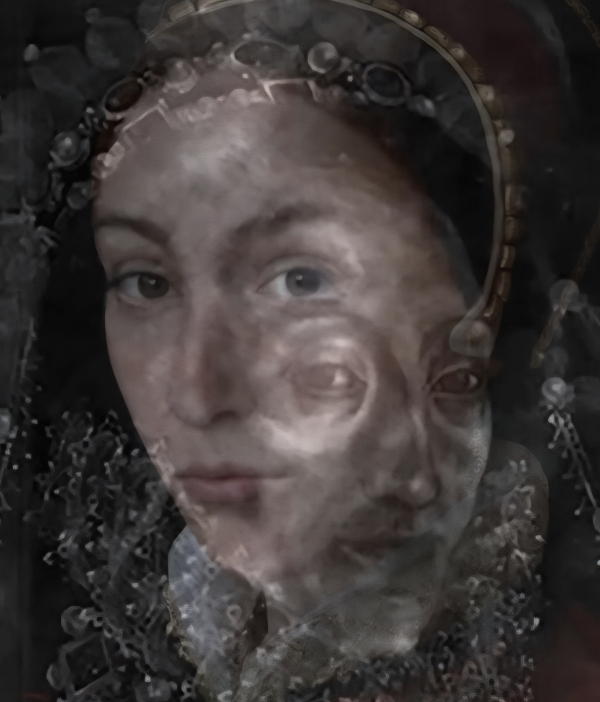 |
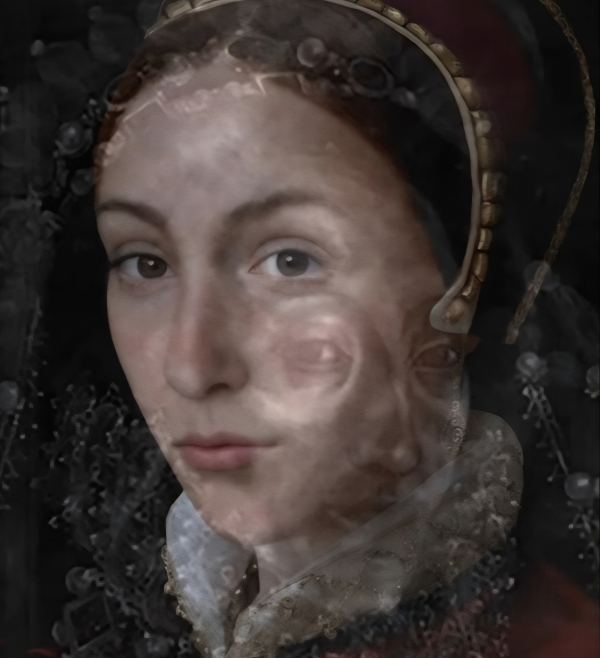 |
 |
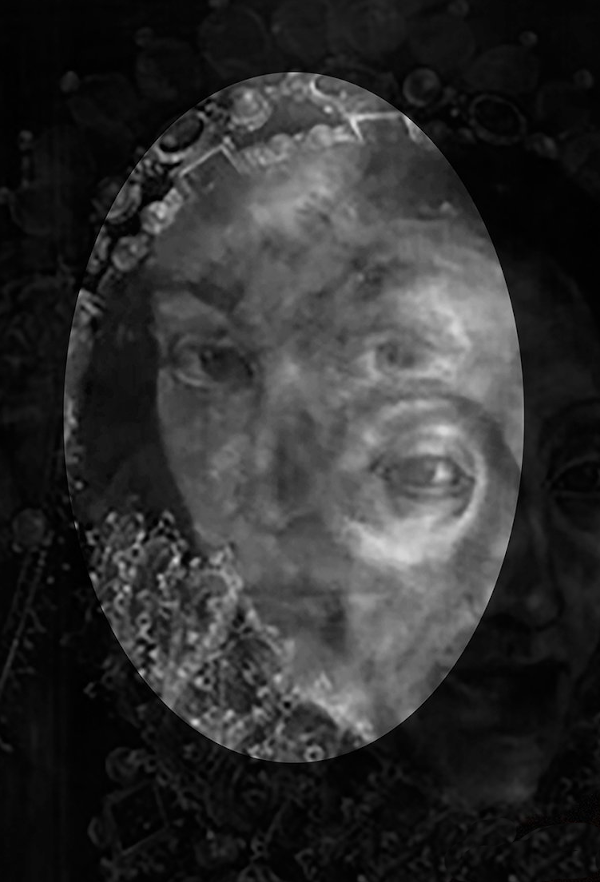 |
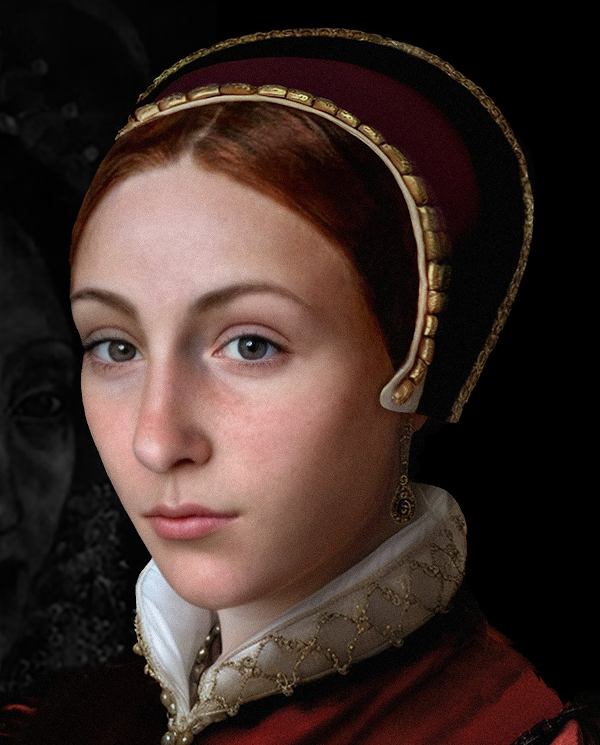 |
However, there are several reasons why this is not a portrait of Anne.
The style of her clothing is a little too late to be the fashion of Anne's time. This type of French hood was worn in the 1570s and 80s. Another piece that's barely visible is what appears to be a ruff - another fashion from about 40 years after Anne's death.
But the best evidence would be to date the panel using dendrochronology, so that’s what the researchers did next. They ultimately found that the wood came from a tree felled between 1572 to 1582, which means that the panel was re-used by Elizabeth only a few years after it was made.
| ≡ | ⇧ |
Best portrait
Newly found (2017) copies of a portrait thought to be Anne Boleyn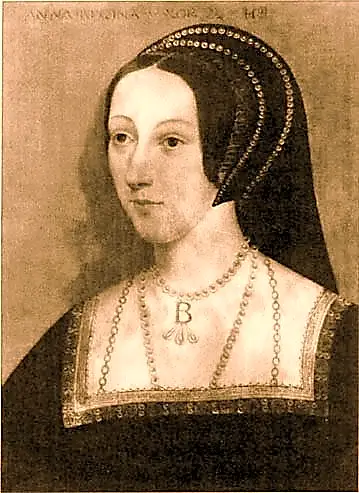
There are two copies of this portrait neither of which look as if they were painted by Holbein but, in style and pose, they are more like those of the German artist Joos van Cleve.
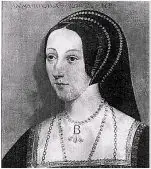 |
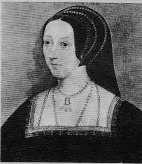 |
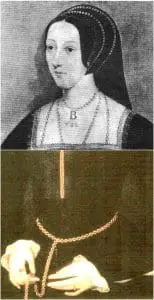 |
Between 1532 & 1536, a contemporary portrait was painted and hung at Hever. In 1539, Hever went to the Crown. In 1550, Hever went to Anna of Cleves. In 1559, Anna died and the portrait went to Henry Fitzalan, Earl of Arundel. In 1580, Fitzalan died having willed the painting to his son John Lumley. In 1609, Lumley died and the painting went to Henry Frederick, Prince of Wales. In 1612, he died and the painting went to Charles I. Sometime between 1612 & 1640, King Charles I commissioned the John Hoskins replica. In 1660, King Charles II acquired the painting and it went to Inner or Middle Temple. In 1679, the painting is damaged in a fire but, luckily, was retrieved, and undamaged parts cut down to a bust. In 1728, the painting was acquired by James West. In 1772, West died and, in 1773, the painting was auctioned and disappeared.
In 1926 the Howard Young gallery photographed a portrait but it has also since disappeared.
In 1940, a portrait (now called the Lyndhurst) surfaced and was sold to Anna Gould. She died in 1961 whence the Lyndhurst Estate and the painting were left to the National Trust for Historic Preservation based in Washington DC. The painting still hangs at the Lyndhurst Estate.

Lyndhurst Estate, National Trust for Historic Preservation, Washington DC.
600 14th Street, NW, Suite 500, Washington DC 20005
202-588-6000
The thought is that this painting is what is left of the contemporary full-length painting from which the Young Gallery painting, the Lyndhurst painting and John Hopkins' miniature were all painted. So it probably represents a pretty good likeness of Anne
.
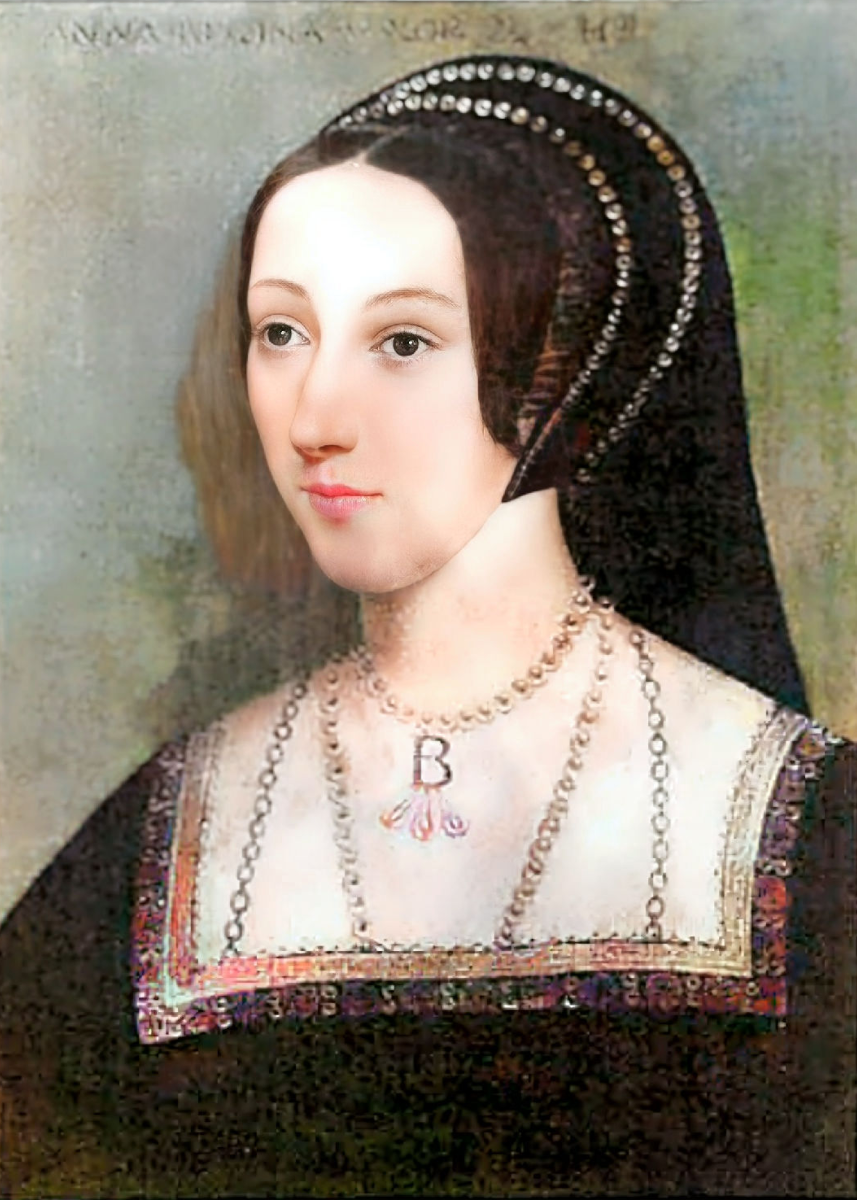
| ≡ | ⇧ |
AI pictures
ChatGPT AI has been used to compose Anne's face from the images agreed (in 2025) by analysts to be the most authenicated likenesses (accepting that almost all of them were painted in her daughter Elizabeth's reign).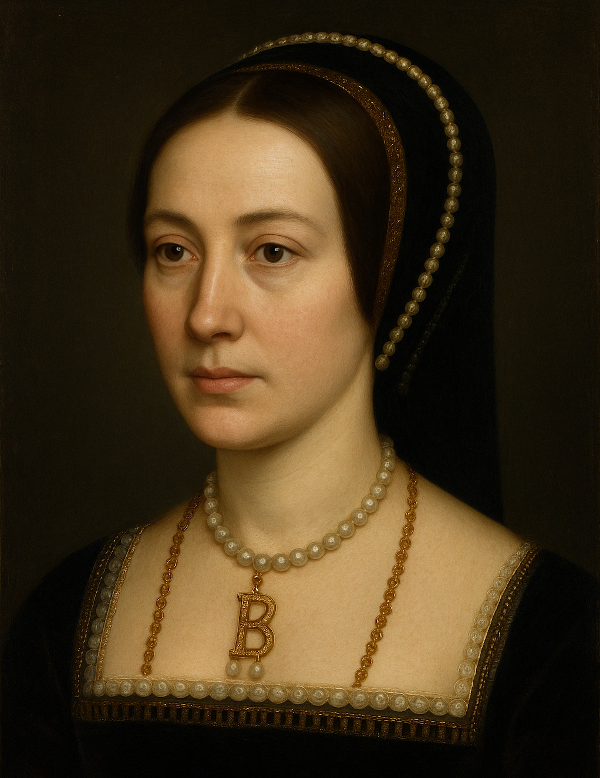 The “basic” image |
Thereafter, AI was used to alter that image to show varying emotions
 |
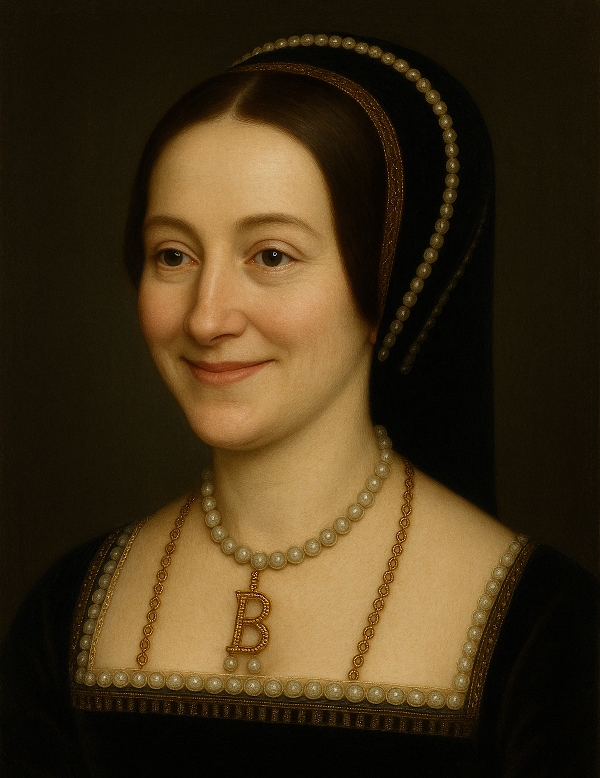 |
||
| A “slight smirk” | “Smiling” |
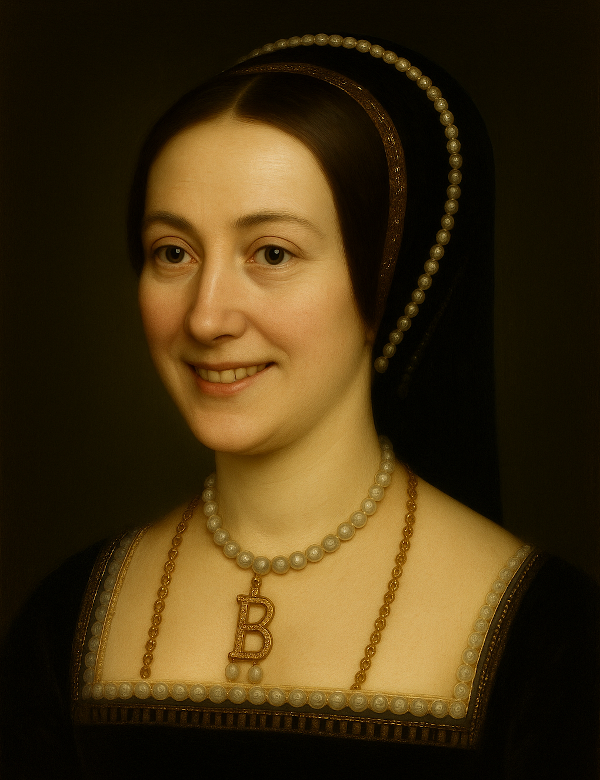 |
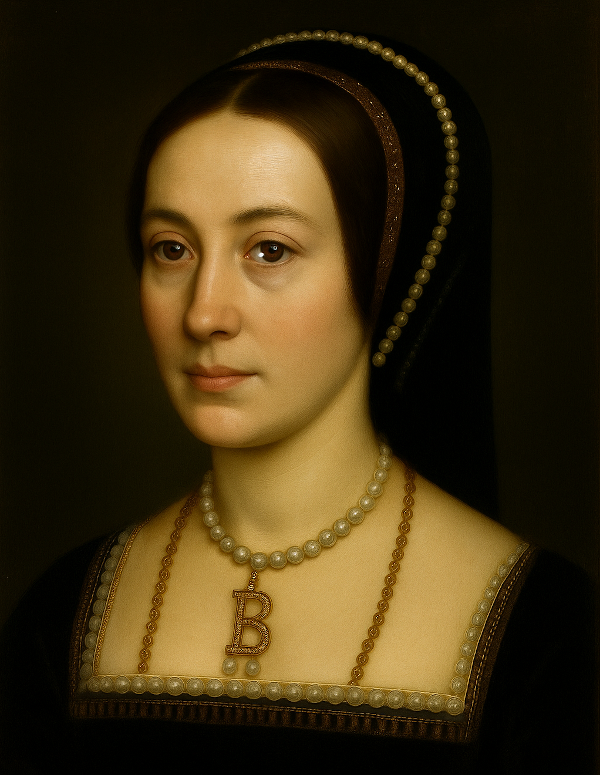 |
||
| “Less passive” | A “twinkle in her eye” (not very successful) |
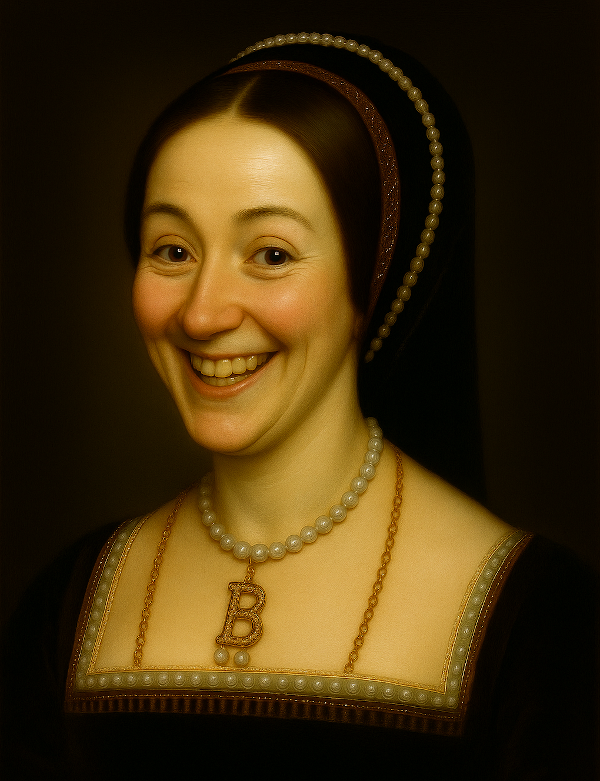 |
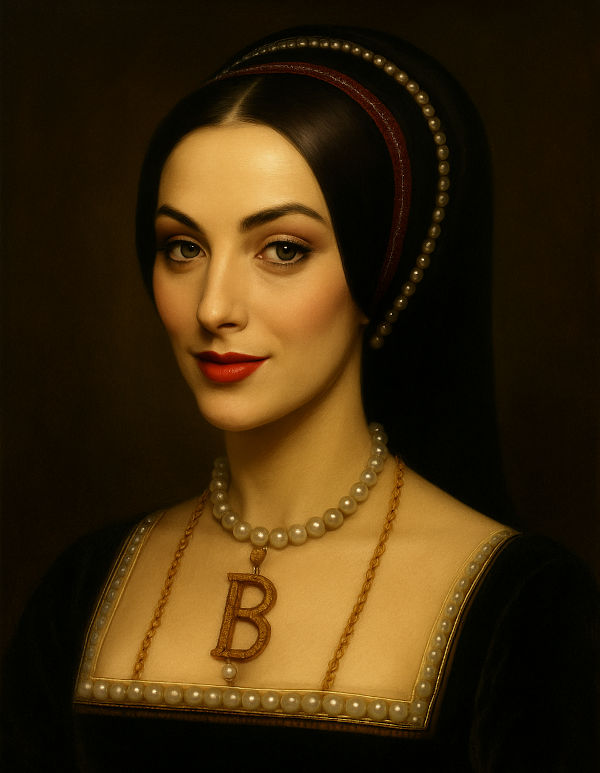 |
||
| “Effervescent” character | “Sexy eyes” (a bit over-the-top) |
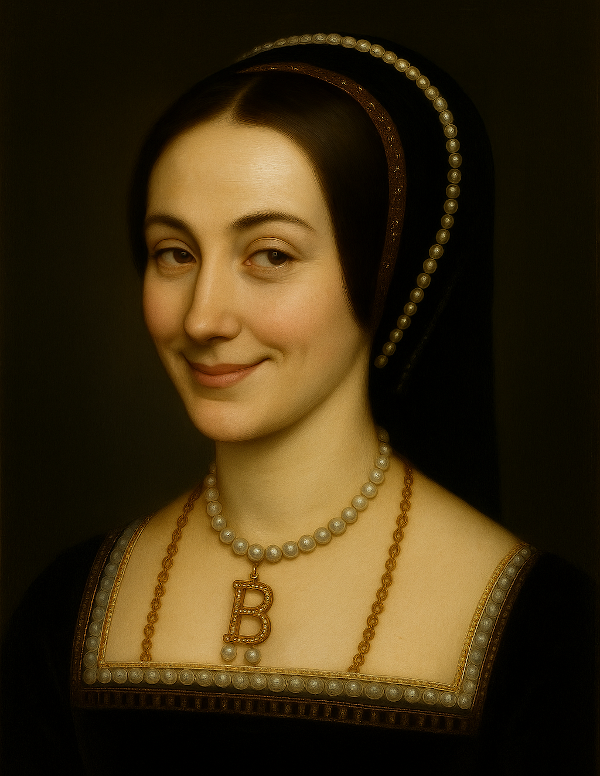 |
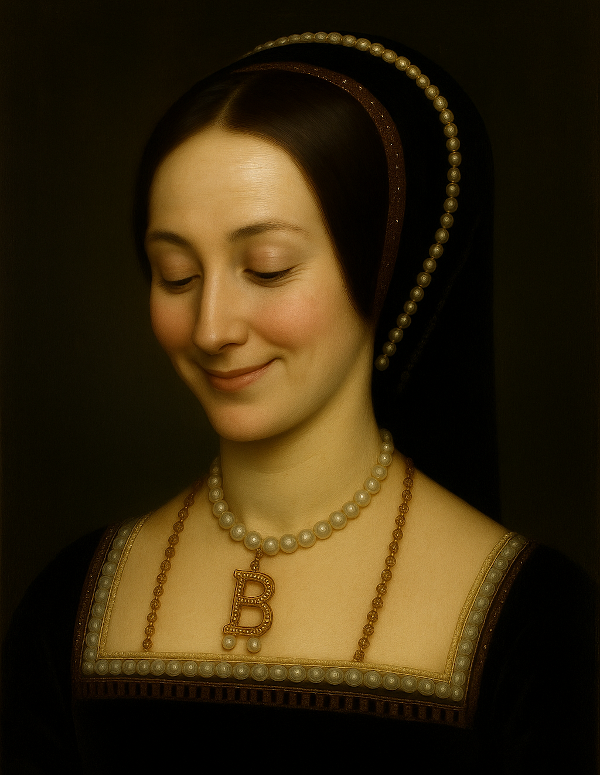 |
||
| “Flirtatious” | “Coy” |
Google Gemini was then asked to do the same thing - and produced a very different-looking person!
 |
Google Gemini refused to make the face look more friendly (because of defacing a work of art!) but ChatGPT would do it (maybe recognising that the image was machine-generated anyway).
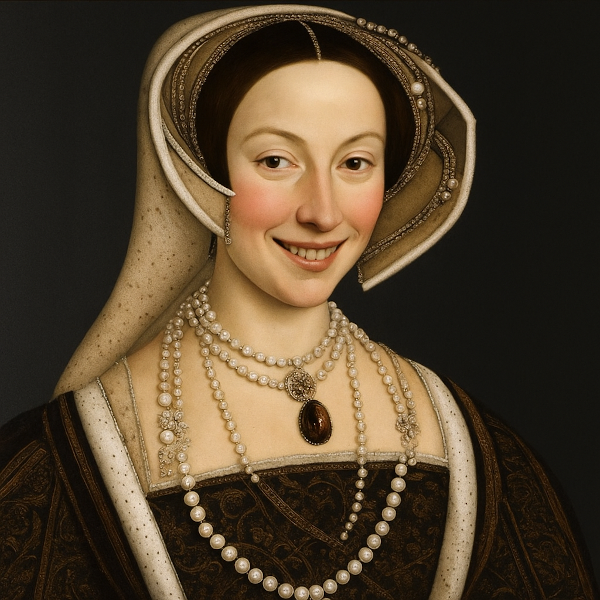 |
| ≡ | ⇧ |
Anne's signatures
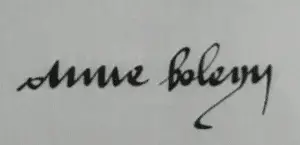
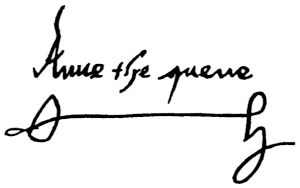
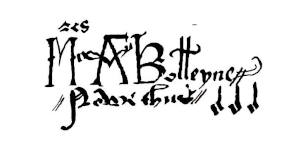
Her handwriting
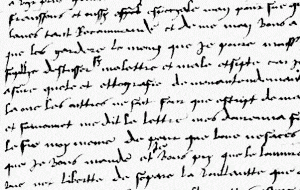
| ≡ | ⇧ |
Anne's death
Sequence of Events.
- 7th Jan 1536:
- Katherine of Aragón died.
- 24th Jan 1536:
- Henry was unconscious for 2 hours after a serious jousting accident.
- 29th Jan 1536:
- Katherine of Aragón was buried.
- Anne Boleyn miscarried
- The baby was said to have been malformed but there is no evidence for this.
- The baby was said to have been male and about 15 weeks old but, even today, it is hard to sex a baby much before 15 weeks without instruments or chemical analysis.
- 24th Apr 1536:
- Henry was looking for a 'legal' way to get rid of Anne and marry again to get a son. He approved (but did not actually sign) a royal commission consisting of leading nobles, household officers and nine judges to hunt out any 'treasonable acts'. The commission included Anne's father.
- 25th Apr 1536:
- Henry spoke of
“... the likelihood and appearance that God will send us heirs male [by] our most dear and most entirely beloved wife, the Queen”. - 26th Apr 1536:
- Anne charged her chaplain, Matthew Parker, with the spiritual care of her daughter Elizabeth.
- 27th Apr 1536:
- Writs were issued summoning parliament.
- 28th Apr 1536:
- The King's Council met every day.
- 29th Apr 1536:
- Cromwell met Dr Richard Sampson, an expert on Canon Law.
Anne had a dangerous conversation with Sir Henry Norris. - 30th Apr 1536:
- Mark Smeaton was arrested and taken to Cromwell's home in Stepney for interrogation. Smeaton 'confessed' (probably under torture) that he was with the Queen on 13 May 1535 at Greenwich - however, it's recorded that she was at Richmond on that date.
The visit to Calais was cancelled. - 1st May:
- King Henry was told of a false rumour, about Anne and Mark Smeaton, at the May Day joust. As a result, he left Greenwich instantly and rode back to Westminster whilst questioning Henry Norris who went with him.
- 2nd May:
- Smeaton was already in the Tower. George Boleyn, Sir Henry Norris and Anne herself were all arrested and taken to the Tower.
- 3rd May:
- Anne spoke of her conversations with Sir Henry Norris and Sir Francis Weston. Archbishop Cranmer expressed his shock that Anne has been arrested.
- 4th May:
- Sir Francis Weston and Sir William Brereton were arrested.
- 5th May:
- Sir Thomas Wyatt and Sir Richard Page were imprisoned in the Tower (although they were freed later).
- 6th May:
- Anne wrote to Henry. (See 'Anne's letter from the Tower' below)
- 7th May:
- William Latymer, Anne's chaplain, searched on his arrival in England.
- 8th May:
- Henry had meetings with noblemen and gentlemen.
- 10th May:
- The Grand Jury of Middlesex issued indictments against Anne and five others.
- 11th May:
- The Grand Jury of Kent decided there was sufficient evidence to send Anne to trial.
- 12th May:
- Anne's friends Mark Smeaton, Sir Francis Weston, Sir William Brereton and Sir Henry Norris were all tried by a special commission of 'oyer and terminer'† in Westminster Hall for allegedly committing adultery with the queen. They were found guilty. (See '30th Apr 1536' above).
- 13th May:
- Anne's household was broken up.
Henry Percy denied a pre-contract between himself and Anne. - 14th May:
- Sir Nicholas Carew moved Jane Seymour to Chelsea.
Cromwell informed Wallop and Gardiner of the Queen's “incontinent living”. - 15th May:
- Anne and George Boleyn were members of the aristocracy and were therefore tried by their peers in the King's Hall at the Tower of London. Both were found guilty.
- 17th May:
- George Boleyn, Mark Smeaton, Sir Francis Weston, Sir William Brereton and Sir Henry Norris were all beheaded on Tower Hill.
- 19th May:
- Anne was beheaded on Tower Green (inside the tower walls) not on Tower Hill (outside the tower walls).
Henry, as usual, went, by barge, to see Jane in Chelsea. - 20th May:
- Henry and Jane Seymour were betrothed.
- 30th May:
- Henry and Jane Seymour were married.
- 12th Oct 1537:
- Edward VI was born.
- 24th Oct 1537:
- Jane Seymour died.
†Oyer and Terminer - a commission under which a court is empowered to hear and determine a criminal case.
| ≡ | ⇧ |
The lead-up.
Anne's fate started several months before her final day.In Jan 1536, Anne and Henry were jubilant when Katherine of Aragón died but Anne was also intensely worried when Henry had a near-fatal jousting accident (possibly/probably during training) and disappointed when she had a miscarriage. The baby was said to have been a son but, in those days, it was almost impossible to identify a child's sex at 15 weeks.
Anne may have made up the sex to convince Henry that she could have sons.
The lack of a male hair and Henry's all-too-apparent mortality, demonstrated by his accident, made him start to think in terms of a third wife, even with all the complications that entailed.
Was Anne's miscarriage on the day of Katherine's burial evidence of Anne's supposed 'wickedness'? Deeply religious people would interpret this as a punishment from God.
Anne attributed her miscarriage to
- the shock of the King's jousting accident
- the anguish she felt when she saw Henry increasingly with Jane Seymour.
Also, Anne wanted cash and riches from the dissolution of the monasteries to go to the poor and education; Cromwell wanted it to go into the King's coffers. Anne and Cromwell were at loggerheads over this - she was a threat to him.
At the end of March, Henry sent a messenger to Greenwich with a letter and a purse full of sovereigns for Jane. But Jane would not be bought as a mistress; she wanted to be Queen. She had been well tutored by her brother Edward Seymour.
George Boleyn was in line for the Order of the Garter but, on 23 Mar, the King gave it to Sir Nicholas Carew. Carew wrote a crowing letter to Mary which included a statement that Henry was 'sick and tired' of Anne. The next day, Henry gave approval for the setting up of oyer and terminer commissions in Middlesex and Kent to investigate offences including 'unspecified treasons'.
It's not clear why the King's attitude to Anne turned deadly and so suddenly. He could have had his marriage to Katherine annulled on the basis that he had slept with Anne's sister, Mary. But Cromwell realised that he might not survive if Anne did, so he started his deadly plot.
Anne got wind of all this and, on 26 Apr, she consulted her chaplain about looking after her daughter, Elizabeth, if anything happened to her. (He referred to himself as Anne's 'countryman' and, since he came from Norfolk, it suggests that Anne was born at Blickling Hall and not Hever Castle). On 27 Apr, the Bishop of London, John Stokesley, was asked if the King could 'abandon' Anne - he had obviously not yet thought of any 'wrong-doing' on her part.
However, on 29 Apr, Mark Smeaton (an able musician) had a jokey conversation with Anne which was overheard, misconstrued and turned against him by Cromwell. He was arrested on 30 Apr and taken to Cromwell's house for 'questionning'. He may have thought he'd get a reduced sentence if he admitted some fault. He, in fact, admitted to adultery with Anne.
On that same day, Sir Henry Norris also had jokey but ill-judged words with Anne because she thought he was delaying his marriage to Madge Shelton. She'd said to him “You look for dead men's shoes, for if aught came to the King but good, you would look to have me”. Norris was dismayed and vowed “if he should have any such thought, he would his head were off”. The Queen was incensed and she warned that “she could undo him”.
Anne was well versed in the delicate balance between the rhetoric and conventions of courtly love. As Queen, she was supposed to demonstrate the ideals of womanly behaviour such as submissiveness and chastity whilst simultaneously playing a central role in the culture of courtly love which involved a lot of flirtatious repartee. So she knew her conversation with Norris had gone too far and mention of the King made it treasonable.
The May Day jousts went ahead. Henry even lent his horse to Norris when his horse refused to enter the lists.
But then he received a note from Cromwell whereupon he and Norris rode immediately from Greenwich to Westminster. The King challenged Norris but he admitted nothing - he was arrested the next day, 2 May 1536. It is thought that perhaps it was Cromwell telling the King that Smeaton had confessed (under torture or threat) to adultery with the Queen.
Anne was arrested on 2 May.
On 6 May 1536, Anne (supposedly) wrote to the King. In the letter, she emphasised her innocence and asked the King to "let not any light Fancy, or bad Counsel of mine Enemies, withdraw your Princely Favour from me". She also asked for a "lawful trial" and puts her present predicament down to the King's affection settling on another - her own lady-in-waiting, Jane Seymour.
On 14 May 1536, Cromwell wrote to Stephen Gardiner and John Wallop, the King's ambassadors in France, and told them what heinous crimes Anne had committed. He said that Norris, Weston, Brereton and Smeaton had all been condemned on 12 May and that the Queen and her brother George "will undoubtedly go the same way".
Well, Well! Is it likely that the Queen would be found innocent when four men have been found guilty of sleeping with her two days before?
On Mon, 15 May 1536, Queen Anne was tried and found guilty of adultery, incest and treason.
On Wed, 17 May 1536, Norris, Weston, Brereton and Smeaton were beheaded on Tower Hill.
| ≡ | ⇧ |
The charges.
In 1528, Henry had written a love note in Anne's illustrated Book of Hours. It said:- “If you remember my love in your prayers as strongly as I adore you, I shall hardly be forgotten, for I am yours”.
- “By daily proof you shall me find; to be to you both loving and kind”
- “Our most dear and most entirely beloved wife the Queen”
- Entertaining malice against the King and following her lustful desires
- Procuring her husband's servants to be her “adulterers and concubines” by “base conversations and kisses, touchings, gifts, and other infamous incitations” so that some of them “yielded to her vile provocations”
- Seducing and committing adultery with Sir Henry Norris, Sir William Brereton, Sir Francis Weston and Mark Smeaton
- Seducing her own brother, George Boleyn, Lord Rochford “to violate her, alluring him with her tongue in the said George's mouth, and the said George's tongue in hers, and also with kisses, presents, and jewels” so that he “violated and carnally” knew her
- Encouraging the men with gifts
- Conspiring “the death and destruction of the king”
- Agreeing to marry one of them after the King's death
- Never having loved the King
- Causing harm and peril to the King through her “malice and adultery”
- Committing treasons “in contempt of the Crown, and of the issue and heirs of the said king and queen” by her actions
The indictments from Middlesex and Kent were as follows (with ripostes in green):
- 6th and 12th October 1533 ‐ Anne and Sir Henry Norris at Westminster.
- On 6th and 12th October 1533, Anne Boleyn would still have been unchurched* after giving birth to her daughter, Elizabeth, the previous month, and so would still have been confined to her chambers. Furthermore, at the time she was at Greenwich, not Westminster
- 16th and 27th November 1533 ‐ Anne and Sir William Brereton at Greenwich.
- She may have wanted a son but surely not when her first child, albeit a daughter, was only two months old
- 3rd and 8th December 1533 ‐ Anne and Sir William Brereton at Hampton Court.
- 3rd and 8th December 1533 ‐ Records show that the royal court was at Greenwich on 8th December, so Anne could not have been committing adultery with Sir William Brereton at Hampton Court Palace
- 12th April 1534 ‐ Anne and Mark Smeaton at Westminster (date for Anne procuring Smeaton).
- April, May and June 1534 ‐ A letter from George Taylor to Lady Lisle dated 27th April 1534 says that “the Queen hath a goodly belly, praying our Lord to send us a prince” and in July, Anne's brother, Lord Rochford, was sent on a diplomatic mission to France to ask for the postponement of a meeting between Henry VIII and Francis I because of Anne's condition: “being so far gone with child she could not cross the sea with the King”. So, there is evidence that Anne was visibly pregnant at this time, a time when she was allegedly seducing and sleeping with Mark Smeaton and Sir Francis Weston. Sexual intercourse was not commonly practised when the woman was pregnant
- 8th and 20th May 1534 ‐ Anne and Sir Francis Weston at Westminster.
- 13th and 19th May 1535 ‐ It would have been difficult for Anne to be sleeping with Mark Smeaton at Greenwich on the 19th when she was in Richmond at the time
- 6th and 20th June 1534 ‐ Anne and Sir Francis Weston at Greenwich.
- Anne could also not have slept with Weston on 20th June at Greenwich when the court was at Hampton Court from 3rd to 26th June
- 13th and 19th May 1535 ‐ Anne and Mark Smeaton at Greenwich.
- 13th and 19th May 1535 ‐ It would have been difficult for Anne to be sleeping with Mark Smeaton at Greenwich on the 13th when she was in Richmond at the time
- 31st October 1535 ‐ Anne and some of the men plotted the King's death at Westminster.
- 2nd and 5th November 1535 ‐ Anne and her brother George Boleyn, Lord Rochford at Westminster.
- Her conversion with Sir William Norris misconstrued
- 27th November 1535 ‐ Anne gave gifts to the men at Westminster.
- 27th November 1535 ‐ Seeing as Anne Boleyn miscarried a baby of 15 weeks' gestation on the 29th January 1536, she would have been pregnant at this time, although in the early stages. If she had had an inkling that she was pregnant, what benefit would it be for her to give gifts to the men to get them on side? Also, Anne was not at Westminster on this date, she was at Windsor
- 22nd and 29th December 1535 ‐ Anne and her brother George Boleyn, Lord Rochford, at Eltham Palace.
- 22nd and 29th December 1535 ‐ Would a woman in the early stages of pregnancy really have the reason or the inclination to seduce her brother?
- 8th January 1536 ‐ Anne plotted the King's death with Rochford, Norris, Weston and Brereton at Greenwich.
- 8th January 1536 ‐ Would Anne really be plotting the King's death while also celebrating Katherine of Aragón's death with Henry?
It's also highly probable that Anne's deep religion and lack of privacy would have made any adultery impossible.
But ...
| ≡ | ⇧ |
Anne's letter from the Tower.
In it, she declares her love for him and swears that she never forsook him for another man. She says she hopes God forgives for any harm he does to her. And she she writes directly as his wife; not as Queen.Cromwell think she might be able to turn the King so he ensures that Henry never receives the letter. The original was badly damaged in a fire at Ashburnham in .... but, luckily, most of the letter (along with many other documents) were saved and restored by Arthur Onslow. Also copies, made before, survive.
The letter doesn't appear to be in Anne's handwriting and the signature doesn't look like hers so it was probably dictated.
"Sir, Your Grace's Displeasure and my Imprisonment are Things so strange unto me, as what to Write, or what to Excuse, I am altogether ignorant. Whereas you send unto me (willing me to confess a Truth, and to obtain your Favour) by such an one whom you know to be my ancient professed Enemy; I no sooner received this Message by him, than I rightly conceived your Meaning; and if, as you say, confessing a Truth indeed may procure my safety, I shall with all Willingness and Duty perform your Command. But let not your Grace ever imagine that your poor Wife will ever be brought to acknowledge a Fault, where not so much as a Thought thereof proceeded. And to speak a truth, never Prince had Wife more Loyal in all Duty, and in all true Affection, than you have ever found in Anne Boleyn, with which Name and Place I could willingly have contented my self, if God, and your Grace's Pleasure had been so pleased. Neither did I at any time so far forget my self in my Exaltation, or received Queenship, but that I always looked for such an Alteration as now I find; for the ground of my Preferment being on no surer Foundation than your Grace's Fancy, the least Alteration, I knew, was fit and sufficient to draw that Fancy to some other Subject.
You have chosen me, from a low Estate, to be your Queen and Companion, far beyond my Desert or Desire. If then you found me worthy of such Honour, Good your Grace let not any light Fancy, or bad Councel of mine Enemies, withdraw your Princely Favour from me; neither let that Stain, that unworthy Stain of a Disloyal Heart towards your good Grace, ever cast so foul a Blot on your most Dutiful Wife, and the Infant Princess your Daughter: Try me good King, but let me have a Lawful Trial, and let not my sworn Enemies sit as my Accusers and Judges; yea, let me receive an open Trial, for my Truth shall fear no open shame; then shall you see, either mine Innocency cleared, your Suspicion and Conscience satisfied, the Ignominy and Slander of the World stopped, or my Guilt openly declared. So that whatsoever God or you may determine of me, your Grace may be freed from an open Censure; and mine Offence being so lawfully proved, your Grace is at liberty, both before God and Man, not only to execute worthy Punishment on me as an unlawful Wife, but to follow your Affection already settled on that Party, for whose sake I am now as I am, whose Name I could some good while since have pointed unto: Your Grace being not ignorant of my Suspicion therein.
But if you have already determined of me, and that not only my Death, but an Infamous Slander must bring you the enjoying of your desired Happiness; then I desire of God, that he will pardon your great Sin therein, and likewise mine Enemies, the Instruments thereof; and that he will not call you to a strict Account for your unprincely and cruel usage of me, at his General Judgment-Seat, where both you and my self must shortly appear, and in whose Judgment, I doubt not, (whatsover the World may think of me) mine Innocence shall be openly known, and sufficiently cleared.
My last and only Request shall be, That my self may only bear the Burthen of your Grace's Displeasure, and that it may not touch the Innocent Souls of those poor Gentlemen, who (as I understand) are likewise in strait Imprisonment for my sake. If ever I have found favour in your Sight; if ever the Name of Anne Boleyn hath been pleasing in your Ears, then let me obtain this Request; and I will so leave to trouble your Grace any further, with mine earnest Prayers to the Trinity to have your Grace in his good keeping, and to direct you in all your Actions.
From my doleful Prison the Tower, this 6th of May.
Your most Loyal and ever Faithful Wife,
Anne Boleyn""
The letter's route to safety:
- Letter was hidden with Cromwell's private papers secreted away from 1536–1540
- Cromwell's execution date of death, 28 July 1540
- Ralph Sadler retrieved letter from hiding, July 1540
- William Cecil, Lord Burghley, chief advisor to Elizabeth I given the letter by Ralph Sadler, c.1540–1550?
- Queen Elizabeth I (and Lord Burghley) in possession of the letter from c.1550–1600
- William Camden, antiquarian inherited letter from Burghley, c.1580–1598?
- Sir Robert Bruce Cotton, antiquarian and collector of manuscripts inherited the letter from William Camden, c.1623
- Sir Thomas and Sir John Cotton, son and grandson inherited the library in 1631
- Sir John Cotton, grandson and custodian of Cotton manuscripts maintained the library 'til c.1700
- Ashburnam House fire destroyed the Cotton Library documents and damaged the letter, 23 October 1731
- British Museum library possession and restoration of 'The Tower Letter', 1732 till present.
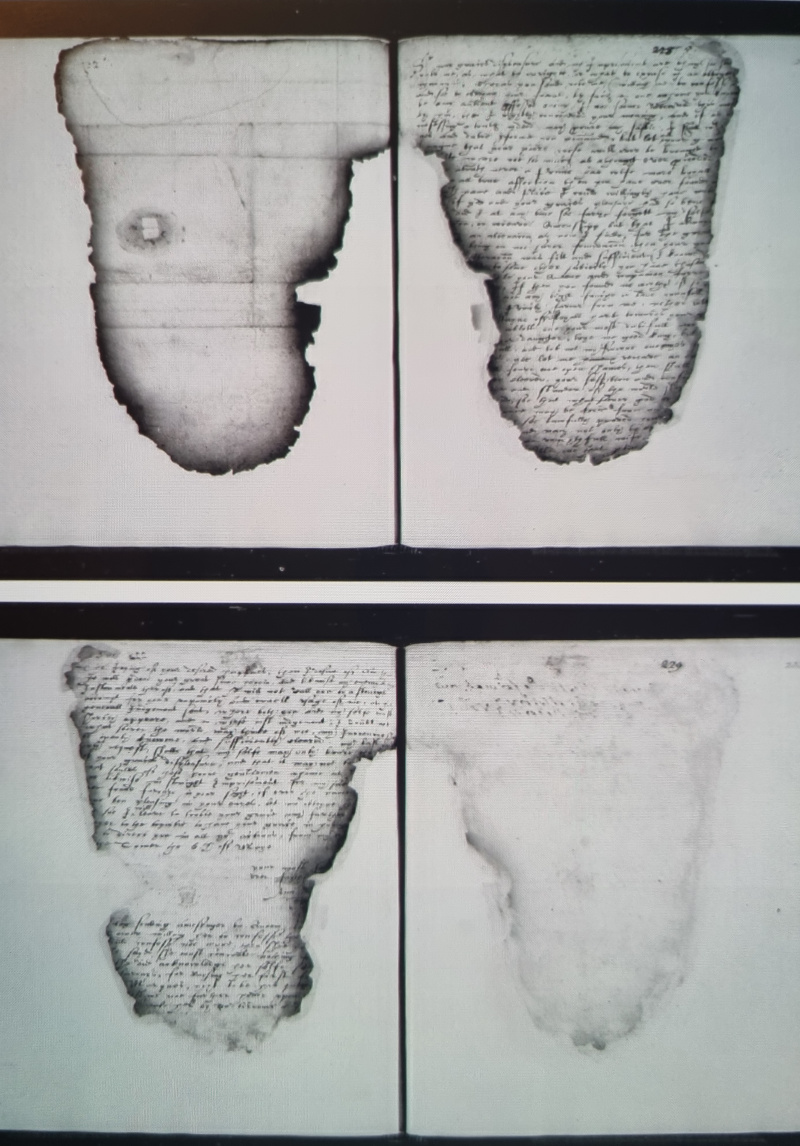
Front and back of the original letter retrieved from the fire at Ashburnham House
© The British Library Board, Stowe MS 151
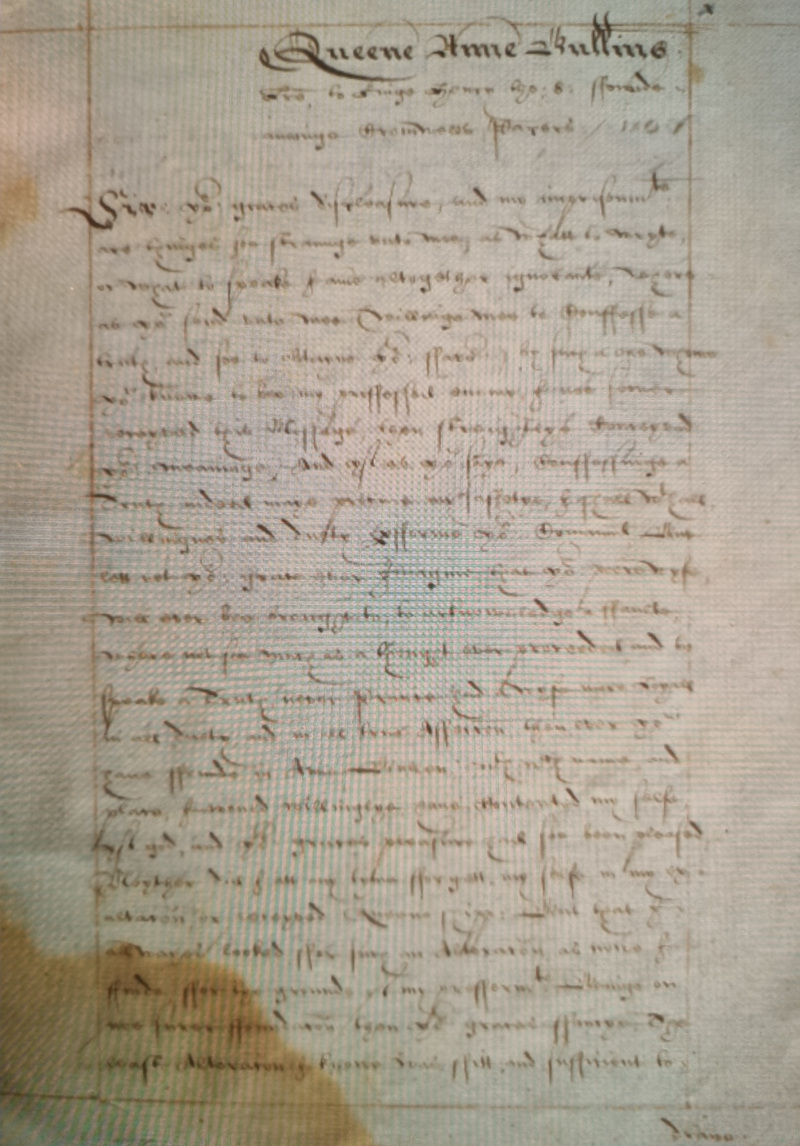
A copy of the letter by the 'Feathery Scribe'
© The British Library Board, Cotton Otho CX 232
| ≡ | ⇧ |
The trial.
Before it even started, Anne's trial was prejudiced by the guilty verdicts of Norris, Brereton, Weston, and Smeaton three days before and the jury was made up of her enemies.Notwithstanding that, the Bishop of Riez, a witness to the trial, wrote of Anne as she entered:
- "She walked forth in fearful beauty, and seemed unmoved. She came not as one who had to defend her cause, but with the bearing of one coming to great honour."
- • She had not been told what the charges against her were.
- • She had not been allowed to have any legal representation.
- • The Crown produced no 'live' evidence.
- • The Crown called no witnesses.
- • She had to answer all the preposterous charges off the cuff and in person ‐ in front of some 2,000 people.
- • She was unanimously condemned. Jurers were asked for their verdict from the most junior to the most senior so that juniors weren't intimidated by their seniors although they all knew that they would offend the King if they didn't vote the way they were expected to.
Anne's response to the sentence, read out by the Duke of Norfolk, was remarkably calm and eloquent, as Charles Wrothesley testified: - "she made so wise and discreet answers to all things laid against her, excusing herself with her words so clearly, as though she had never been faulty to the same."
- "My lords, I will not say your sentence is unjust, nor presume that my reasons can prevail against your convictions. I am willing to believe that you have sufficient reasons for what you have done; but then they must be other than those which have been produced in court, for I am clear of all the offences which you then laid to my charge. I have ever been a faithful wife to the King, though I do not say I have always shown him that humility which his goodness to me, and the honours to which he raised me, merited. I confess I have had jealous fancies and suspicions of him, which I had not discretion enough, and wisdom, to conceal at all times. But God knows, and is my witness, that I have not sinned against him in any other way. Think not I say this in the hope to prolong my life, for He who saveth from death hath taught me how to die, and He will strengthen my faith. Think not, however, that I am so bewildered in my mind as not to lay the honour of my chastity to heart now in mine extremity, when I have maintained it all my life long, much as ever queen did. I know these, my last words, will avail me nothing but for the justification of my chastity and honour. As for my brother and those others who are unjustly condemned, I would willingly suffer many deaths to deliver them, but since I see it so pleases the King, I shall willingly accompany them in death, with this assurance, that I shall lead an endless life with them in peace and joy, where I will pray to God for the King and for you, my lords."
| ≡ | ⇧ |
Her feelings.
Anne's mental state must have been in turmoil:- she had been discarded by the man who had pursued her for six years, been married to her for three, fathered her daughter and seemingly adored her for much of their time together
- the person to whom she was closest - her brother George - had been executed two days beforehand on the most hideous and shameful of charges
- the rest of her family, as far as we can tell, abandoned her or - as Anne believed of her mother - was awash with despair and grief over what was happening
- she was still recovering from a miscarriage and suffered mood swings with both her mind and body affected by hormonal changes
- she had been sent to prison on absurd, concocted charges
- she was 'cared for' in prison by women who were hostile spies
- there had been a fire in her bedroom (sometime between 7th and 24th Jan)
- she had to look on as Henry 'eyed up' another woman (one of Anne's ladies-in-waiting: Jane Seymour)
- Henry had had a very serious jousting accident on 7 Jan.
| ≡ | ⇧ |
The day before her death.
She had spent most of the day of the 18th May in prayer and talking to the ladies who waited on her - although they were also spies for Cromwell. Its likely that, in those final hours, the ladies came to see how wronged Anne had been and they may have begun to sympathise with her. The ladies who were with her the following day certainly cried on the scaffold but they may have been Anne's original and preferred ladies and not Cromwell's spies.Sir William Kingston confirms that Anne swore twice on the holy sacrament, once before taking it and once after, that she was innocent and he reported this to Cromwell:
- “This morning she sent for me, that I might be with her at such time as she received the good Lord, to the intent I should her speak as touching her innocency alway to be clear.”
| ≡ | ⇧ |
Her final hour.
Soon after 8am, the Queen, accompanied by four young women of her own household, left the Royal Lodgings, where she had stayed as Queen and where she was kept after being condemned; she walked down the long corridor and then the flight of 15 stairs down to two facing rows of guards. She was then escorted, unrestrained, by some 200 guards, Sir William Kingston and the four ladies, from the Royal Lodgings, past the Great Hall, where she had dined the day before her coronation, through the Cold Harbour Gate, up the West side of the White Tower and up about 5 steps onto the scaffold erected to the North of the Tower roughly where the entrance to the Waterloo Barracks is now - not where the Victorian memorial stands.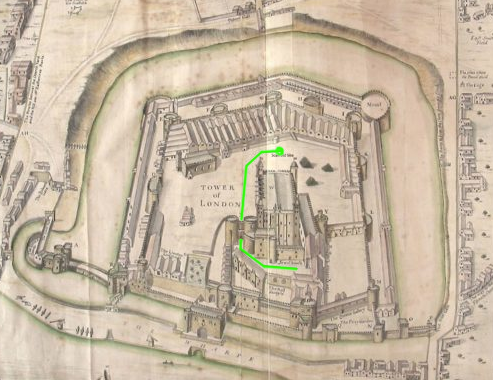
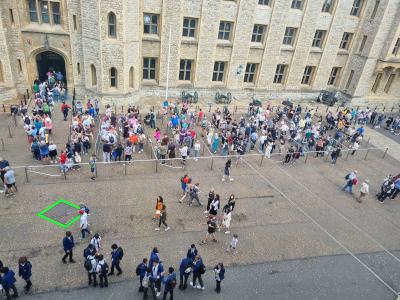
A photo showing my [RDP] marking of the likely spot where Anne was executed, 19 July 2023
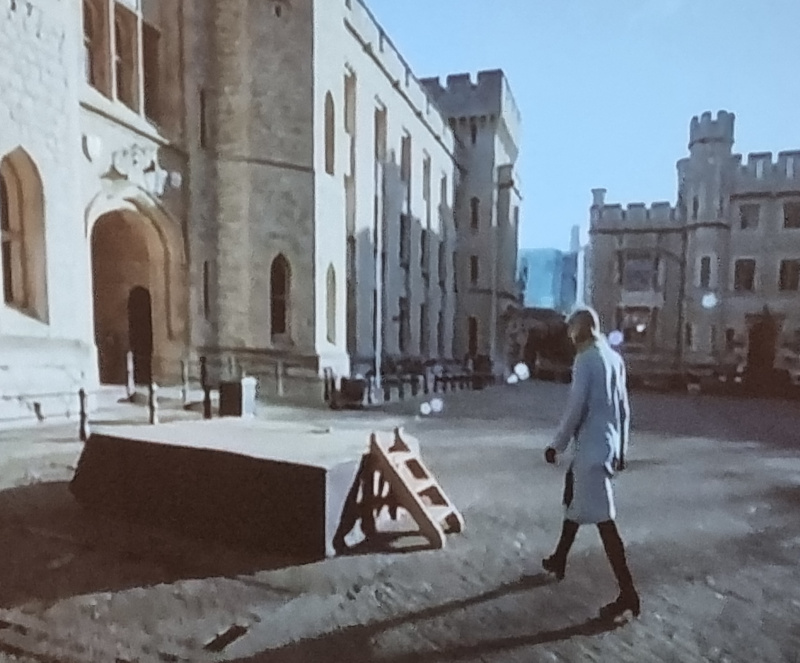
Set from Channel 5's "Fall of Anne Boleyn" TV series
The figure is Prof. Tracy Borman, OBE - Chancelor of Bishop Grosseteste University
It is thought the scaffold was about 3ft high with 4 or 5 steps
-
A Portuguese merchant, who had seen her on several occasions before, remarked:
- “Never had the Queen looked so beautiful.”
- “Her face and complexion never were so beautiful.”
- “Went to her execution with an untroubled countenance.”
- “Her looks were cheerful.”
- “As gay as if she were not going to die.”
- “Madam,” he said, head bowed,
- “I crave Your Majesty's pardon, for what I am ordered to do is my duty.” She answered him in French and forgave him entirely, as was expected of her.
- “You would have thought [them] bereft of their souls, so languid and weak were they with anguish.”
- “Not that she desired death, but that she thought herself prepared to die.”
A French bishop, also amongst the spectators, wrote:
Someone else said that the queen:
Lord Crispin de Milherve recorded that:
Her ladies-in-waiting were "shedding many tears".
When Anne stepped up onto the scaffold, it was said she was:
The executioner was “himself distressed” as he knelt before the Queen and went through the ritual of begging her forgiveness:
The ladies-in-waiting stepped back and huddled at the far end of the scaffold, sobbing.
The Bishop of Riez wrote:
Afterwards Sir William Kingston said that, when he had collected her, from the Royal Lodgings, it was:
- " Good Christian people, I am come hither to die, for according to the law, and by the law I am judged to die, and therefore I will speak nothing against it. I am come hither to accuse no man, nor to speak anything of that, whereof I am accused and condemned to die, but I pray God save the king and send him long to reign over you, for a gentler nor a more merciful prince was there never: and to me he was ever a good, a gentle and sovereign lord. And if any person will meddle of my cause, I require them to judge the best. And thus I take my leave of the world and of you all, and I heartily desire you all to pray for me. O Lord have mercy on me, to God I commend my soul."
After being blindfolded and kneeling on the scaffold, she repeated several times: To Jesus Christ I commend my soul; Lord Jesu receive my soul.
Henry had chosen for her to be beheaded, rather than burned at the stake, and had chosen a sword, rather than an axe:
• either because he was harking back to Camelot and his idea of chivalry (his brother had been called Arthur)
• or because the sword was more reliable and therefore kinder than the blow, or blows, of an axe
• or he was just snubbing Anne's French connections by using a French execution method.
The executioner, a swordsman from Calais,† had been summoned. The time taken for the journey to summon him, and his journey to England, means that he must have been summoned before Anne's trial.
However, on 30th April, Mark Smeaton 'confessed' to carnal relations with Anne - so, by association, he, Sir Francis Weston, Sir William Brereton and Sir Henry Norris were all found guilty on 12th May. These events obviously sealed Anne's fate so maybe it was they that triggered the summoning of the executioner before Anne's trial on 15th May.
On the scaffold, the swordsman asked for, and was granted, Anne's forgiveness
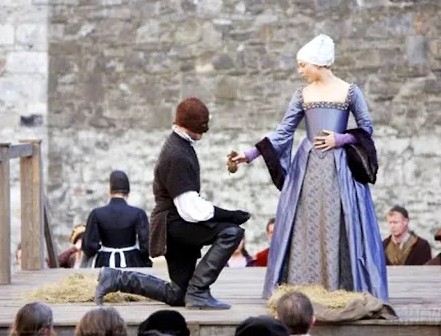 |
so he now distracted her by asking his assistant to pass him his sword (which he already had in his hands or had hidden under the straw) and with one, mighty swipe, he severed her head from her body.
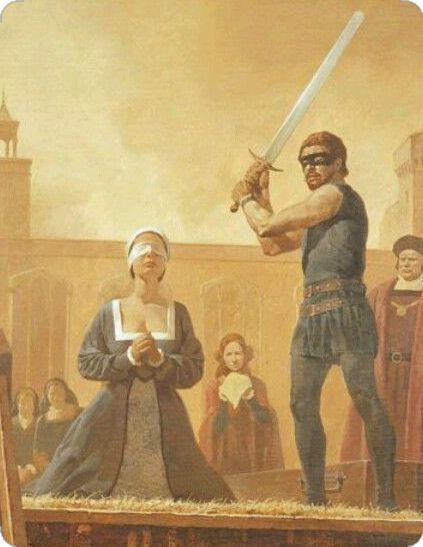 |
No wonder this horrific injustice is still talked about nearly 500 years later.
† The executioner was a Frenchman, but of English descent, from Calais which was then almost an English colony. He was not called Jean Rombaud or Pierre Behal - executioners invariably remained anonymous for fear of reprisals and this man was about to carry out a first, the execution of a Queen of England. He was summoned by Cromwell, albeit in the King's name, and was escorted from his ship to London - escorted for his safety and lest he got cold feet at the enormity of his task (which he nearly did).
The Chapel.
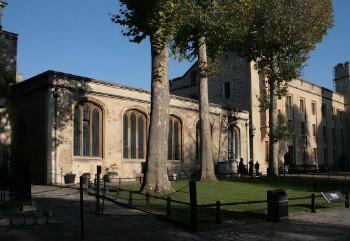
Immediately after her execution, Anne's head and body were covered with white cloths and placed in an old elm trunk, which had once held bow-staves for Ireland. Three hours later (presumably being the time it took to dig the grave), she was buried, at noon, in the chancel of the Chapel Royal of St Peter ad Vincula, next to her brother.
The chapel had burnt down in 1512 but was rebuilt in 1519.
The Grave.
It is thought Anne was placed on the left (as you look at the altar) because that was where people of the highest standing were placed.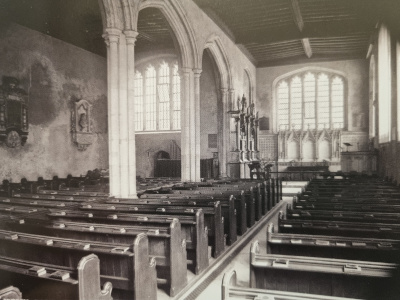 |
 |
These are the supposed burial plot positions as recorded in 1876. They are immediately in front of the altar in the Chapel. Two dukes between two queens.
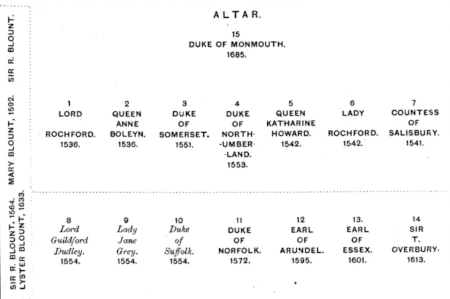
Diagram publshed by Doyne C. Bell
- 1536 Lord Rochford
- George Boleyn, Queen Anne's younger brother who was executed 2 days before Anne. He was accused of incest with Anne and therefore treason.
- 1536 Queen Anne Boleyn
- Murdered on Friday, 19th May 1536, she was accused of adultery, incest and treason. Her actual 'crimes' were merely failing to produce a male heir and not reining in her headstrong personality.
- 1551 Duke of Somerset
- Edward Seymour who was on the Regency Council which supervised the young King Edward VI. Seymour assumed the power of the monarch.
- 1553 Duke of Northumberland
- John Dudley, father-in-law of Queen Jane (Lady Jane Grey). When Mary I deposed Queen Jane, he was accused of high treason.
- 1542 Queen Katheryn Howard
- She slept with too many people and was accused of adultery and treason
- 1542 Lady Rochford
- Jane Boleyn (née Parker), wife of George Boleyn who was Queen Anne's brother. She became a lady-in-waiting to Jane Seymour and Anna of Cleves and then to Kateryn Howard with whom she was executed on 13 Feb 1542.
- 1541 Countess of Salisbury
- Margaret Pole. Her husband, Reginald Pole, had denounced Queen Anne's marriage to the King.
- 1554 Lord Guildford Dudley
- Queen (Lady) Jane Grey's husband
- 1554 Queen (Lady) Jane Grey
- Condemned by Queen Mary, given a reprieve but ultimately, murdered by Mary.
- 1554 Duke of Suffolk
- Henry Grey, father of Lady Jane Grey; his opposition to Queen Mary I and his role in Sir Thomas Wyatt's rebellion led to his execution.
- 1572 Duke of Norfolk
- Thomas Howard, executed for his intrigues against Queen Elizabeth I on behalf of Mary Stuart, Queen of Scots, a Roman Catholic claimant to the English throne.
- 1595 Earl of Arundel
- Lord Philip Howard, died in the Tower of London, where he had been imprisoned for ten years. He was 38. Lord Philip was the son and heir of Thomas Howard, 4th Duke of Norfolk.
- 1601 Earl of Essex
- Thomas Cromwell. Placed under house arrest for leading a poor campaign in Ireland during the Nine Years War and he was executed for treason following a coup d'état against Queen Elizabeth I's government.
- 1613 Sir Thomas Overbury
- Poisoned because he was opposed to the annulment of Frances Howard's marriage to Robert Devereux so that she could marry Robert Carr, Viscount Rochester.
- 1564 Sir Richard Blount
- Owned Iver, was in Henry VIII's Household, laid low during Mary I's reign and was Lieutenant of the Tower during Elizabeth I's reign.
- 1633 Lister Blount
- The son of Sir Richard Blount
- 1592 Lady Mary Blount
- Married Sir Michael Blount, had 6 sons and 7 daughters. Died in London and buried at the Tower.
- 1685 Duke of Monmouth
- Leader of the Monmouth rebellion - attempting to overthrow
King James II
So, in 1876, the floor was dug up and renewed. At this time many of the bones they found were muddled up so they were identified before being 'soldered up in thick leaden coffers and then fastened down with copper screws in boxes made of oak plank, one inch in thickness. Each box bore a leaden escutcheon on which was engraved the name of the person whose supposed remains were thus enclosed, together with the dates of death and the year (1877) of reinterment.'
It is now thought that because of their stature, chin shape and apparent age, the bones of Anne Boleyn actually lie under the memorial tile dedicated to Lady Rochford, her sister-in-law.
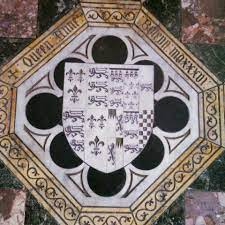 |
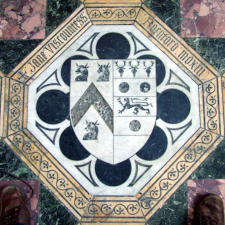 |
But short of a second exhumation and fresh analysis using modern forensics, we will never know.
What we do know is that Anne is buried somewhere in front of the altar in that little chapel.
May she rest there in peace forever.
On 19 May each year, flowers are placed on or near her grave by an anonymous donor.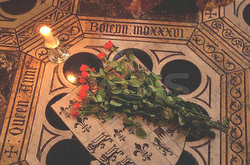
| ≡ | ⇧ |
Her parents
Thomas Boleyn was born around 1477 at Blickling Hall. His childhood is not well documented but in about 1498 he made a hugely advantageous marriage to Elizabeth Howard, the eldest daughter of the 2nd Duke of Norfolk. With Elizabeth he had three surviving children: Mary, Anne and an heir George. He attended the wedding of Prince Arthur to Katherine of Aragon. He was created a Knight of the Bath on the wedding of Henry VIII in 1509. He was made ambassador to the low countries in 1512. All extremely proud moments.Thomas became one of Henry's leading diplomats. Known appointments include:
| • 1511 & 1517: | Sheriff of Kent. |
| • 1512: | One of a party of three envoys to the Netherlands. |
| • 1518‐1521: | ambassador to France, where he was involved in arrangements for the "Field of Cloth of Gold" meeting between Henry and the new French King Francis I in 1520. |
| • 1521 and 1523: | Envoy to Holy Roman Emperor Charles V. |
| • 1527: | One of a large envoy to France. |
| • 1529: | Envoy to a meeting of Holy Roman Emperor Charles V and Pope Clement VII, to seek support for the marriage annulment of Henry VIII and Catherine of Aragon. This was followed by another envoy to France. |
In 1523, Thomas was invested as a Knight of the Garter.
In 1525, when Anne became the focus of the King's attention, Thomas was made Viscount Rochford and, in 1529, he was created Earl of Wiltshire and Earl of Ormond (George became Viscount Wiltshire).
In 1530, Thomas was appointed Lord Privy Seal.
In 1532, his daughter, Anne, was created Marquess of Pembroke in her own right.
On 7th January 1533, his daugher, Anne, was married to King Henry VIII.
On 1st June 1533, Anne was crowned Queen (consort) of England.
And that's as far as Thomas Boleyn's luck went ...
On 2nd May 1536, his son George was arrested for incest with Anne. He was beheaded on 17th May 1536.
On 12th May 1536, Queen Anne was arrested for incest with George and treason. She was beheaded on 19th May 1536.
When Henry discarded Anne in favour of Jane Seymour, Thomas was replaced as Lord Privy Seal and left in disgrace.
He suffered a final indignity when the claims of Piers Butler to the Earldom of Ormond were recognized and Butler again became the Earl from 22nd January 1538.
Also, that year, Thomas lost his wife Elizabeth - she died, probably of depression, on 3rd April 1538.
Thomas himself died on 12th April 1539, doubtless heart-broken and also a deeply depressed man.
| ≡ | ⇧ |
Henry's remorse.
There is some evidence that Henry expressed some remorse at the way he had treated Anne. This he expressed on his death bed in January 1547.Andre Thévet reported:
"... on the twenty-eighth of the month, in the said year[1547], Roy Henry died of this century, having reigned thirty-nine years, the year one thousand five hundred and forty and eight. Several English gentlemen have assured me that he had great repentance for the offenses committed by him against the said Royne Anne de Boullan, falsely defeated and accused of what was imposed on her; and died very good Christian, and was buried according to the ceremonies of the Roman Church ..."
Bishop White Kennett reported:
"Several English gentlemen have confided to me that he has repented, upon his deathbed, of the injustices done to Queen Anne Boleyn; of her having been falsely accused and for the punishment imposed upon her; that she died in good Christian standing and is to be buried in accordance with the Church of Rome. It is in association with this ordeal/situation that he (Henri) has attempted to right these injustices and, with his whole heart, signs his name to this testimony."
| ≡ | ⇧ |
People Involved
There were numerous other people associated with the life and death of Anne Boleyn; some were family members, others were royal, political or religious figures whose loyalty to Anne varied.Before Henry
- Richard III
- Born on 2 Oct 1452 to Richard of York and Cecily Neville.
Reigned from 26 Jun 1483 - 22 Aug 1485.
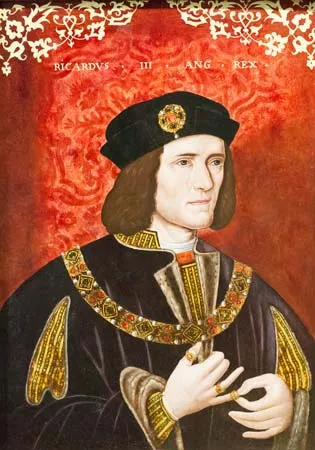
- Edward V
- Born on 2 Nov 1470 to Edward IV and Elizabeth Woodville.
Reigned from 10 Jul 1483 - 19 Jul 1483.

- Henry VII
- Born on 28 Jan 1457 to Edmund Tudor and Margaret Beaufort.
Reigned from 22 Aug 1485 - 21 Apr 1509.
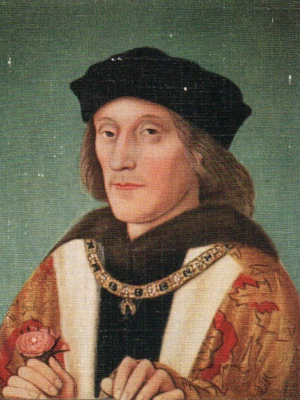
English Royalty
- Henry VIII
- Born on the 28 Jun 1491 to Henry VII and Elizabeth of York
- Reigned from 22 Apr 1509 until 28 Jan 1547
- His elder brother, Arthur, had died in 1502 and Henry married his widow Katherine of Aragon (Catalina de Aragón).
- Charles Dickens, in his book 'A Child's History of England', [1854] wrote:
"... I shall take the liberty to call [him], plainly, one of the most detestable villains that ever drew breath ... He was a big, burly, noisy, smelly, small-eyed, large-faced, double-chinned, swinish-looking fellow in later life ... and it is not easy to believe that so bad a character can ever have been veiled under a prepossessing appearance".
"... The plain truth is, that he was a most intolerable ruffian, a disgrace to human nature and a blot of blood and grease upon the History of England".
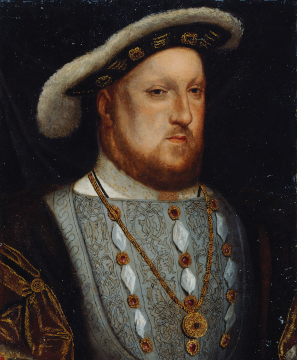
- Mary4
- Henry's sister who married, first, Louis XII of France and, second, Charles Brandon, Duke of Suffolk.
Mary and Brandon were Lady Jane Grey's grandparents
- Katherine of Aragón
- Born on 15 Dec 1485 to Ferdinand II of Aragón and Isabel I of Castile.
Married to Henry's elder brother Arthur on 14 Nov 1501 but he died in 1502.
She married Henry on 11 Jun 1509, was crowned on 24 Jun 1509 and reigned for 24 years.
Despite several pregnancies, she only gave Henry one daughter, Mary (who became 'Bloody Mary' - Queen Mary I).
Loyal to the end, Katherine died on 7 Jan 1536 at Kimbolton Castle. She was Charles V's aunt.
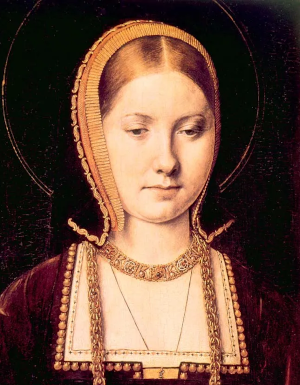
- Lady Mary, formerly Princess Mary
- Mary was born on 18 Feb 1516 to Henry VIII and Katherine of Aragón.
She lost both her legitimacy and her title of Princess when her parents' marriage was annulled in 1533.
She refused to recognise her father's second wife, Anne Boleyn, as queen, saying that she knew of no queen apart from her mother.
She married Prince Philip of Spain in 1554 and became queen consort 2 years later.
After the death of Edward VI, she became the second Tudor woman to be Queen.
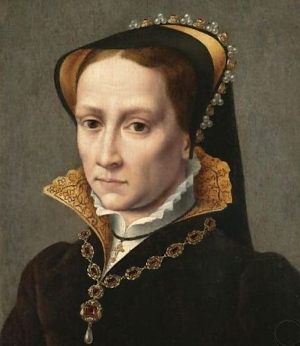
- Anne Boleyn
-
Born in 1501 to Thomas Boleyn and Elizabeth Howard.
She spent time at the courts of Archduchess Margaret of Austria and Queen Claude of France before joining the English court in late 1521 to serve Katherine of Aragón as one of six ladies-in-waiting.
She was elegant, feisty (like Elizabeth Bennett), she appreciated art and architecture, she spoke excellent French, she could dance and play musical instruments, she could play cards and chess. An all-round very attractive girl.
They say that Henry VIII was in love with her by Shrovetide 1526 and in August 1527 he decided to ask the Pope for a dispensation to allow him to marry Anne. The King's Great Matter (Henry's struggle for an annulment of his marriage to Katherine of Aragón) followed and Henry and Anne had to wait seven years to marry.
She was betrothed to the King (it is thought) on 14 Nov 1532 and she married him on 25 Jan 1533.
She was crowned Queen on 1 Jun 1533 and gave birth to a daughter, the future Elizabeth I, on 7 Sep 1533.
Anne was wrongfully executed on 19 May 1536.
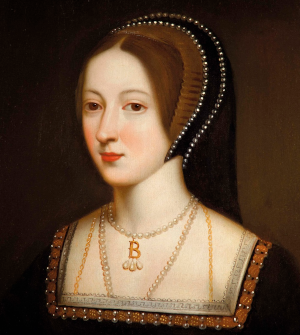
- Princess Elizabeth
- Born on 7 Sep 1533 to Henry VIII and Anne Boleyn.
She was 2 years old when her mother was executed on 19 May 1536 and she was made illegitimate.
She was put in the care of Lady Margaret Bryan.
On 17 Nov 1558, when Quuen Anne died, she becae Queen.
Isn't it ironic that, after all the turmoil of Henry VIII's reign and his desperation for a male heir, that the Tudor dynasty was secured by a woman, Queen Elizabeth I, who reigned for 44 years.
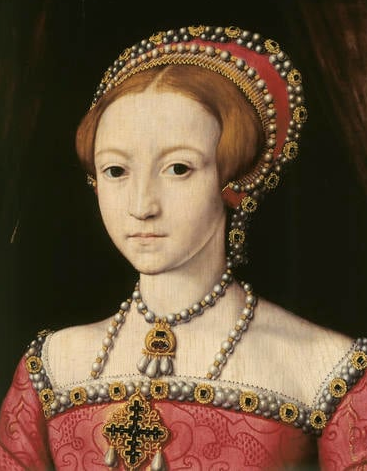
- Jane Seymour
- Born in 1508 or 1509 to Sir John Seymour and Margery Wentworth.
It is thought that she arrived at court around 1529. She served Katherine of Aragón and then Anne Boleyn as a lady‐in‐waiting. - She married Henry on 30 May 1536, gave birth to Edward (who became Edward VI) on 12 Oct 1536 and died 12 days later on 24 Oct 1536.
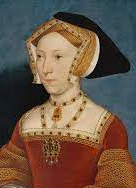
- Edward VI
- Born in 12 Oct 1537 to Henry VIII and Jane Seymour.
Edward was Henry VIII's only legitimate son and reigned briefly from 12 Oct 1547 to 6 Jul 1553.
He was only 9 when he came to the throne and a protectorate was set up and virtually dominated by his uncle, Edward Seymour, Duke of Somerset.
He died on 6 Jul 1553.
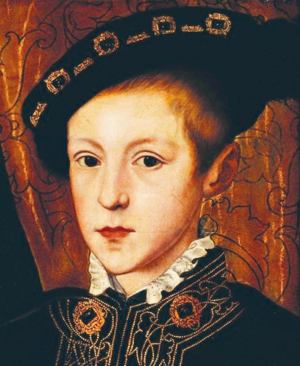
Foreign Royalty
- Isabella I of Castile
- Born on 22 Apr 1451, died 26 Nov 1505
- Katherine's mother
- Ferdinand II of Aragón
- Born 10 Mar 1452, died 23 Jan 1516
- Katherine's father
- Philip II of Spain
- Born 21 May 1527, died 13 Sep 1598
- Husband of Princess Mary.
- Charles V
- The son of Philip the Handsome (son Emperor Maximulian I and Mary of Burgundy) and Joanna of Castile (child of Isabella of Castile and Ferdinand II of Aragón).
Holy Roman Emperor and Archduke of Austria from 1519 to 1556 plus King of Spain from 1516 to 1556, Lord of the Netherlands and titular Duke of Burgundy from 1506 to 1555.
He was heir to, and then head of, the rising house of Habsburg. His dominions in Europe included the Holy Roman Empire, with direct rule over Austrian hereditary lands, the Burgundian Low Countries, Spain and its possessions of Naples, Sicily and Sardinia. In the Americas, he oversaw the continuation of Spanish and German colonizations.
He spent a lot of his reign trying to defend the integrity of the Holy Roman Empire from the Protestant Reformation, the expansion of the Muslim realms of the Ottoman Empire and and a series of wars with France.
In 1508, Charles was given the Order of the Garter by Henry VII. He visited England in 1520 and his aunt, Katherine of Aragón, urged Henry VIII to ally himself to the Emperor.
Charles fought Francis I of France in 1521. His Sack of Rome in 1527 and virtual imprisonment of Pope Clement VII prevented the Pope from annulling the marriage of Henry and Charles' aunt Katherine thus causing Henry to break with Rome.
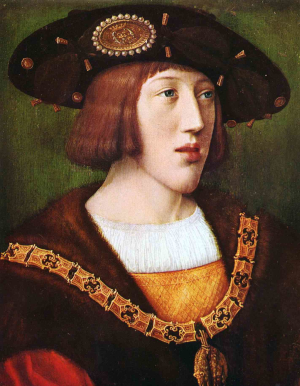
- Francis I
- Born 12 Sep 1494, died 31 Mar 1547
- King of France from 1515 to 1547.
France was encircled by the Habsburg monarchy when Charles V succeeded to the Habsburg Netherlands, throne of Spain and was elected Holy Roman Emperor. Francis sought the support of Henry VIII at the Field of the Cloth of Gold, which was unsuccessful, so he formed a Franco-Ottoman alliance with Suleiman the Magnificent - a controversial liaison between a Muslim and a Christian King at the time.
- Margaret of Austria, Duchess of Savoy
- Born 10 Jan 1480, died 1 Dec 1530
- Anne was sent to Margaret of Austria's court in 1514. Margaret assigned Symmonet as tutor to Anne and it is at that court that Anne will have learnt French, Latin and music together with an appreciation of the arts and architecture.

- Queen Claude of France
- Born on 13th Oct 1499 to Anne of Brittany and Louis XII (Claude had previously been married to Charles VIII).
- Claude's father died on 1 Jan 1515. Her husband, Francis I inherited and Claude became Queen Consort. Anne Boleyn had joined Claude's court in 1514 as a lady-in-waiting. When Francis died, she was made maid of honour and remained there until 1521.
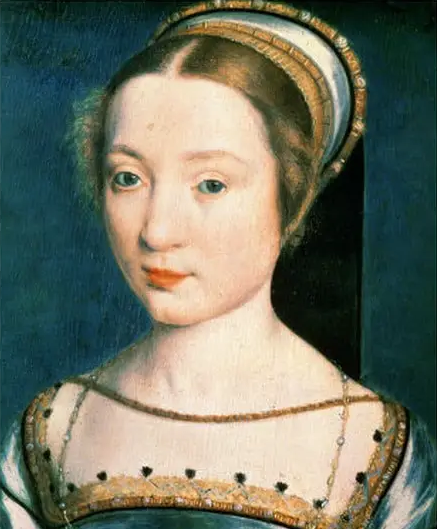
Boleyn Family
- William Boleyn
- Thomas' father.
- His father Sir Geoffrey Bullen had bought Blickling Hall in 1452 and Hever Castle in 1461.
- Margaret Boleyn (née Butler)
- Thomas' mother
- Thomas Boleyn, Earl of Wiltshire and Earl of Ormond - Anne's father
- Born c.1477 to Sir William Boleyn and Lady Margaret Butler. He was the eldest of ten children.
In 1498/99, Thomas Boleyn married Lady Elizabeth Howard.
The couple had at least five children: Mary, Anne, George, Thomas and Henry. Only Mary, Anne and George survived childhood.
Thomas's flair for languages, his probable legal training and his intelligence made him indispensable at court and he served the King as an ambassador, privy councillor and Lord Privy Seal. Thomas was also a Reformer and supported his godson Thomas Tebold in the latter's travels around Europe in 1535 and 1536, spreading the news that Thomas Boleyn was a patron of the new learning and new religion.
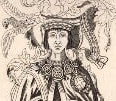
- Mary2 Boleyn
- Born 1500, died 19 Jul 1543
- Anne's elder sister. She married William Carey in 1520. She was lured into becoming the King's mistress. After 5 years or so, she went back to Carey (who died of the 'sweat' in 1528). Thereafter she married William Stafford in 1534 and lived out her life in relative poverty until her father died in 1539.
- William Carey
- Mary3's 1st husband. Esquire of the Body to the King. He died of the 'Sweat' in 1528
- William Stafford
- Mary2's 2nd husband
When Mary became pregnant, she was banned from court; she and William lived in relative penury despite appealing to Anne, the King and Thomas Cromwell
- Jane Boleyn, Lady Rochford (née Parker)
- Born c.1505 to Henry Parker and Alice St John.
She was married to George Boleyn in late 1524 or early 1525.
Jane accompanied her sister-in-law and the King on their visit to Calais in 1532 and served Anne as a lady-in-waiting.
In October 1534, Jane was banished from court temporarily after helping Anne in her attempt to get rid of a "young lady" (Jane Seymour) who had caught the King's eye.
Jane was also the person in whom Anne confided regarding the King's lack of sexual prowess.
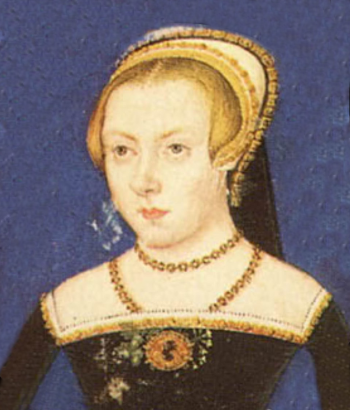
- George Boleyn, Lord Rochford
- Born in c.1504 to Thomas Boleyn and Elizabeth Howard. He was the younger brother of Anne Boleyn.
He was a courtier, poet, diplomat, spoke fluent French, was a royal favourite and member of the King's privy chamber. He was married, unhappily, to Jane Boleyn (née Parker).
- George was influential in Parliament and carried out many important diplomatic missions on behalf of the King. His frequent mention in the privy purse expenses show that he regularly played dice, bowls and cards with Henry VIII and was a member of the King's circle of friends. He was also a zealous reformer and gifted poet.
George was executed on 17 May 1536 after being found guilty of treason and of incest with his sister, Queen Anne Boleyn.
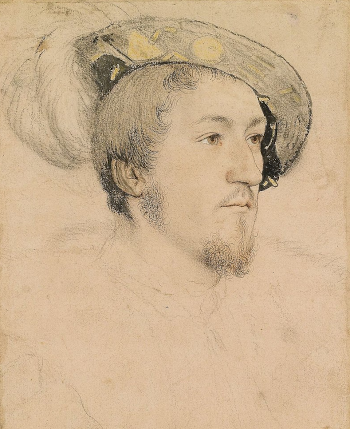
- Elizabeth Boleyn (née Howard)
- Anne's mother - the eldest daughter of Thomas Howard, 2nd Duke of Norfolk
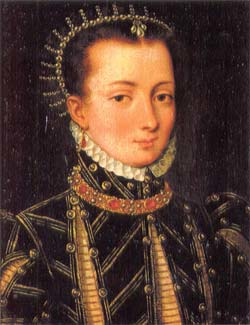
- Elizabeth Boleyn (née Howard)
- Thomas' wife (and Anne's mother)
- Born c.1480 to Thomas Howard and Elizabeth Tilney.
She became Viscountess Rochford in 1525 and, later, Countess of Ormond and Countess of Wltshire.
- Mary Boleyn
- Born in about 1499 to Thomas Boleyn and Elizabeth Howard.
- She is thought to have been one of Henry VIII's mistresses for a time and to have born two children but it has never been established whether they were his or not.
She married William Carey in 1520 and William Stafford in 1534. She is thought to have had a son and daughter with Carey and a son with Stafford.
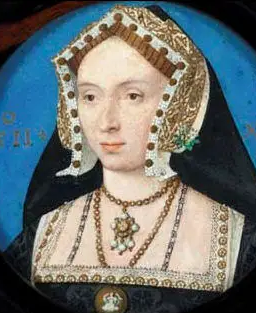
Seymour Family
- Edward Seymour
- Jane's elder brother. He assumed the role of Edward VI's Lord Protector but assumed the virtual rule of England on his own. He was beheaded in early 1552.
- Thomas Seymour
- Jane's younger brother who flirted with the young Princess Elizabeth but ended up marrying Kateryn Parr in 1547 - he tried to enter the King's chambers and shot the King's dog in the garden to stop it barking. Being near the King with a loaded pistol was treated as treason so he was executed on 5 Sep 1548.
Henry's Mistresses
He was elected Knight of the Garter and made Earl of Nottingham and Duke of Richmond and Somerset in 1525. This was followed, by him being made Warden General of the Marches and Lord Admiral of England.
In 1529 he became Lord Lieutenant of Ireland and in October 1532 he accompanied Henry VIII and Anne Boleyn to their meeting with Francis I in Calais.
On 26 Nov 1533, he married Mary Howard, daughter of the Thomas Howard, Duke of Norfolk, and Elizabeth Stafford.

Anne's Beaus
- James Butler
- Anne's arranged Irish husband. The marriage would have combined the titles of Rochford and Ormond but it was called off in 1521 before she met Henry Percy in 1522
- Sir Henry Percy
- Betrothed to Anne but forbidden to marry her by his father, Henry Percy 5th Earl, Thomas Wolsey and the King.
Anne hated Wolsey from then on but it is thought there was some reconciliation later.
- Mary Talbot
- Henry Percy's wife. He was made to marry her after he had been forbidden to marry Anne. It was not a happy marriage.
Supposed adulterers
- Mark Smeaton
- Court musician who was accused of adultery with Anne, 'admitted' it under torture, and was executed on 17 May 1536.
His 'admission' sealed the fates of Norris, Brereton, and Weston as well as Anne's even though she was not at many of the places where she was supposed to have committed adultery.
- William Brereton (see Sir William Brereton)
- Member of the prominent Chesire family and Courtier who was accused of adultery with Anne and executed on 17 May 1536
- Sir Henry Norris
- Sir Henry Norris was the son of Richard Norris. He married Mary Fiennes sometime before 1526 and the couple had three children before Mary's death circa 1530. Norris was Henry VIII's Groom of the Stool and was one of the King's best friends. By 1536, he was courting Anne Boleyn's cousin, Margaret Shelton.
- Sir Francis Weston
- Sir Francis Weston was the son of Sir Richard Weston and Anne Sandys, a former lady-in-waiting to Katherine of Aragón. He became a Gentleman of the Privy Chamber in 1532 and was a popular courtier and member of the Boleyn circle.
Pro-Anne
- Henry Percy, 6th Earl of Northumberland
- Born c.1502, Henry Percy to Henry Algernon Percy, fifth Earl of Northumberland, and of Katherine Spencer.
He was brought up in Cardinal Wolsey's household and it was while he was there that he fell in love with Anne Boleyn on her return to the English court in late 1521.
However, his father had already planned for Percy to marry Mary Talbot and Anne was meant to be marrying James Butler.
As a consequence, Wolsey and Percy's father put a stop to the relationship between Percy and Anne Boleyn and Percy married Mary Talbot in 1524.
- William Latymer
- Born in 1499 to William Latymer and Anne Bokinge.
He read canon law and arts at Corpus Christi College, Cambridge, where he met Reformers like Matthew Parker. It is thought that Latymer was probably introduced to Anne Boleyn by Parker, who became one of Anne Boleyn's chaplains. In 1536 he was approached by Tristram Revell, a student of Cambridge, who wanted Anne's patronage for his translation of “Farrago rerum theologicarum”. Latymer told Anne of the work but she refused to support it, probably because it was too radical for the vulnerable queen to be linked with at that time. In the spring of 1536, Latymer was in the Low Countries sourcing evangelical books for the Queen.
- Thomas Audley, Lord Chancellor
- Thomas Audley was born around 1487/8 in Earls Colne, Essex. He came to the attention of Henry VIII in 1523 after taking Cardinal Wolsey's side in Parliament when Sir Thomas More defended the rights of the common people. He rose quickly from that point, and on 20 May 1532 he was knighted and made keeper of the great seal after Sir Thomas More resigned as Lord Chancellor. On 26 Jan 1533, he was officially named as Lord Chancellor. Audley is thought to have been responsible for smoothing the passage through Parliament of legislation regarding the King's break with Rome and the supremacy.
- Sir Richard Page
- Born 1474, died 1548
- A gentleman of the privy chamber from 1516 and a man who started his court career in the employ of Cardinal Wolsey.
Page worked in the household of Henry Fitzroy (Henry VIII's illegitimate son) and devised arms for him.
He was a close associate of Anne Boleyn and was arrested on 8 May 1536 but Cromwell had him released (with Wyatt) in June.
- John Skip
- He was a Norfolk man who studied at Gonville Hall, Cambridge, where he became a member of a group of Reformers who met at the White Horse tavern. He supported the King's annulment and became chaplain and almoner to Queen Anne Boleyn in 1535.
Anti-Anne
- Thomas Cromwell
- Born in 1485 to Walter Cromwell, (blacksmith, cloth merchant and fuller).
He studied law and was fluent in French, Italian and Latin, which helped him to become employed by Cardinal Wolsey in around 1514. After Wolsey's fall, and due partly to the patronage of Anne Boleyn, Cromwell quickly rose to be the King's right hand man. He helped the King to:- get his marriage to Katherine of Aragón annulled
- dissolve the monasteries
It's unclear whether Cromwell instigated the plot to execute Anneor whether he simply carried out the King's wishes. Either way, it certainly suited him to get rid of some other poitical figures at the same time.
- Eustace Chapuys, Imperial Ambassador
- He became a doctor of civil and canon laws after studying at Turin University.
By August 1526 he was the Duke of Bourbon's ambassador to Charles V's court in Granada.
In the summer of 1527, after the death of the Duke of Bourbon in the sack of Rome, Chapuys joined the imperial service, working under Nicholas de Perrenot.
He arrived in England in September 1529 to begin working as Katherine of Aragón's adviser in negotiations regarding the annulment. He was her link to the Emperor and to Rome.
He detested Anne Boleyn, never referring to her by name but as "the concubine" or "the putain" [whore].
- Thomas Howard, 3rd Duke of Norfolk
- Thomas Howard, 3rd Duke of Norfolk (1473-1554) Thomas Howard was the eldest son of Thomas Howard, 2nd Duke of Norfolk, and of Elizabeth Tilney. He was the brother of Elizabeth Boleyn (née Howard) and so was uncle to Anne Boleyn. Howard's father and grandfather had fought on Richard III's side at the Battle of Bosworth but Howard was able to work his way back into royal favour by fighting for the Crown against both the Cornish rebels and the Scots in 1497. He was made a Knight of the Garter in 1510, was created Earl of Surrey in 1514 and succeeded his father as Duke of Norfolk in 1524. In September 1514 he was prominent in leading the English army in defeating the Scots at the Battle of Flodden. In the 1520s, he clashed with Cardinal Wolsey over foreign policy ‐ he preferred war and Wolsey preferred diplomacy ‐ and was involved with the Duke of Suffolk's and the Boleyn family's push for Wolsey to be removed from power. In the 1530s, Norfolk carried out diplomatic missions and advised the King on the situation in Ireland. As Lord Steward of England, he presided over the trials of Anne and George Boleyn, his niece and nephew in May 1536.
- Charles Brandon, Henry's brother-in-law
- Charles Brandon was one of Henry VIII's best friends. He was born circa 1484 to Sir William Brandon and Elizabeth Bruyn, and his father died carrying Henry VII's standard at the Battle of Bosworth in 1485. It is thought that Brandon grew up in the household of his uncle, Sir Thomas Brandon, a leading courtier in the reign of Henry VII. By 1507, Brandon himself was serving the King as an esquire of the body. Although he was seven years older than Henry VIII, Brandon became the King's lifelong friend, and was made Duke of Suffolk in 1514. He was forgiven for marrying the King's favourite sister, Mary Tudor, Queen of France, in 1515, without the King's permission. The couple had four children: Henry, Frances, Eleanor and a second Henry after the death of their first son. Mary died in June 1533 and their second son died in 1534. Brandon married for the fourth time in September 1534; his new wife was his 14 year old ward, Catherine Willoughby. Brandon had poor relations with Anne Boleyn, his sympathy being with Katherine of Aragón.
- Sir Nicholas Carew
- Born 1496, died 3 Mar 1539 to Sir Richard Carew and Elizabeth Bryan.
Carew was brought up at court and was serving the King as a groom of the privy chamber by 1511. In 1515 he became an esquire of the body and in 1518 he became a gentleman of the privy chamber.
His wife, Elizabeth, was the daughter of Sir Thomas Bryan, vice chamberlain of Katherine of Aragón, and of Lady Margaret Bryan who was governess to the Princess Mary and then to Princess Elizabeth.
In 1535 he sheltered the King's fool who had angered the King by calling Anne Boleyn "a ribald" and the Princess Elizabeth "a bastard". He thus showed his clear sympathy with the Catholic conservatives, Katherine of Aragón and the Lady Mary.
- Sir William Brereton
- Sir William Brereton was the sixth son of a leading, landowning Cheshire family and himself became an important man in Cheshire and North Wales. He was married to Elizabeth Savage, daughter of Charles Somerset, 1st Earl of Worcester. He had a colourful reputation and was not a member of the Boleyn circle of friends.
- Sir William Courtney
- Born 1477, died Nov 1535
- Esquire of the Body. Cromwell's enemy
- Henry Courtenay - Marquis of Exeter
- Born c.1498-9 to William Courtenay, Earl of Devon, and of Katherine, daughter of Edward IV and Elizabeth Woodville.
In 1519 he married his second wife, Gertrude Blount, daughter of William Blount, fourth Baron Mountjoy, the Queen's chamberlain. Gertrude was a pious Catholic, associated with Elizabeth Barton, the Nun of Kent, and both Henry and Gertrude were religious conservatives whose sympathies lay with Katherine of Aragón.
- Elizabeth Fitzgerald
- Born 1527, died Mar 1590
- (née Grey) was the daughter of Thomas Grey, first Marquess of Dorset, and of Cicely Bonville. She was the widow of Gerald Fitzgerald, ninth Earl of Kildare, who died in 1534. In 1536 she was a supporter of the Lady Mary.
Religious
- William Warham
- Archbishop of Canterbury from 1503 until his death on 22 Aug 1532.
He helped to arrange the marriage between Henry and Katherine and, in 1509, he presided over their wedding.
- Thomas Cranmer, Archbishop of Canterbury
- Thomas Cranmer was born in Nottinghamshire in 1489 to Thomas and Agnes Cranmer. At the age of 14 he attended Jesus College, Cambridge, where he studied for a Bachelor of Arts degree, followed by a Masters. He was then elected to a fellowship but had to relinquish this when he married. Unfortunately, his wife, Joan, died in childbirth. He married his second wife, Marguerite, in 1532. In 1526, Cranmer was awarded a Doctorate of Divinity and from 1527 he was involved in the proceedings to get Henry VIII's first marriage to Katherine of Aragón annulled. He was consecrated as Archbishop of Canterbury on 30 March 1533 and opened a special court for the annulment proceedings on 10 May 1533. On 23 May, Cranmer ruled that the marriage between Henry VIII and Katherine of Aragón was against the will of God, the marriage was declared null and void. Five days later, on 28 May, Cranmer declared the marriage between Henry VIII and Anne Boleyn valid and on the 1st June he crowned Anne Boleyn Queen of England. In September 1533, he had the pleasure of baptising the couple's daughter, Elizabeth, and becoming her godfather.
He wrote the first Book of Common Prayer. He was imprisoned by Mary I (for treason and heresy) and made to reconcile himself to the Cathlic Church. On 21 Mar 1556 he was burned at the stake but on that day he withdrew his recantations and died a heretic to the Catholic Church and martyr to the principles of the English Reformation.
- Clement VII
- Born 26 May 1478 (Giulio de' Medici), died 25 Sep 1534
- The Pope - head of the Catholic Church and ruler of the Papal States from 19 Nov 1523 until his death.
Clement was personally respectable and devout but he faced unprecedented challenges: Martin Luther's Protestant Reformation, a power struggle in Italy between Holy Roman Emperor Charles V and France's Francis I, Turkish invasions of Eastern Europe lead by Suleiman the Magnificent and Henry VIII's contentious marriage annulment resulting in England breaking away from the Catholic Church.
- Cardinal Reginald Pole
- Born 12 Mar 1500, died 17 Nov 1558
- The last Roman Catholic Archbishop of Canterbury holding office from 1556 to 1558.
Henry offered him the Archbishopric of York or the Diocese of Winchester if he would support the annulment of his marriage to Katherine of Aragón. Pole advised the King on the political difficulties of an annulment. He then witheld his support and placed himself in self-imposed exile in France and Italy in 1532. In 1536, Pole finally and decisively broke with the King.
- Matthew Parker
- Born 6 Aug 1505, died 17 May 1575
- English bishop and Archbishop of Canterbury from 1559 to his death. He was an influential theologean and co-founder (with Thomas Cranmer and Richard Hooker) of a distinctive tradition of Anglican thought. He was one of the primary architects of the 'Thirty-Nine Articles'.
He precided over the Elizabethan religious settlement in which the Church of England maintained a distinct identity apart from Roman Catholicism and Protestantism.
Other courtiers
- Henry Pole - Baron Montagu
- was the eldest son of Sir Richard Pole and of Margaret Plantagenet, daughter of George, Duke of Clarence. His mother, Margaret Pole, was the Countess of Salisbury. She was a member of Katherine of Aragón's household and godmother and governess of the Lady Mary. His brother was Cardinal Reginald Pole. The family's sympathies lay with Katherine of Aragón.
- Matthew Parker (1504-1575)
- Matthew Parker was born in Norwich on 6 Aug 1504 and was educated at Corpus Christi College in Cambridge, where he became friends with a group of Reformers and was linked to Lutheran Thomas Bilney. He became one of Queen Anne Boleyn's chaplains in 1535, and Anne's patronage led to him being appointed Dean of the collegiate church of Stoke by Clare in Suffolk.
- Sir Thomas Wyatt
- “the Father of English Poetry”, was born in 1503 at Allington Castle, Kent. He was the son of Sir Henry Wyatt and Anne Skinner. In 1520, Wyatt married Elizabeth Brooke, the daughter of Lord Cobham. In 1521, the couple had a son, Thomas Wyatt the Younger. In 1524, Wyatt followed his father's example and started a career at court as Clerk of the King's jewels. In 1525 he was made Esquire of the Body and he went on to become an ambassador, undertaking many foreign missions for King Henry VIII. He served Anne Boleyn at her coronation in 1533 and was knighted in 1535.
- Sir Francis Bryan
- Born 1490, died 2 Feb 1550
- Chief Gentleman of the Privy Chamber. He always retained the King's favour by changing his opinions to match those of the King. His rakish sexual life and his lack of principle at the time of Anne's downfall earned him the nickname “The Vicar of Hell”.
- Sir William Kingston
- Nothing is known of the early life of Sir William Kingston or of his first two marriages, but by 1534 he had married Mary Scrope, daughter of Richard Scrope and the widow of Edward Jerningham of Suffolk.
From 1497-1509, he served Henry VII as a yeoman of the chamber and was a gentleman usher at the King's funeral. In the early years of Henry VIII's reign he served as a soldier and was knighted for his part in the Battle of Flodden. He served on the jury at the trial of the Duke of Buckingham in 1521 and benefited from his fall.
He represented Gloucestershire in the Parliaments of 1529 and 1536, and accompanied the King and Anne Boleyn to Calais in 1532.
He was Constable of the Tower of London from 28 May 1524 until his death.
Anne's jailor
The victims
- Anne Boleyn was executed on 19 May 1536
On the 17 May, five other people had been executed as well:
- George Boleyn
- Sir Henry Norris
- Sir Francis Weston
- William Brereton (see Sir William Brereton)
- Mark Smeaton
- The executioner
- He was known as the Executioner from Calais and he always used a sword in preference to an axe for beheadings.
After Henry
- Edward VI
- Born on 12/10/1537 to Henry VIII and Jane Seymour
Reigned 28/1/1547 - 6/7/1553.
- Lady Jane Grey, (Queen Jane)
- Born on --/10/1537 to Henry Grey, 1st Duke of Suffolk and.
Reigned 10/7/1553 - 19/7/1553.
So, only 16 when she and her husband were executed!
- Mary I, ('Bloody Mary')
- Born on 18/2/1516 to Henry VIII and Katherine of Aragón.
Reigned 20/7/1553 - 17/11/1558.
- Elizabeth I
- Born on 7/9/1533 to Henry VIII and Anne Boleyn
Reigned 17/11/1558 - 24/3/1603.
- James I
- Born on 19/6/1566 to Mary Queen of Scots and Lord Darnley.
Reigned 24/3/1603 - 27/3/1625.
| ≡ | ⇧ |
Residual evidence
After Anne's execution, the King tried to eradicate all evidence of her existence and she was effectively 'rubbed out' until Elizabeth I came to the throne and made some attempts to restore the image and reputation of her mother.There are precious few items left that indicate Anne even existed but there are few tucked away:
At Hampton Court Palace
Anne's initials with Henry's above the Queen Anne Gate at Hampton Court.
Sometimes as 'AH' ...
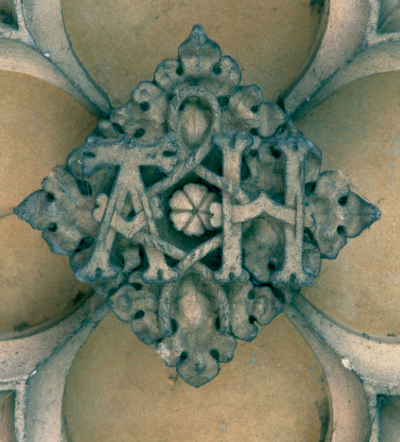
... and sometimes as 'HA' ...
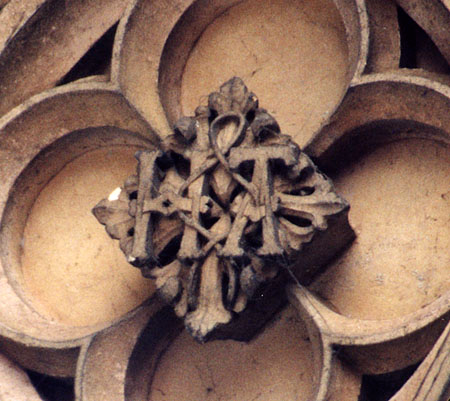
A set of initials on a panel at the back of the Great Hall - this time with the 'H' and the 'A' inter-twined.
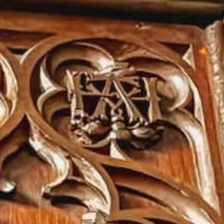
A stone carving of her crest. This is on the ceiling of the Great Hall.
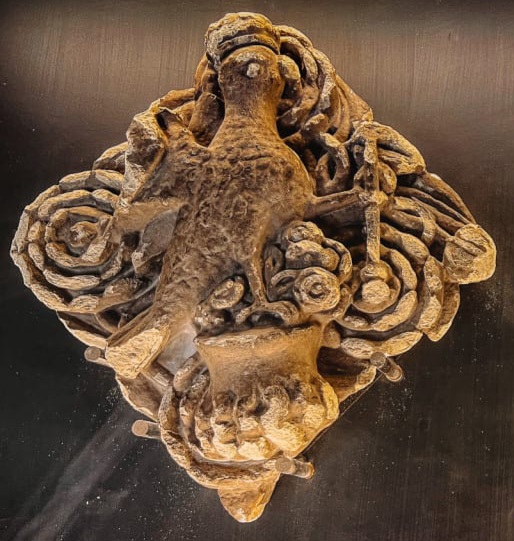
There is a painting of her in the gallery of Henry VIII's apartments (probably dating from Elizabeth I's reign).
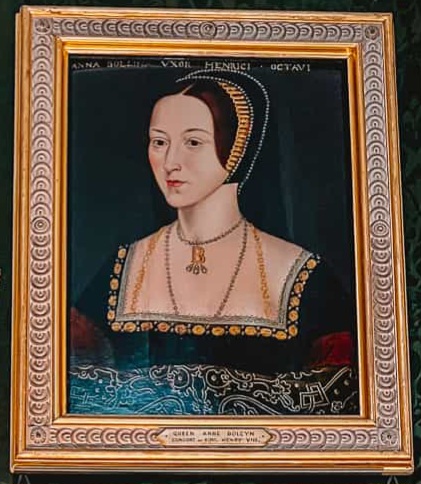
A picture of her crest. It is believed that this rare heraldic badge was part of the hammerbeam ceiling in the Great Hall.
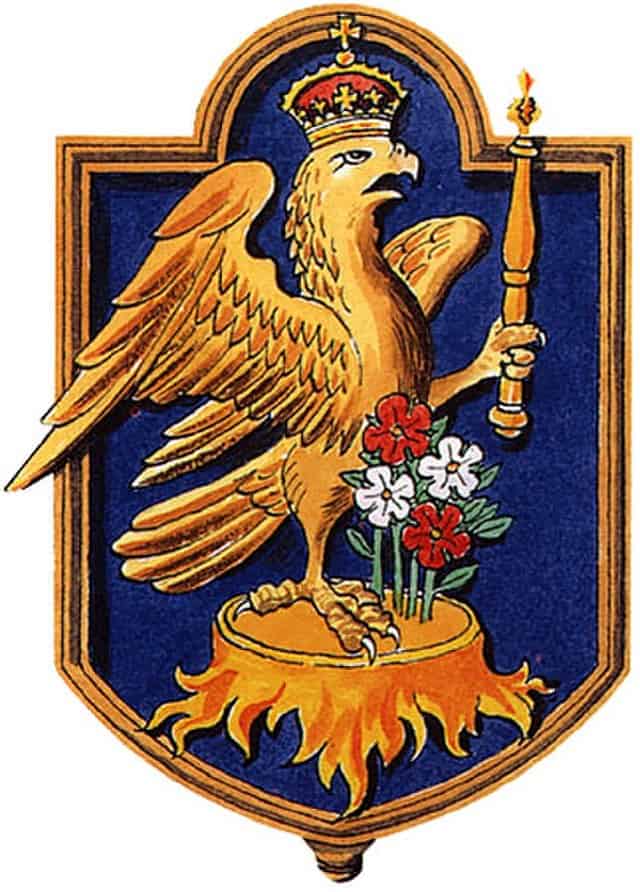
The stained glass window in the Great Hall has a Victorian memorial to all six of Henry's wives. Anne's window is where the sun rises.
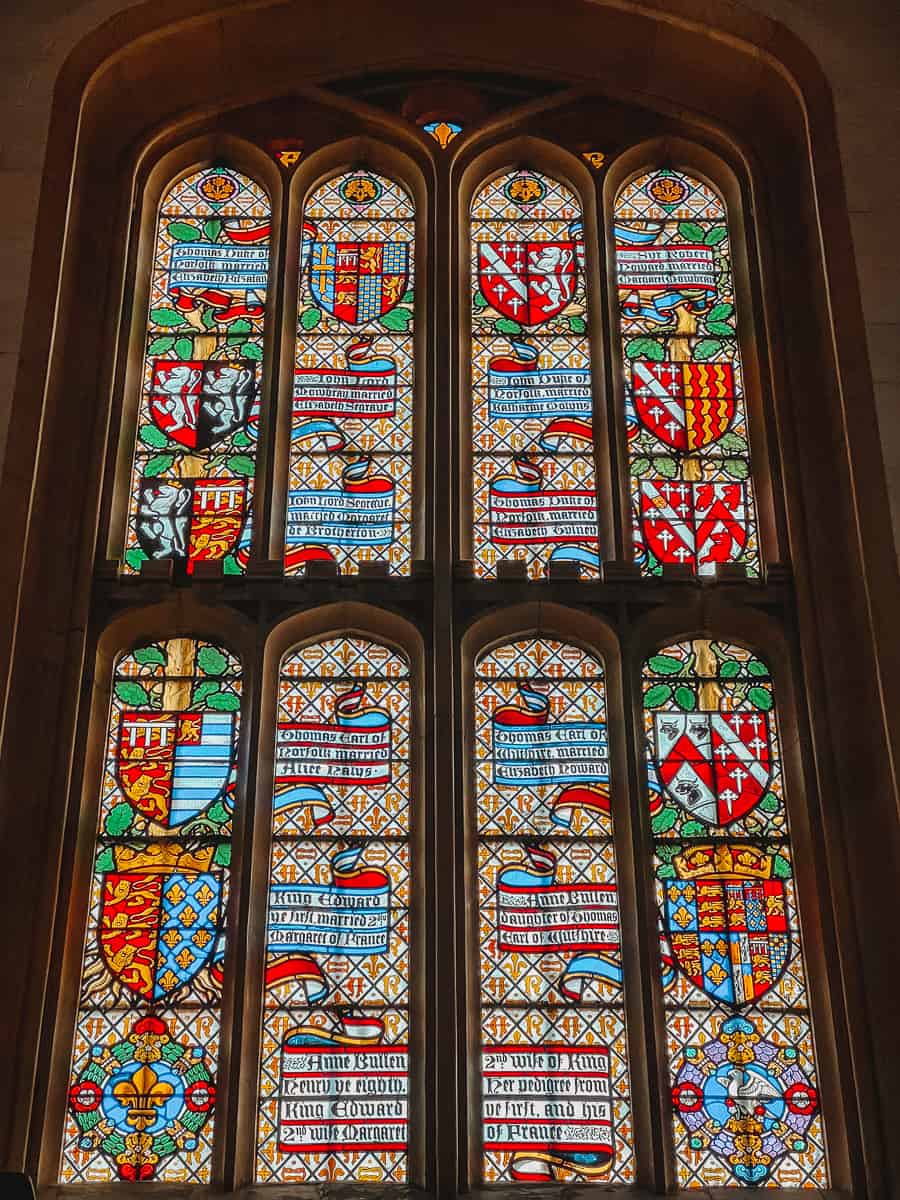
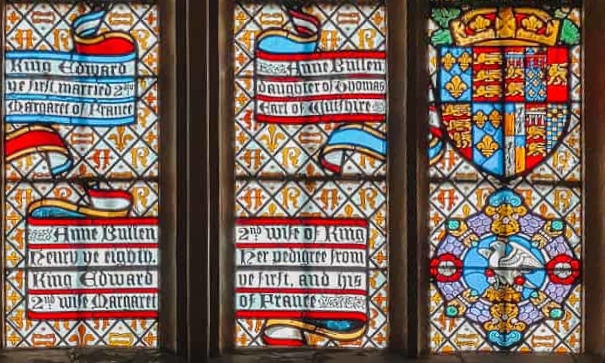
| “Anne Bullen |
| daughter of Thomas |
| Earl of Wiltshire” |
| Anne Bullen | | | 2nd wife of King |
| Henry ye eighth. | | | Her pedigree from |
| King Edward | | | ye first, and his |
| 2nd wife Margaret | | | of France |
A timber falcon thought to have come from the Great Hall roof.
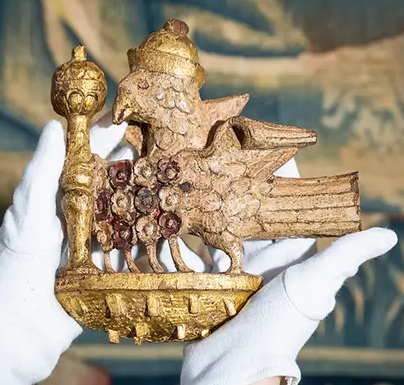
| ≡ | ⇧ |
At the Tower of London
Anne's initials and part crest are carved in the wall of the Beauchamp Tower.
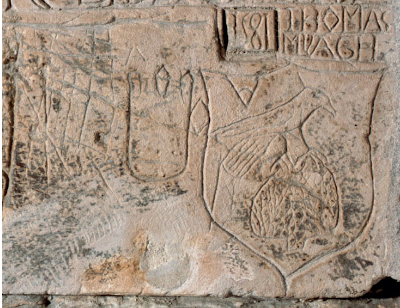
Anne's name 'boullen' is on the wall in the Martin Tower. It can't have been carved by her but it's possible that it wa carved by George whilst he was in the Tower from 2nd May to 17th May 1536.
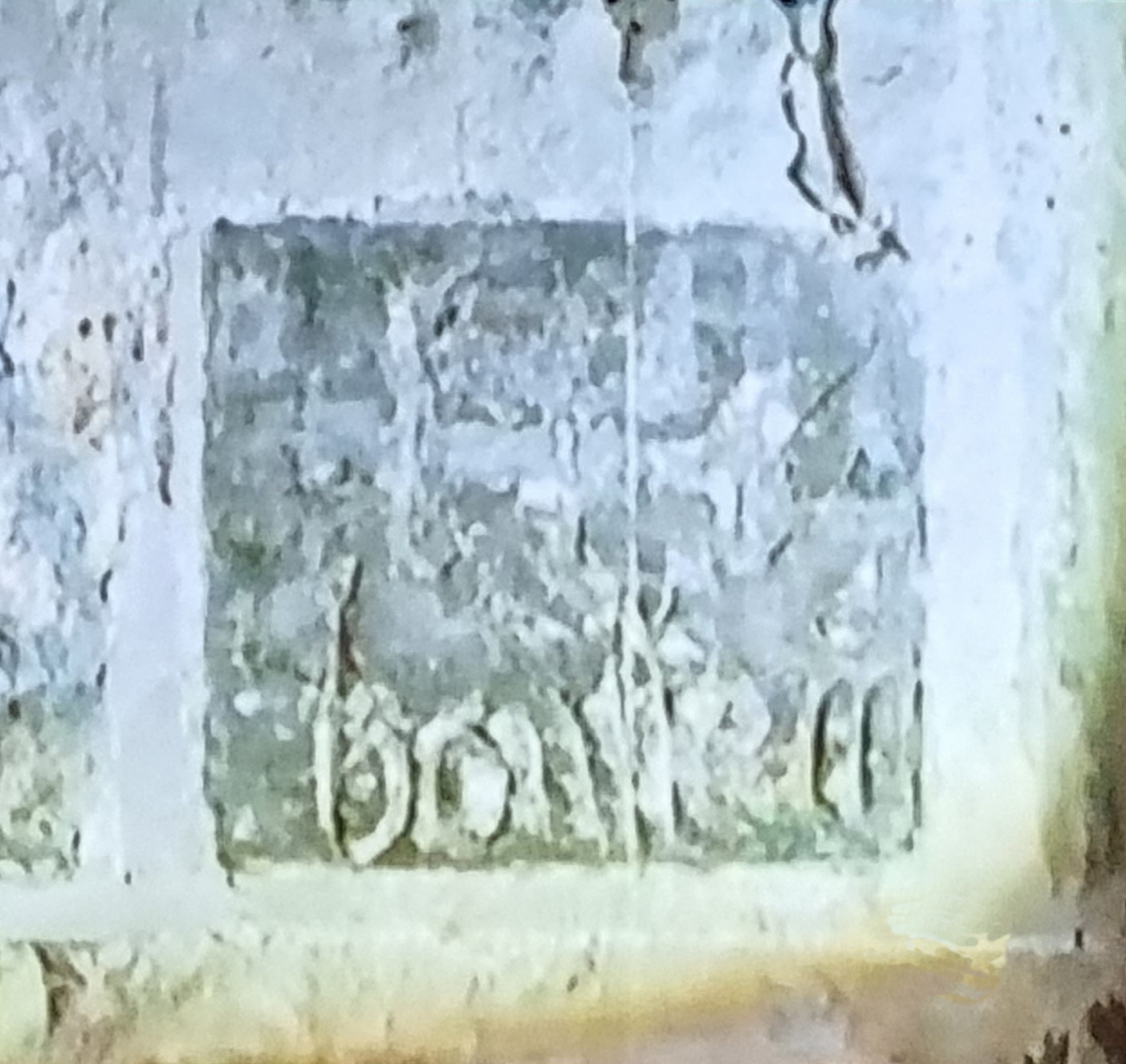
| ≡ | ⇧ |
At King's College Chapel, Cambridge
Anne's initials on a timber screen in the chapel.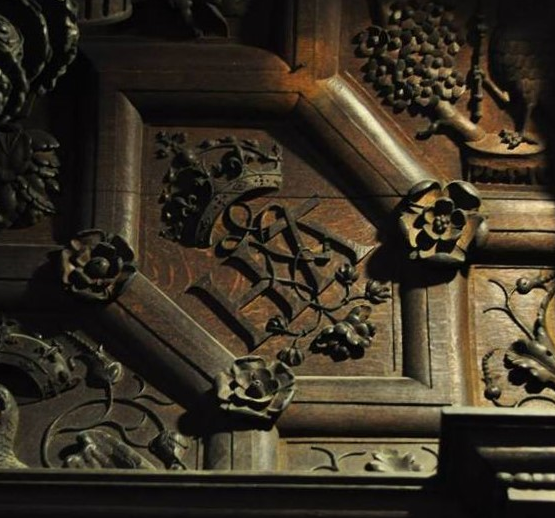
The Boleyn bull on a timber screen in the chapel.
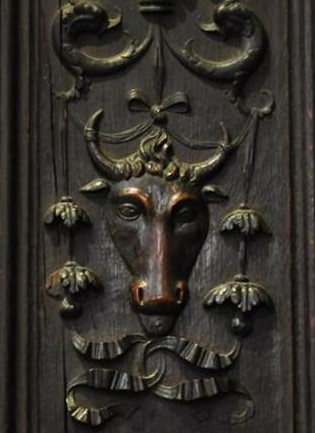
| ≡ | ⇧ |
Books of Hours
In Tudor times many people had prayer books called 'Hours' books. There are four known 'Hours' books which relate to Anne Boleyn:- Book 1
- This is a book written in Bruges between 1410 and 1450 and now held at Hever Castle.
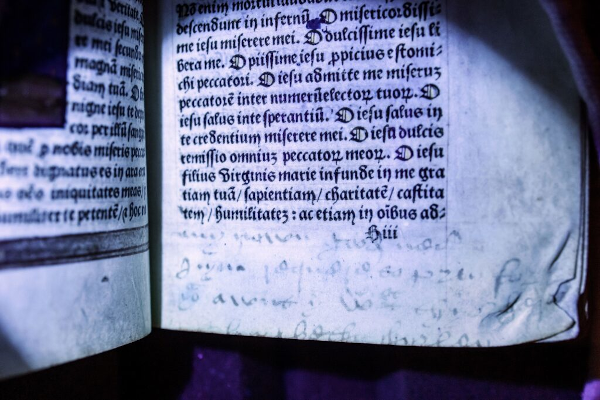
- Extraordinarily, it has some notes in Anne's handwriting. She wrote, in French:

“Le temps viendra [the time will come]
Je Anne Boleyn”
- Book 2
- The second book is also at Hever Castle but was a slightly cheaper book printed in Paris by Germain Hardouin in 1527. However, Anne's copy was a better quality production being printed on vellum instead of paper. It was part of a set made for Henry's first wife, Katherine of Aragón, in the 1520s. It would have been given to Anne when she served as Katherine's lady-in-waiting.
- She also wrote in this book but in English:
"Rem̄eber me when you do pray
that hope dothe led from day to day
Anne Boleyn"
Note: the deliberate macron over the 'm' indicates that another 'm' has been left out.
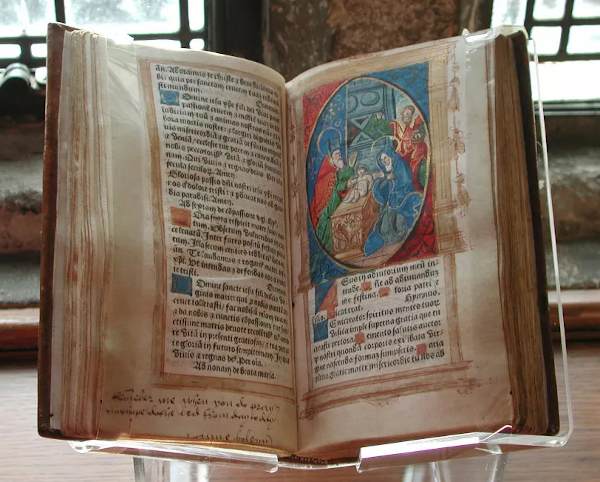
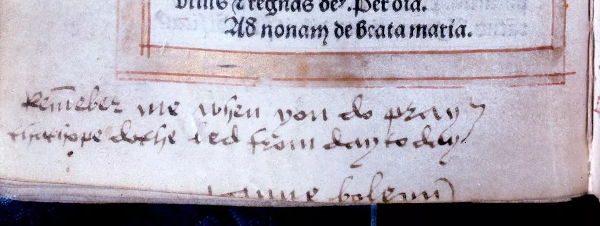
- Book 3
- This is a very high quality book made at the end of the 15th century and it's held in the British Library.
In it, Henry wrote to Anne: - and Anne replied on a different page:

"Si silon mon affection la sufvenance sera
en voz prieres ne seray yers oblie
car vostre sui Henry R. a jammays"
[If you remember my love in your prayers as strongly as I adore you,
I shall hardly be forgotten, for I am yours,
Henry R forever]
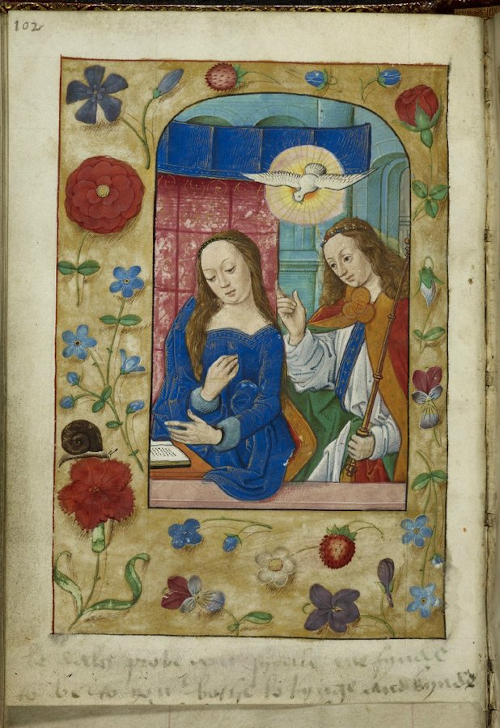
Be daly prove you shall me fynde,
To be to you bothe lovynge and kynde.
[By daily proof you shall find
me To be to you both loving and kind].
- Book 4
- This is a copy of Book 2 and it is held in the Morgan Library, New York. The book belonged to Katherine of Aragón (she had passed it to Margaret Coke who was one of her ladies-in-waiting. In it, she wrote:
"thys boke was good quen Katrin boke"
- Book 5
- This book is a copy of Book 2, held at Cambridge University, but belonging to Thomas Cromwell
There are three remarkable things about these books:
- that they still exist
- that Katherine of Aragón and Anne Boleyn both kept identical copies of the same book
- that there are four newly found inscriptions in one of them which show that the book was held in secret by close friends of Anne's.
How or why Anne and Katherine had the same prayer book is not known. They must have bought or been given copies. Anne's book was more elaborately illuminated than Katherine's but they both had copies of the same book nonetheless. Anne had been a lady-in-waiting for Katherine and it may be that the two women, two Queens, two mothers, and two wives of a highly volatile man, were much closer, at least in the quietness of prayer, than anyone has previously supposed.
| ≡ | ⇧ |
New findings
Anne had written notes in her Books of Hours held at Hever Castle and she had written messages to Henry in the book held at the British Library. But, in 2022, Kate McCaffrey,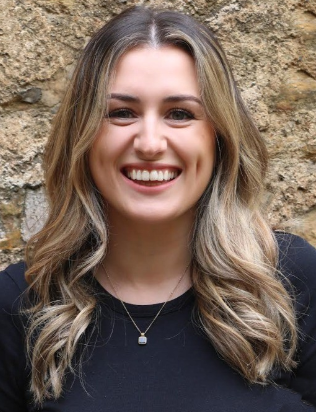 |
 |
who is Assistant Curator at Hever Castle, published some remarkable findings. In a Book of Hours belonging to Anne, Kate found some inscriptions, not seen before and she found them using UV light.
The texts haven't been fully deciphered yet, as they were deliberately obscured after Anne's death but, in amongst them, Kate found four family names: Gage, West, Shirley, and Guildford. The signatories were relatives of Elizabeth Hill, a childhood friend of the Boleyns, who was part of her household at court. Mary Hill, the granddaughter of Elizabeth Shirley (an author of a newly uncovered inscription in Anne's book), married John Cheke (the childhood tutor of Elizabeth I) and became and remained a close friend of Elizabeth's until the queen's death in 1603. It is an attractive possibility that more than twenty years after Anne's execution and during the reign of her daughter Elizabeth, Mary Hill was able to share Hever's Hours with the Queen and Elizabeth could view her mother's signed inscription.
This is the extended Guildford family, although not all descendants have been included. Names found in Anne's Book of Hours are in red.
| Sir Richard Guildford (b. 1455) | |||||||||||||||||||||||||||||||||
| m1. ~1473. Anne Pympe | |||||||||||||||||||||||||||||||||
| ➥ | Thomasin Guildford (b.1460) | ||||||||||||||||||||||||||||||||
| ➥ | Sir Edward Guildford (b.1474) | ||||||||||||||||||||||||||||||||
| ➥ | Sir George Guildford (b.1477) | ||||||||||||||||||||||||||||||||
| | | m. Mary West (née Guildford) = Sir Owen West | ||||||||||||||||||||||||||||||||
| | | ➥ | Mary Poynings (née West) | |||||||||||||||||||||||||||||||
| | | | | m1. Sir Adrian Poynings | |||||||||||||||||||||||||||||||
| | | | | m2. Sir Richard Rogers | |||||||||||||||||||||||||||||||
| | | ➥ | Anne West | |||||||||||||||||||||||||||||||
| ➥ | Mary Haute (née Guildford) (b.1478) | ||||||||||||||||||||||||||||||||
| | | m1. Christopher Kempe | ||||||||||||||||||||||||||||||||
| | | m2. Sir William Haute | ||||||||||||||||||||||||||||||||
| ➥ | Philippa Gage (née Guildford) (b.1479) | ||||||||||||||||||||||||||||||||
| | | m. Sir John Gage | ||||||||||||||||||||||||||||||||
| | | (Comptroller of the Royal Household) | ||||||||||||||||||||||||||||||||
| | | (Constable of the Tower) | ||||||||||||||||||||||||||||||||
| | | ➥ | Alice Gage | |||||||||||||||||||||||||||||||
| ➥ | Frideswide Browne (née Guildford) (b.1480) | ||||||||||||||||||||||||||||||||
| | | m. Sir Matthew Browne | ||||||||||||||||||||||||||||||||
| ➥ | Sir Henry Guildford (b. ~1489) | ||||||||||||||||||||||||||||||||
| ➥ | Elizabeth Shirley (née Guildford) (b. ~1490) | ||||||||||||||||||||||||||||||||
| | | m1. Sir Richard Shirley | ||||||||||||||||||||||||||||||||
| | | m2. Sir Thomas Isley (m. ~1500) | ||||||||||||||||||||||||||||||||
| | | ➥ | Elizabeth Isley (née Guildford) (b.1510) | |||||||||||||||||||||||||||||||
| | | | | m. Richard Hill (b. ~1505) | |||||||||||||||||||||||||||||||
| | | | | (was Sergeant of the King's Cellar) | |||||||||||||||||||||||||||||||
| | | | | ➥ | Mary Hill (b.1532) | ||||||||||||||||||||||||||||||
| | | | | | | m1. John Cheke | ||||||||||||||||||||||||||||||
| | | | | | | (was tutor to Elizabeth I) | ||||||||||||||||||||||||||||||
| | | | | | | m2. Henry MacWilliam | ||||||||||||||||||||||||||||||
| | | m3. Sir William Stafford | ||||||||||||||||||||||||||||||||
| m2. Joan Vaux | |||||||||||||||||||||||||||||||||
| ➥ | Sir Henry Guildford | ||||||||||||||||||||||||||||||||
| | | (Comptroller of the Royal Household) | ||||||||||||||||||||||||||||||||
| | | (Master of the Horse) | ||||||||||||||||||||||||||||||||
| ≡ | ⇧ |
Sherland Hall
In a field next to Shurland Hall on the Isle of Sheppey, a detectorist has made an extremely rare find. It was a heavy gold signet ring which has the Boleyn's bull emblem on it and it has been dated to the early 1500s. Henry and Anne went to Sherland in October 1532 on their way to Calais but the ring is almost certainly not Anne Boleyn's; it's far too big; it's really a man's ring.
In 1066 the land was given to Baron de Shurland by William the Conqueror, whereupon he built the first Shurland fortress. In the 1500s Sir Thomas Cheyney rebuilt it as a major walled manor house in fine red brick with stone dressings and courtyards to guard the entrances to the Thames and Swale from foreign Naval attempts to invade England. Sir Thomas played host at Shurland Hall to Henry and Anne in October 1532. Fifty years later, ownership passed to Anne’s daughter Queen Elizabeth, who increased the garrison. With octagonal towers and battlements, Shurland is reminiscent of the gatehouse at Hampton Court.
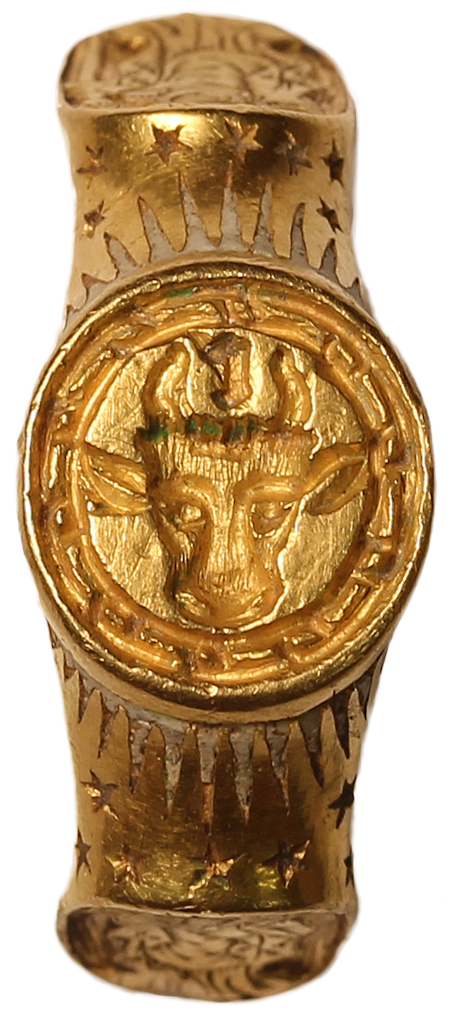
On the seal face is a bull's head with the reversed letter 't' (Thomas?) or 'r' (Rochford) meaning it could possibly have belonged to Thomas or George Boleyn.
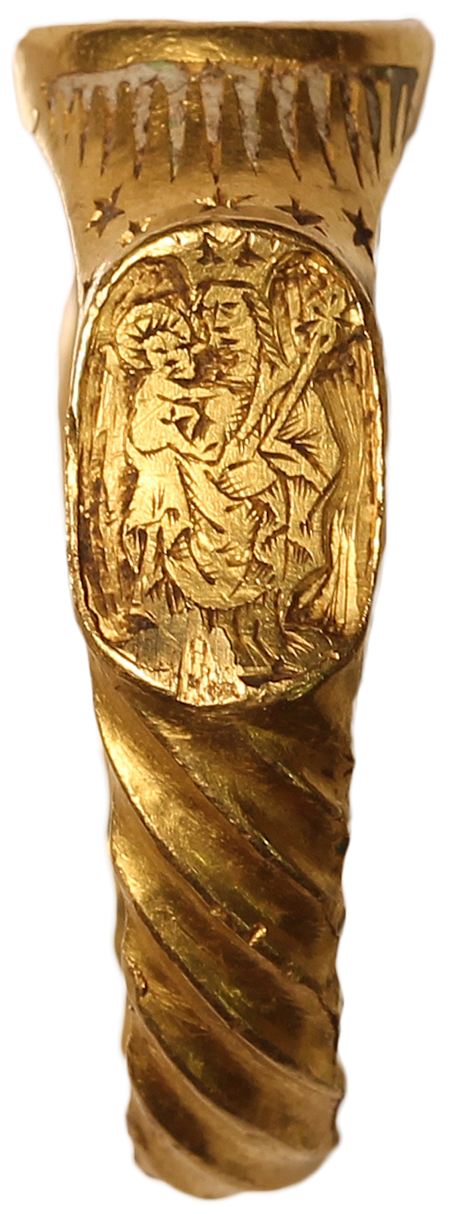
On the side faces are depictions of the Madonna and Child.
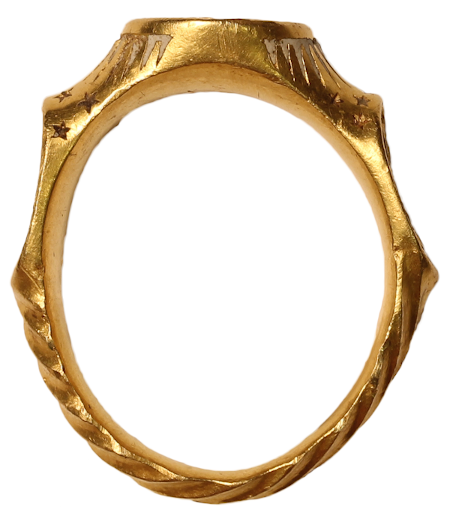
| ≡ | ⇧ |
Odd notes
- Beheading
- The shock of having your cervical cord severed is almost certain to kill you instantly but, if it doesn't:
- you may faint very quickly through loss of blood
- your eyes may see, your ears may hear, your lips may move (although no sound would be uttered)
- you may feel severe pain until your brain is starved of oxygen and that may take several seconds.
- Tudor websites
- The Anne Boleyn Files - by Claire Ridgway
- On the Tudor Trail - by Natale Grueninger
- Tudor History
- The Tudor Society
- Tudor Times
- Tudors Dynasty
- Anne Boleyn
- Tudor Houses
| ≡ | ⇧ |
Contradictions
The Somerley portrait.
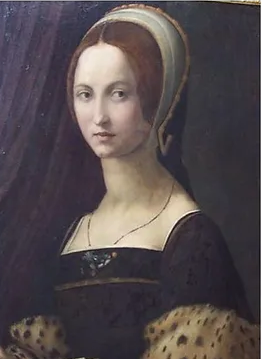
This picture, previously thought to be Anne Boleyn, is probably Mary Boleyn's daughter, Catherine Carey. She was thought to be Anne Boleyn because of:
- the likeness
- the French hood she is wearing
| ≡ | ⇧ |
Various Thomases
- Thomas Boleyn (b.1477, m.1500, d.12-Mar-1539).
- The ambitious father of Anne Boleyn
Thomas Boleyn was immensely wealthy but not terribly well connected until first his father and then he married particularly well.
(His father, William, married Margaret, daughter of Thomas Butler, Earl of Ormond, and he married Elizabeth, daughter of Thomas Howard, Earl of Surrey and 2nd Duke of Norfolk?).
He was a good diplomat and spoke excellent French.
- Thomas Wolsey (b.1473, d.29-Nov-1530).
- A Catholic bishop who became the King's almoner in 1509. He was also Archbishop of York and, in 1515, he was appointed Cardinal by Pope Leo X - he was then senior to all other English clergy.
He stopped Anne's betrothal to Lord Henry Percy in 1523 and she always hated him after that.
He ultimately became Lord Chancellor but he failed to negotiate the annulment of the King's marriage to Katherine of Aragón and therefore fell out of the King's favour. He died on his way to London to face charges of treason - although he hadn't done much more than fall out of favour.
- Thomas More (b.7-Feb-1478, d.6-Jul-1535).
- A lawyer, judge, philosopher, author, statesman, amateur theologian and Renaissance humanist. He was also Lord High Chancellor from 1529-1532 having been brought in to replace Thomas Wolsey.
He was against:- the Reformation
- Martin Luther and William Tyndale
- the separation from the Catholic Church
- Henry as supreme head of the Church of England
- the annulment of his marriage to Katherine of Aragón
At his beheading he said "I die the King's good servant, and/but God's first".
- Thomas Cranmer (b.2-Jul-1489, d.21-Mar-1556).
- An ardent protestant reformer and Archbishop of Canterbury. He helped build the case for the annulment of Henry's marriage to Katherine of Aragón and he supported the principle of Royal Supremacy. He was responsible for the first English Bible so that every parishioner could woship in English. Under pressure, during the reign of Mary I, he recanted his Protestantism but she had him burned at the stake anyway on 21-Mar-1556. On the day of his execution, he withdrew his recantations and died a martyr.
- Thomas Cromwell (b.1485, d.28-Jul-1540).
- A powerful proponent of the Reformation and therefore, initially, a friend of Anne's but latterly they fell out as he wanted the money from the Dissolution of the Monasteries to go to the King; she wanted it spent on education and the poor. He became a conspirator who engineered Anne's downfall.
But he too was executed on 28-Jul-1540 for organising the fateful marriage of Henry to Anna of Cleves.
The Elder
He was one of Anne's admirers. It is often claimed that he had an affair with Anne and he was arrested and put in the Tower in May 1536 but he was never charged and later released.
The Younger.
He was beheaded on 11-Apr-1554 and his head and limbs were put on public display.
| ≡ | ⇧ |
Various Marys
- Mary1 (Rose) Tudor (b.1496, d.1533).
- The younger sister of Henry VIII married King Louis XII of France but. three months after the marriage, Louis died and Mary married Charles Brandon, 1st Duke of Suffolk against the King's wishes. The King find them £24,000. She got the Sweats in 1528 and died in 1533.
- Mary Boleyn2 (b.1500, d.1543).
- The eldest daughter of Thomas and Elizabeth Boleyn. She married William Carey in 1520 but became the King's mistress after that. Carey died of the Sweats in 1528 and Mary married William Stafford in 1534. Both the King and Anne objected to her marrying beneath her station (to a soldier) and she was banished from court. She lived on relative obscurity and died at Rochford Hall in 1543.
- Mary of Guise3 (b.1515, d.1560).
- Wife of James V of Scotland and mother of Mary Queen of Scots.
- Bloody Mary4 (b.1516, d.1558).
- Mary I of England, daughter of Henry VIII and Katherine of Aragón. She married King Philip II of Spain and reigned from 1553-1558 and had a huge number of Protestants executed - hence the nickname.
- Mary Queen of Scots5 (b.1542, d.1587).
- Daughter of King James V of Scotland and mother of James VI of Scotland who became James I of England.
- Mary Seymour6 (b.1548, d.?).
- Daughter of Kateryn Parr and Thomas Seymour whom she married after Henry VIII died in 1547.
| ≡ | ⇧ |
The Thirty Nine Articles
The Thirty Nine Articles set out the historically defining statements of doctrines and practices of the Church of England.
Ten Articles were drafted in 1536 and showed slight leanings towards the Protestant faith;
Six Articles of 1539 swung away from all reformed positions;
the King's Book in 1843 re-established most of the previous Catholic doctrines;
Forty Two Articles, written in 1553 by Thomas Cranmer, reached the peak of Calvinist thought but which were not implemented as Edward VI died; and, finally,
Thirty Nine Articles were initiated by the Convocation of 1563 when Elizabeth I was crowned.
The Articles were finalised in 1571 and incorporated into the Book of Common Prayer.
| ≡ | ⇧ |
f:\iOpener\_anne_boleyn\anne_boleyn.htm
Remote file:
/storage/emulated/0/_anne_boleyn/anne boleyn.htm
22 Aug 2024, 09:30